7.13: 17th century- Baroque (II)
- Page ID
- 73312
Dutch Republic
A prosperous middle class eager to express its status and its new sense of national pride, replaced the church and monarchy as the primary patrons of art.
1600 - 1700
Frans Hals
Frans Hals, Singing Boy with Flute
by DR. STEVEN ZUCKER and DR. BETH HARRIS
Video \(\PageIndex{1}\): Frans Hals, Singing Boy with Flute, c. 1623, oil on canvas, 68.8 x 55.2 cm (Gemäldegalerie, Staatliche Museen zu Berlin)
Smarthistory images for teaching and learning:

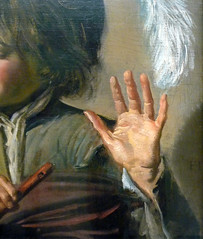
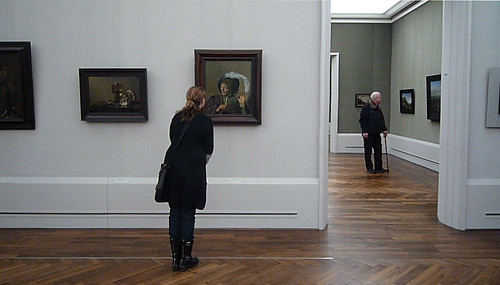
Frans Hals, Malle Babbe
by DR. STEVEN ZUCKER and DR. BETH HARRIS
Video \(\PageIndex{2}\): Frans Hals, Malle Babbe, c. 1633, oil on canvas, 78.50 x 66.20 cm (Gemäldegalerie, Staatliche Museen zu Berlin)
Smarthistory images for teaching and learning:
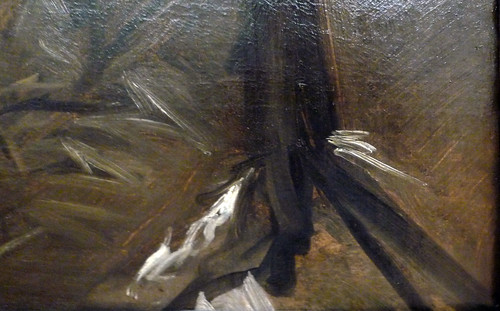


Frans Hals, The Women Regents
by OLIVIA NICOLE MILLER
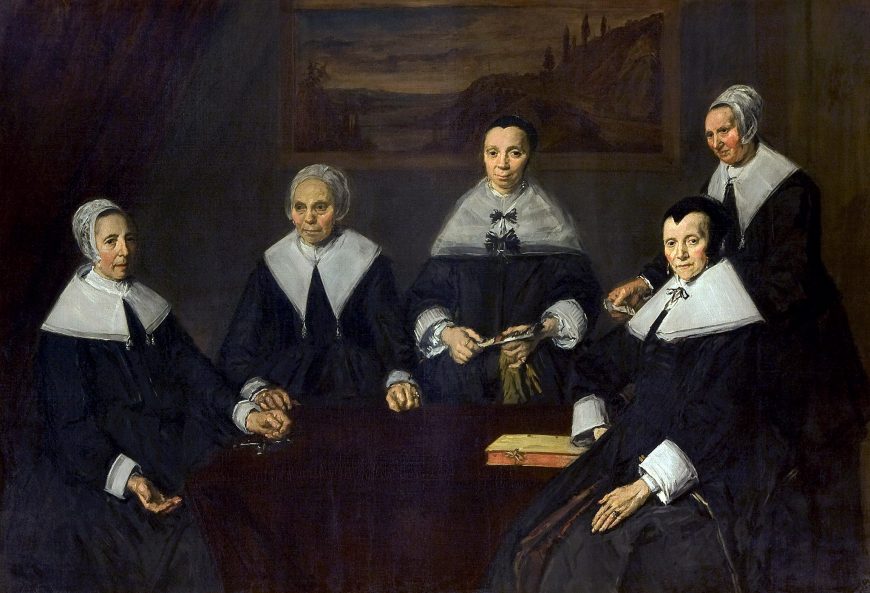
“[He] excels almost everyone with the superb and uncommon manner of painting which is uniquely his …. [His portraits] are colored in such a way that they seem to live and breathe.”—Theodor Schrevelius (1572-1649)

Haarlem was a prominent city in the seventeenth-century Netherlands and a leading center for the Golden Age of Dutch art. Still life, landscape, and genre painting were wildly popular, but there was also a surge in portrait commissions due to the newfound wealth of the many merchants who flocked to this area. As one of the foremost painters of this period, Frans Hals received many portrait commissions—especially from the Haarlem elite who sought to preserve their likeness and demonstrate their status. Hals’s painterly approach to art set him apart from his contemporaries; there is a looseness in his brushwork and liveliness in his sitters that is unique.
For the open market (in other words, not commissioned works), Hals created portraits of the common members of society including children, drunkards, and musicians—most are depicted smiling or laughing (far removed from the more reserved representations of the elite).
Depicting these marginal figures allowed Hals the freedom to experiment with facial expressions while still maintaining each figure’s individuality (above and below left). Hals received many commissions from wealthy individuals, but also made a name for himself with his group portraits. Some of these prestigious commissions were for guilds (associations of craftsmen or merchants) or civic guards, while others, such as The Women Regents (top of page) were for charitable groups.
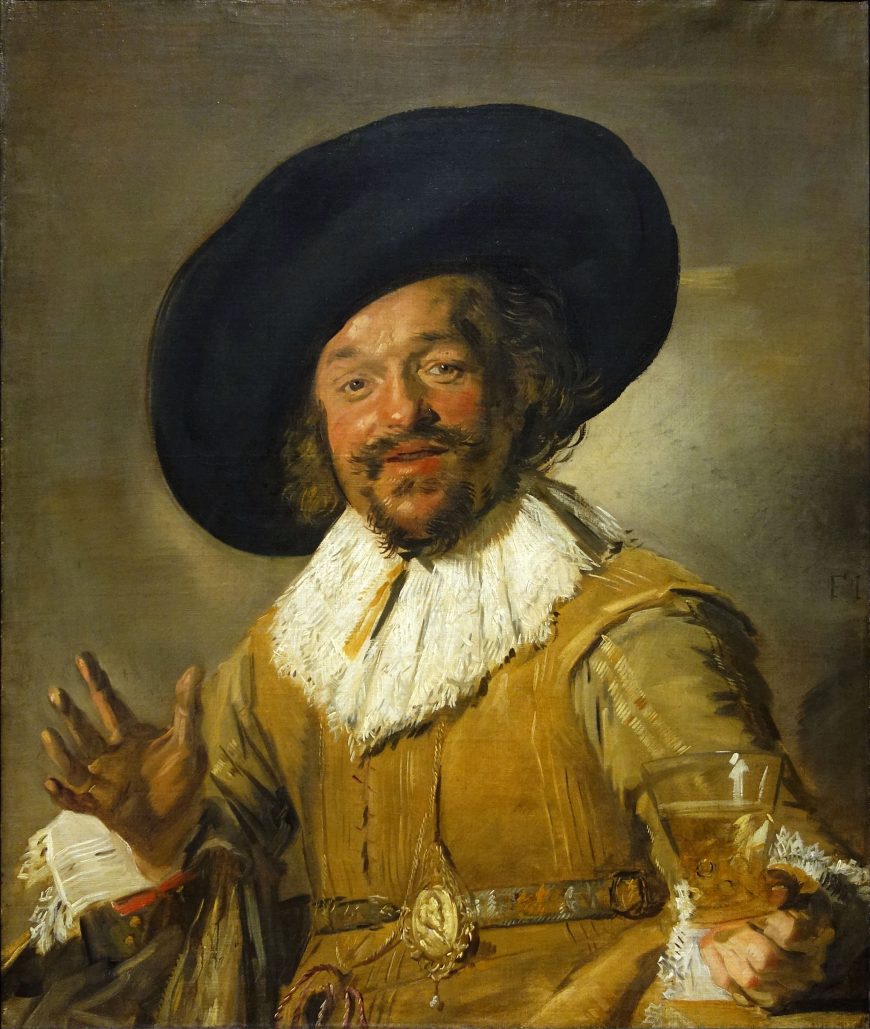
Group portraits such as these were typically displayed in a public space where the sitters’ status and good deeds could be recognized. Founded in 1609, the Old Men’s Almshouse (Oude Mannenhuis) was governed by a board of regents and provided shelter and care for elderly single men. This portrait, along with its companion painting depicting the male regents (below), was likely made in 1664, when Hals was 81 or 82 years old. In The Women Regents five women are clustered around a table in the immediate foreground. The painting is somber—dominated by blacks and grays that are punctuated by the white collars of the women’s clothes. Depicted in traditional Calvinist clothing, the women are not only representing their caretaking profession, but also the dominant religion of the Dutch Republic.
The women are quiet and austere. Perhaps they are weary from their responsibility in caring for the elderly poor, or perhaps they are simply serious about their task of governing the almshouse. Regardless, there is a dignity in the figures and a clear intention to individualize them, both through their likenesses and different poses.
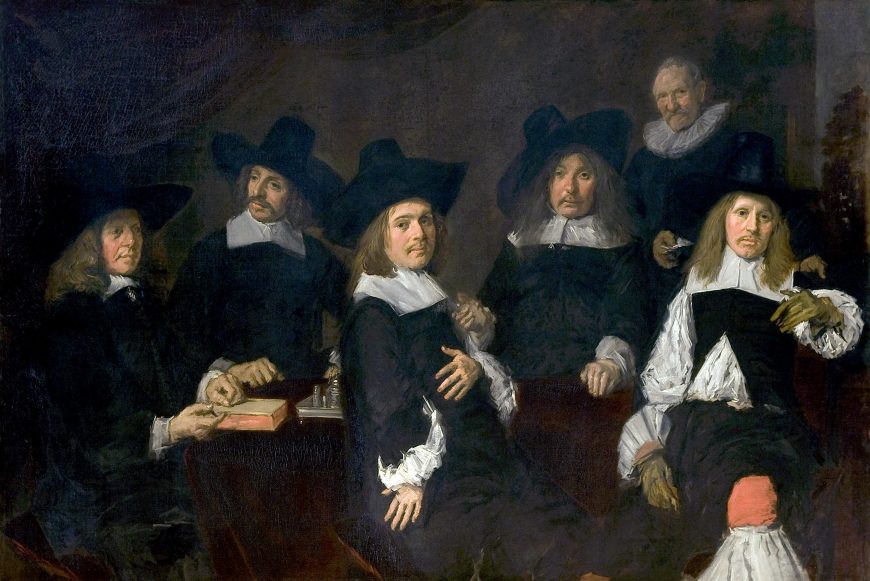
The background is simple; a landscape painting hangs on the wall behind the women and a large swath of drapery sweeps across the upper left corner. Although it is a stark contrast from Hals’s jovial militia banquet group portraits (below), there is still a sense of a captured moment in time. The women are posed and arranged so that the viewer has a full view of each of them. A few of them are in mid-pose—one even appears to have just entered the scene from the right. Only three stare out at the viewer. Textured brushwork combined with the repetitive triangular shapes of the women’s bodies and their collars provide a sense of movement. While this painting is a stark contrast from his earlier jovial portraits of individuals, The Women Regents still embodies Hals’ penchant for expressive and textured brushwork. This technique is especially evident in the cuffs of the central standing figure where the brushstrokes simultaneously retain their painterly quality and give the illusion of texture. The cuffs are rendered with a series of quick lines encircling the woman’s wrists, yet from afar the paint strokes blend together, alluding to the qualities of a stiff, pleated fabric. Overall, the scene is still; however, through his virtuosity in brushwork, Hals has bestowed it with a sense of life, as if this painting represents these women in a specific moment in time.
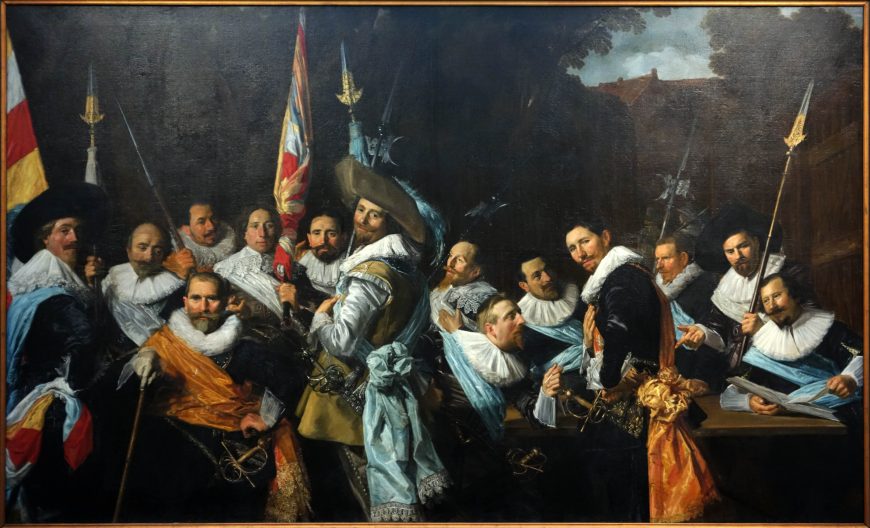
There is scant information about Hals’s early life and upbringing. He was born in Antwerp, but moved to Haarlem as a child where he spent the entirety of this life. The first significant recorded moment of his artistic career is when he joined the painters’ guild of St. Luke in Haarlem in 1610, however there is little reliable information regarding his artistic training. Unfortunately he suffered financial obstacles throughout his life and was forced to sell many of his paintings and personal goods in order to repay debts and care for his many children. Although Hals died in relative poverty, his influence was significant. Judith Leyster employed Hal’s loose handling of paint and sense of the moment in her own portraits, and centuries later the Impressionists admired his brushwork.
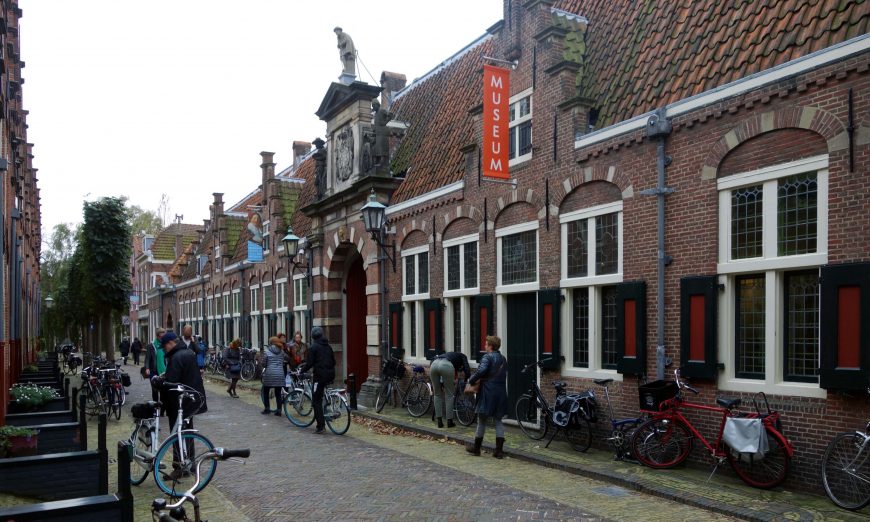
Today visitors can see The Women Regents and many other Hals paintings at the Frans Hals Museum in Haarlem (above), which just so happens to be in the building of the former Old Men’s Almshouse.
Additional Resources:
Hals on The Metropolitan Museum of Art’s Heilbrunn Timeline of Art History
Christopher Atkins, The Signature Style of Frans Hals: Painting, Subjectivity, and the Market in Early Modernity (Amsterdam: Amsterdam University Press, 2011).
Calvinism and Religious Toleration in the Dutch Golden Age. Edited by R. Po-Chia Hsia and Henk F. K. van Nierop. (New York: Cambridge University Press. 2002).
Walter Liedtke, Frans Hals: Style and Substance (New York: Metropolitan Museum of Art, 2011).
Rembrandt
Rembrandt, The Anatomy Lesson of Dr. Tulp
Video \(\PageIndex{3}\): Rembrandt van Rijn, The Anatomy Lesson of Dr. Nicolaes Tulp, 1632, oil on canvas, 169.5 x 216.5 cm, (Mauritshuis, Den Haag)
A prolific career

It would be difficult to overestimate the importance of Rembrandt Harmenszoon van Rijn within the history of Western art. Indeed, Rembrandt is considered one of the foremost artists of the Dutch Baroque period, and even if he had never picked up a paintbrush, he would have been famous both in his day and ours as a printmaker of particular brilliance and as a prolific teacher. In a career that lasted nearly forty years, Rembrandt completed approximately 400 paintings, more than 1,000 drawings, and nearly 300 engravings. Although he spent his entire life north of the alps, had he been Italian and lived a century or so earlier, he likely would have joined his Italian brethren—Donatello, Leonardo, Michelangelo, and Raphael, as a member of the famed cartoon Teenage Mutant Ninja Turtles.
Patrons: A wealthy, Protestant, and expanding middle class
But as time and place would have it, Rembrandt was neither Italian nor a part of the Renaissance. Instead, Rembrandt was born in Leiden in 1606. This place and time—Holland during the height of the expansion of the wealthy mercantile class during the middle half of the seventeenth century—served Rembrandt well through his long career. The Catholic Church often commissioned Italian artists at this time to undertake large-scale projects to promote religious ideology in support of the Counter-Reformation. Without the Catholic Church in Holland to commission art, Rembrandt and his fellow Dutch artists were lavishly supported by a wealthy, Protestant, and expanding middle class. This group of patrons enthusiastically commissioned works of art with their increasing discretionary income.
New subjects (including group portraits)
Many different types of art became popular during the Dutch Baroque period. Genre paintings—small paintings of everyday life—were exceptionally popular with a middle-class clientele, as were still lifes, landscapes, and prints. The majority of these kinds of art were both affordable and small enough to be easily displayed within an average home. Larger and more compositionally complicated, group portraiture also became popular in Holland during the seventeenth century. This was a mode of painting that was often placed in a public space so that the image could promote a particular organization.
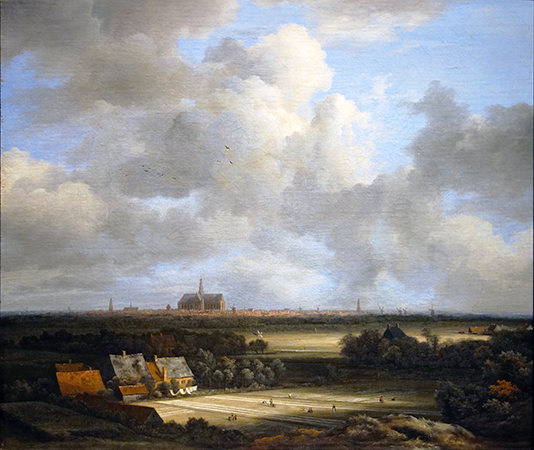
Relocating to Amsterdam
Although several of Rembrandt’s most well-known paintings are group portraits—The Anatomy Lesson of Dr. Tulp among others—his early education in Leiden, first at a Latin school and then later at the university, suggest that he was destined for a vocation other than art. However, by the time he was sixteen he decided he wanted to be a painter and a draughtsman. After finding quick success in Leiden during the 1620s, Rembrandt relocated to Amsterdam in 1631, a wise professional decision, as this was then one of the wealthiest and largest cities in Europe.

A group portrait for the Amsterdam Surgeon’s Guild
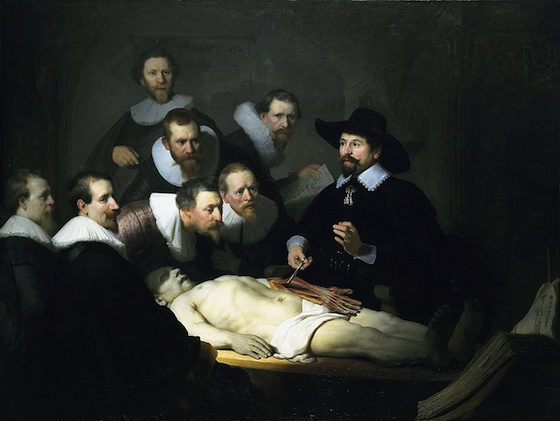
Just a year after his arrival, Rembrandt was offered the commission to complete a group portrait of the Amsterdam Surgeon’s Guild, an image that in time has come to be known rather simply as The Anatomy Lesson of Dr. Tulp. It is remarkable that Rembrandt received this commission as a newcomer to Amsterdam when there were other native-born artists available. Thomas de Keyser (above) and Nicolaes Pickenoy (below), for example, were older and more experienced in the realm of group portraiture. Whereas another artist may have simply recreated a previous group image—inserting new heads in place of old ones—Rembrandt created something new, and in doing so, completed one of the most recognizable images in the history of painting.
Dr. Nicolaes Tulp
Dr. Nicolaes Tulp was appointed praelector (like a professor or lecturer) of the Amsterdam Anatomy Guild in 1628. One of the responsibilities of this position was to deliver a yearly public lecture on some aspect of human anatomy. The lecture in 1632 occurred on 16 January, and this is the scene that Rembrandt depicts in paint in The Anatomy of Lesson of Dr. Tulp.
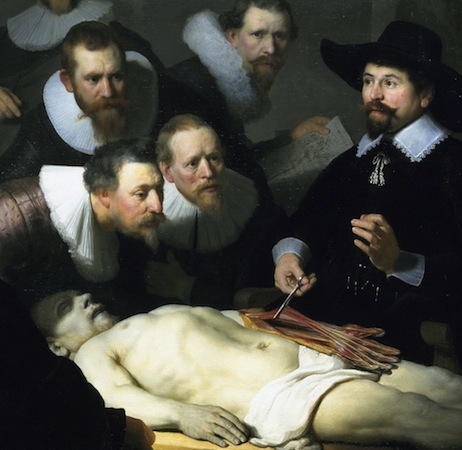
This is a more complicated composition than it at first appears. Understandably, the focal point of the image is Dr. Tulp, the doctor who is shown displaying the flexors of the cadaver’s left arm. Rembrandt notes the doctor’s significance by showing him as the only person who wears a hat. Seven colleagues surround Dr. Tulp, and they look in a variety of directions—some gaze at the cadaver, some stare at the lecturer, and some peek directly at the viewer. Each face displays a facial expression that is deeply personal and psychological. The cadaver—a recently executed thief named Adriaen Adriaenszoon—lies nearly parallel to the picture plane. Viewing the illuminated body from his head to his feet brings into focus a book—likely Andreas Vesalius’s De humani corporis fabrica (Fabric of the Human Body, 1543)—propped up in the lower right corner. In all, Rembrandt shows nine distinct figures, but does so as if they are a unified group.
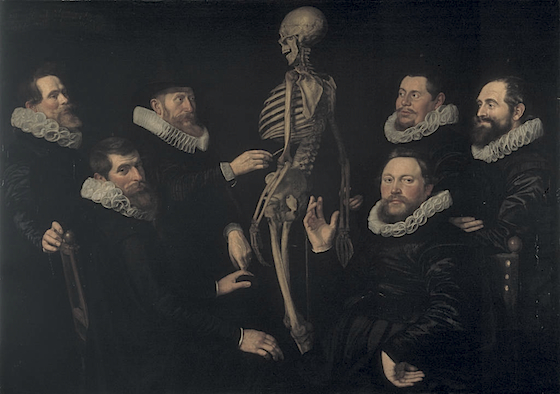
A comparison
Comparing The Anatomy Lesson of Dr. Tulp to a somewhat similar example, The Osteology Lesson of Dr. Sebastiaen Egbertszoon, shows just how different and novel Rembrandt’s composition was at the time. The Sebastiaen Erbertszoon painting is a series of six portraits that surround a single human skeleton; but neither the heads nor the bodies seem to interact with one another in a real or coherent way. In contrast, the figures in Rembrandt’s Tulp seem to truly be a group, one collection of nine rather than nine individuals.
If the composition is different from what Rembrandt might have seen in Amsterdam, the choice of subject is different than what would have been expected in the parts of Europe that were Catholic. The Catholic tenet of resurrection necessitated that dead bodies be interred in a state of wholeness, and this fact explains why Leonardo was forced to dissect human bodies in secret. In Protestant Holland but 113 years after Leonardo’s death, however, human dissections were not only common practice, they were often public spectacles, complete with food and wine, music and conversation.

Artistic license
If Rembrandt was able to create a truly group portrait—one of a single group rather than a collection of individuals—it is important to note that the artist took some understandable artistic license with some parts of the composition. As any anatomy and physiology student today can attest, a dissection of the human body almost always commences with an exploration of the chest and abdominal areas, parts of the human body most likely to decompose first, and only later does the procedure move onwards to the limbs. Moreover, it would have been unlikely that a doctor of Tulp’s importance would have actually dissected the body; instead, he would have lectured while the menial task of exposing the inner workings of the body would have been left to others. But in paint, a format without sound, Rembrandt put Tulp in charge not only in costume, but also in action.

As the prominent signature in the upper part of the painting indicates, Rembrandt was justifiably proud of this large painting.
Whereas he had previously signed his works with his monogram RHL (Rembrandt Harmenszoon of Leiden), The Anatomy Lesson of Dr. Tulp contains Rembrant. f[ecit] 1632. This painting and the Latin announcement that “Rembrandt made it” marks the beginning of the painter’s mature career.

Daring, compositionally innovative, and deeply psychological, The Anatomy Lesson of Dr. Tulp launched Rembrandt to fame and wealth and influenced generations of artists to come. Indeed, without Tulp, it seems impossible for Thomas Eakins to have painted The Gross Clinic, 1876 almost two and a half centuries later.
Additional resources:
This painting at the Mauritshuis
Dolores Mitchell. “Rembrandt’s “The Anatomy Lesson of Dr. Tulp”: A Sinner among the Righteous,” Artibus et Historiae, Vol. 15, No. 30 (Nov 1994), p. 145 – 156
Aloïs Riegl and Benjamin Binstock. “Excertps from “The Dutch Group Portrait”,” October, Vol. 74, (Autumn 1995), p. 3 – 35
Smarthistory images for teaching and learning:
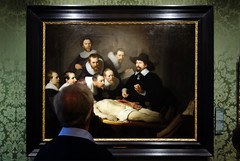

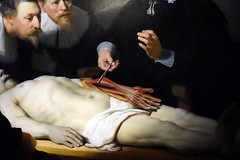
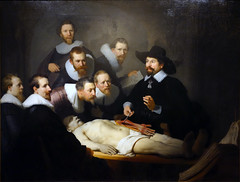


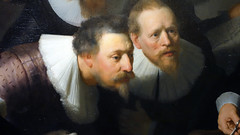
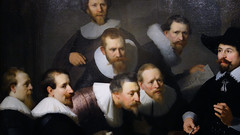

Rembrandt, The Night Watch
by DR. WENDY SCHALLER
Video \(\PageIndex{4}\): Rembrandt van Rijn, The Night Watch (Militia Company of District II under the Command of Captain Frans Banninck Cocq), 1642, oil on canvas, 379.5 x 453.5 cm (Rijksmuseum, Amsterdam)
A night watch?
Would it surprise you to find that the title that Rembrandt’s most famous painting is known by is actually incorrect? The so-called Night Watch is not a night scene at all; it actually takes place during the day. This title, which was not given by the artist, was first applied at the end of the eighteenth century. By that time the painting had darkened considerably through the accumulation of many layers of dirt and varnish, giving the appearance that the event takes place at night.


The Dutch civic guard
Rembrandt’s Night Watch is an example of a very specific type of painting that was exclusive to the Northern Netherlands, with the majority being commissioned in the city of Amsterdam. It is a group portrait of a company of civic guardsmen. The primary purpose of these guardsmen was to serve as defenders of their cities. As such, they were tasked with guarding gates, policing streets, putting out fires, and generally maintaining order throughout the city. Additionally, they were an important presence at parades held for visiting royalty as well and other festive occasions.
Each company had its own guild hall as well as a shooting range where they could practice with the specific weapon associated with their group, either a longbow, a crossbow, or a firearm. According to tradition, these assembly halls were decorated with group portraits of its most distinguished members, which served not only to record the likenesses of these citizens, but more importantly to assert the power and individuality of the city that they defended. In short, these images helped promote a sense of pride and civic duty.

Rembrandt was at the height of his career when he received the commission to paint the Night Watch for the Kloveniersdoelen, the guild hall that housed the Amsterdam civic guard company of arquebusiers, or musketeers.
This company was under the command of Captain Frans Banning Cocq, who holds a prominent position in the center foreground of the image (above left). He wears the formal black attire and white lace collar of the upper class, accented by a bold red sash across his chest. At his waist is a rapier and in his hand a baton, the latter of which identifies his military rank. Striding forward, he turns his head to the left and emphatically extends his free hand as he addresses his lieutenant, Willem van Ruytenburgh, who turns to acknowledge his orders. He is also fancifully dressed, but in bright yellow, his military role referenced by the steel gorget he wears around his neck and the strongly foreshortened ceremonial partisan that he carries.
Sixteen additional portraits of members of this company are also included, with the names of all inscribed on a framed shield in the archway. As was common practice at the time, sitters paid a fee that was based on their prominence within the painting.


A unique approach
Compared to other civic guard portraits, Rembrandt’s Night Watch stands out significantly in terms of its originality. Rather than replicating the typical arrangement of boring rows of figures (see above), Rembrandt animates his portrait. Sitters perform specific actions that define their roles as militiamen.
A great deal of energy is generated as these citizens spring to action in response to their captain’s command. Indeed, the scene has the appearance of an actual historical event taking place although what we are truly witnessing is the creative genius of Rembrandt at work.
Men wearing bits of armor and varied helmets, arm themselves with an array of weapons before a massive, but imaginary archway that acts as a symbol of the city gate to be defended. On the left, the standard bearer raises the troop banner while on the far right a group of men hold their pikes high.
In the left foreground, a young boy carrying a powder horn dashes off to collect more powder for the musketeers. Opposite him, a drummer taps out a cadence while a dog barks enthusiastically at his feet.

In addition to the eighteen paid portraits, Rembrandt introduced a number of extras to further animate the scene and allude to the much larger makeup of the company as a whole. Most of these figures are relegated to the background with their faces obscured or only partly visible. One, wearing a beret and peering up from behind the helmeted figure standing next to the standard bearer has even been identified as Rembrandt himself.
Three musketeers
While a number of different weapons are included in the painting, the most prominent weapon is the musket, the official weapon of the Kloveniers. Three of the five musketeers are given a place of significance just behind the captain and lieutenant where they carry out in sequential order the basic steps involved in properly handling a musket. First, on the left, a musketeer dressed all in red, charges his weapon by pouring powder into the muzzle. Next, a rather small figure wearing a helmet adorned with oak leaves fires his weapon to the right. Finally, the man behind the lieutenant clears the pan by blowing off the residual powder (both the figure in a helmet with oak leaves and the man blowing off the powder are visible in the detail of the central figures above). In his rendering of these steps, it seems that Rembrandt was influenced by weapons manuals of the period.

A golden girl
Probably the most unusual feature is the mysterious girl who emerges from the darkness just behind the musketeer in red. With flowing blond hair and a fanciful gold dress, the young girl in all her brilliance draws considerable attention. Her most curious attribute, however, is the large white chicken that hangs upside down from her waistband.
The significance of this bird, particularly its claws, lies in its direct reference to the Kloveniers. Each guild had its own emblem and for the Kloveniers it was a golden claw on a blue field. The girl then is not a real person, but acts as a personification of the company.
Additional resources:
This painting at the Rijksmuseum, Amsterdam
Rembrandt’s paintings on The Metropolitan Museum of Art’s Heilbrunn Timeline of Art History
Smarthistory images for teaching and learning:

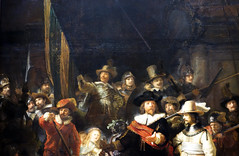

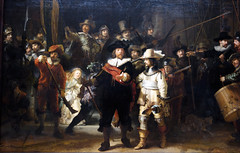
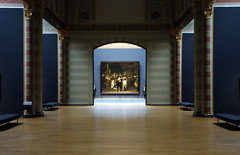
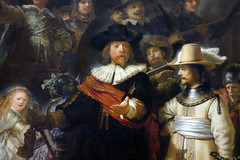
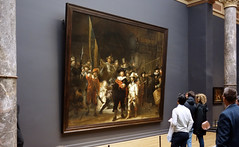
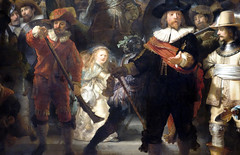
Rembrandt, Self-Portrait with Saskia
by DR. WENDY SCHALLER

A theatrical flair
In an age of cinematic super heroes and role-playing games, who hasn’t imagined themselves at one time in their life as something other than what they were? The seventeenth-century Dutch artist Rembrandt van Rijn certainly did. In his 1636 etching, Self-Portrait with Saskia, both he and his wife are shown wearing historical clothing. Rembrandt wears a fanciful 16th-century style plumed beret tilted at a jaunty angle and a fur-trimmed overcoat, while Saskia wears an old-fashioned veil. Such play-acting was not unusual for Rembrandt who only twice represented himself in the manner that was most popular at the time, as a contemporary Amsterdam gentleman.
Whether painting, etching or drawing, Rembrandt, who produced more self-portraits than any artist before him (roughly 75), preferred to show himself in a variety of different imagined roles. You can see him as a soldier in old-fashioned armor, a ragged beggar, a stylish Renaissance courtier, an exotically clad Oriental leader and even Saint Paul.
More than a self-portrait
In addition to serving as one of many self-portraits, this small etching can also be regarded as an example of a marriage portrait. The young woman shown seated at the table with the 30 year old Rembrandt is his wife, Saskia van Uylenburgh. Rembrandt most likely met Saskia while working for her cousin, Hendrick Uylenburgh, an art dealer who had a workshop in Amsterdam. The two married on June 22, 1634 and remained together for thirteen years until Saskia’s untimely death at the age of 30. Surprisingly, it is the only etching that Rembrandt ever made of Saskia and himself together.
The two figures are presented in half-length, seated around a table before a plain background. Rembrandt dominates the image as he engages the viewer with a serious expression. The brim of his hat casts a dark shadow over his eyes, which adds an air of mystery to his countenance. Saskia, rendered on a smaller scale and appearing rather self-absorbed, sits behind him. It’s almost as if we have interrupted the couple as they enjoy a quiet moment in their daily life.

Rembrandt, however, has transformed the traditional marriage portrait into something more inventive. This etching marks the first time that Rembrandt has presented himself as an artist at work. In his left hand he holds a porte-crayon (a two-ended chalk holder) and appears to have been drawing on the sheet of paper before him. By identifying himself as a draftsman, Rembrandt draws attention to his mastery of what was regarded as the most important basic skill of an artist.
Is he drawing Saskia or is she simply there to support and inspire her husband as he works? While the marks on his paper don’t provide conclusive evidence of his subject, it certainly was not unusual for Rembrandt to use his wife as a model. In the years that they were married, she would sit for her husband on numerous occasions.
The etching process
Etching is a printmaking process in which a metal plate (usually copper) is coated with a waxy, acid-resistant material. The artist draws through this ground with an etching needle to expose the metal. The plate is then dipped in acid, which “bites” into the exposed metal leaving behind lines in the plate. By controlling the amount of time the acid stays on the plate, the artist can make shallow, fine lines or deep, heavy ones. After the coating is removed, the plate is inked then put through a high-pressure printing press together with a sheet of paper to make the print. Typically, an artist can produce about 100 excellent impressions from a single plate.
Rembrandt as etcher
Rembrandt is regarded as the greatest practitioner of etching in the history of art and the first to popularize this technique as a major form of artistic expression. His work in this medium spans nearly his entire career with nearly 300 etchings to his name. We see a lot of variety in these works as he renders all manner of subjects popular at the time including history, landscapes, still life, nudes, and everyday life, in addition to portraits.
Typically, Rembrandt used a soft ground that would allow him to “draw” freely on his plate (most early etchers used a hard ground), and many of his early etchings have the immediacy and spontaneity of a rapid sketch. In fact, most evidence suggests that he worked directly on the plate, most likely with a preparatory drawing in front of him to serve as a guide. As with his painted works, he developed a very individualized style that clearly set him apart from his contemporaries. His highly experimental nature led him to explore the effects of using different types, weights, and colors of paper for printing his works.

Rembrandt is also known for his practice of varying the degree to which he etched a plate, an approach seen here. The figure of Rembrandt is more deeply bitten than that of Saskia, a technique that not only suggests that the artist is closer to us, but also places greater emphasis on him. The figure of Saskia, on the other hand, is more lightly etched, with the effect that she is seated farther away and plays a less important role. These differences have led some to suggest that Rembrandt may have etched Saskia first, and then added himself in the front. This notion is supported by the lines of her dress which appear to continue under his overcoat.
Another thing that makes Rembrandt stand out among his contemporaries is that he often created multiple states of a single image. This etching, for example, exists in three states. By reworking his plates he was able to experiment with ways to improve and extend the expressive power of his images.
Additional resources:
This print at the Fitzwilliam Museum
Rembrandt: Prints on The Metropolitan Museum of Art’s Heilbrunn Timeline of Art History
Introduction to intaglio printmaking (MoMA video)
Intaglio process (MoMA video)
Rembrandt, Girl at a Window

A Trick of the Eye
In Girl at a Window we see a young woman, possibly a servant girl, leaning on a stone ledge. She wears a loose-fitting white blouse, fastened with gold braid, her flowing curls crowned by a red cap. She has a rosy complexion, and the paint has been applied with thickly impastoed (thickly applied) paint. She inhabits a dark, ambiguous space, and it is unclear where she is located. What is most striking about the picture, however, is her very direct gaze. She looks straight at the viewer, drawing them into the picture; a fact underlined by the gesture she makes with her left hand, pointing towards herself.
Rembrandt’s painting belongs to a type of picture made popular in the 16th and 17th centuries, in which the sitter appears to be entering the realm of the viewer—by leaning out of a window, reaching out a hand, leaning on a picture frame, drawing aside a curtain or stepping forward. Rembrandt and his pupils became particularly intrigued by the possibilities of trompe l’oeil (literally meaning to “deceive the eye”) in the 1640s (Girl at a Window is dated 1645). Another particularly arresting example of this technique is his Girl in a Picture Frame (below), in which Rembrandt plays on the division between reality and the illusion of the painting.

According to the 18th century French art theorist Roger de Piles, who was also an early owner of Girl at a Window, Rembrandt placed the Dulwich painting behind one of the windows in his house and for a few days passers-by mistook her for a real girl. This anecdote has since been disproven; however, its message echoes the story of Zeuxis and Parrhasius—two Greek painters who staged a contest to determine who was the greater artist. Zeuxis painted a picture of a child carrying grapes and the picture was so realistic that birds were fooled into eating the grapes. Yet, when Parrhasius asked Zeuxis to draw back a curtain to reveal his own painting he realized to his humiliation that the curtain was an illusion; at this point Zeuxis conceded that Parrhasius was the better painter. The significance of this story is to suggest that a good artist can paint realistic animals or objects but only a great artist, like Parrhasius or Rembrandt, can deceive people (or indeed other artists).
Numerous attempts have been made to interpret the subject of Girl at a Window and the identity of its sitter. Hendrickje Stoffels, Rembrandt’s longtime lover after the death of his first wife Saskia has been suggested as a possible model. Yet Hendrickje would have been 19 in 1645—perhaps too old to be the girl depicted. It has been suggested that the girl may represent a biblical or allegorical figure, perhaps an Old Testament heroine. Her white blouse, with its gold braid, is not the typical attire for a servant and is more likely a kind of fantasy clothing, similar to that worn by other figures in Rembrandt’s history paintings. This type of clothing gives the figure a romantic and timeless quality, suggestive of the past (even if not historically accurate).

During the recent conservation of this painting, the discolored varnish was carefully removed, revealing a bold mixture of colors in the model’s face. Rembrandt often applied his paint with palette knives as well as his fingers. The only surviving drawing for Girl at a Window (below) is drawn from life and sketched confidently using just a few expressive strokes of graphite. The differing position of the girl’s arms in the drawing indicates that the study does not derive from the painting but was in fact produced during its development.

Essay by Helen Hillyard, Assistant Curator at Dulwich Picture Gallery, London.
This essay was produced in conjunction with the Making Discoveries display series at Dulwich Picture Gallery, London. The displays coincide with the release of the Gallery’s Dutch and Flemish Schools Catalogue, published 2016, and aims to disseminate important findings from this major research project.
Rembrandt, Christ Crucified between the Two Thieves: The Three Crosses
Video \(\PageIndex{5}\): Rembrandt van Rijn, Christ Crucified between the Two Thieves: The Three Crosses, 1653, drypoint printed on vellum, sheet: 15 1/8 x 17 7/16 in. (38.4 x 44.3 cm) (The Metropolitan Museum of Art, New York). Video from The Metropolitan Museum of Art.
Additional resources:
Rembrandt, Aristotle with a Bust of Homer
Video \(\PageIndex{6}\): The conservator’s eye, Rembrandt van Rijn’s Aristotle with a Bust of Homer, 1653, oil on canvas, 56 1/2 x 53 3/4″ / 143.5 x 136.5 cm (The Metropolitan Museum of Art). Speakers: Jim Coddington and Beth Harris

What makes this painting so captivating?
In 1961, the Metropolitan Museum paid a staggering 2.3 million dollars to obtain a late work by Rembrandt van Rijn, the painting now called Aristotle with a Bust of Homer. At the time, it was the most money ever paid for an artwork. The painting had taken a circuitous route: from Rembrandt’s studio in Amsterdam to Sicily to London before crossing the Atlantic and finding its home in several private collections prior to auction. Its early travels are well documented, thanks to the survival of shipping manifests and correspondence. The painting now captivates visitors to The Met, as it has captivated generations of art historians who have argued over almost every aspect of the painting. What is it that makes this painting so compelling?
Identifying the subject
The most commonly accepted identification of the subject was first convincingly argued in 1969 by Julius Held and refined in the 2007 Metropolitan Museum catalog of Dutch paintings by Walter Liedtke. Based on a suggestion made by the Dutch art historian Abraham Bredius in the 1930s, Held argued persuasively for the identification of the subject as Aristotle contemplating a bust of the blind ancient Greek poet Homer (who lived some 400 years prior to Aristotle and who is credited as the author of the of the epic poems the Iliad and the Odyssey).
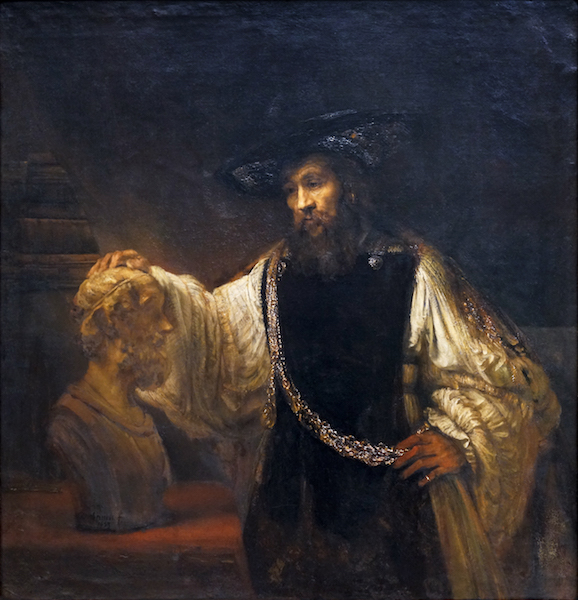
The identification as Aristotle is based on the facial features, long hair and beard, jewelry and elaborate dress. They are all comparable with other images of Aristotle produced in both paint and print in the sixteenth and seventeenth centuries in both northern and southern Europe. Aristotle was held in high regard not only as a poet and philosopher but also as an important commenter on Homer and the teacher of Alexander the Great. Alexander is said to have counted a volume of Homer’s works as one of his prized possessions.
At the time of The Met’s purchase, the subject of the painting was tentatively identified as Aristotle, but was not yet firmly established. This reflects the confusion also recorded in seventeenth-century sources. The painting was originally purchased (and possibly commissioned) by the Sicilian prince Don Antonio Ruffo for the hefty sum of 500 florins. Whether it was a commission or a purchase is unclear, as is exactly what Rembrandt was asked to provide. If it was a commission, the choice of subject must have been left to the painter since when it joined Don Ruffo’s collection it was described as Aristotle or Albertus Magnus (a thirteenth-century German philosopher). This suggests that even the first owner was uncertain of the subject and that decisions about content must have been made exclusively by Rembrandt.
The painting continued to be documented in numerous family inventories until the late eighteenth century. Over the years, it has been (mis)identified as “a philosopher,” Albertus Magnus, Tasso, Ariosto, Virgil and even the seventeenth-century Dutch poet Pieter Cornelisz Hooft.
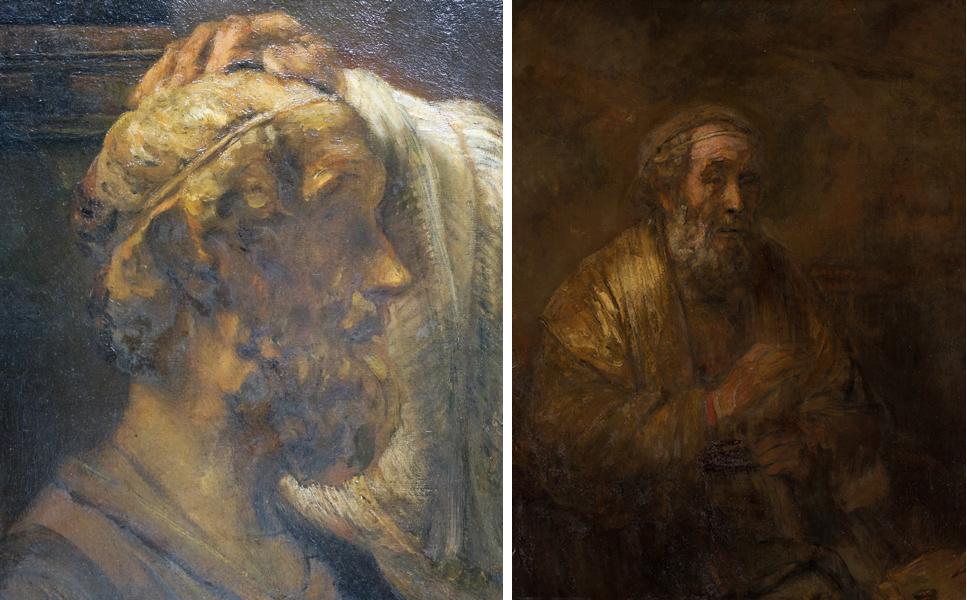
The identity of the sculpted bust in the composition was similarly unclear. It was sometimes vaguely identified as representing antiquity, and as an attribute of the central figure. That it was intended to represent Homer can be supported in several ways.
Almost ten years after his purchase of this painting, Ruffo would go on to commission two more paintings from Rembrandt: a representation of Homer (remnants now in the Mauritshuis) and one of Alexander (now lost). The Mauritshuis Homer fragment (above) shows the blind poet isolated, though in its original format it would have included the students to whom he was speaking. The living poet in this painting is virtually identical to the bust in Aristotle. The shape of the face, the framing of the sightless eyes, and the thin band across his forehead correspond with numerous prototypes and support the firm identification of the bust as Homer. Held has even related it to a specific Hellenistic bust type represented by an example in the Boston Museum of Fine Arts. Rembrandt himself owned a bust of Homer, as it appears in his 1656 bankruptcy inventory.
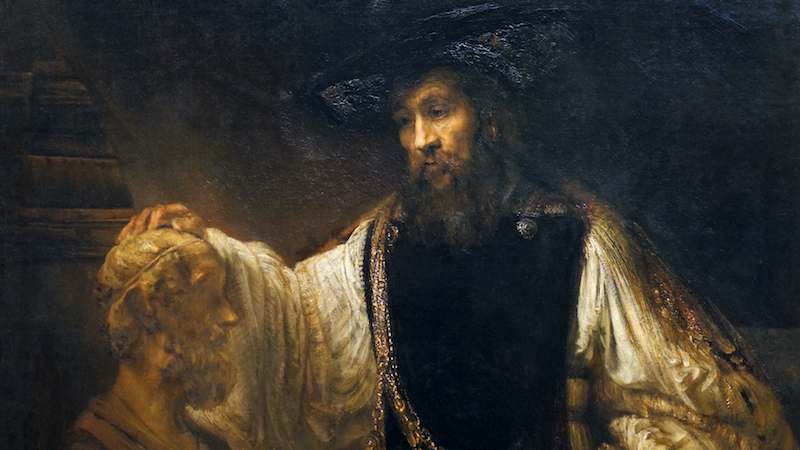
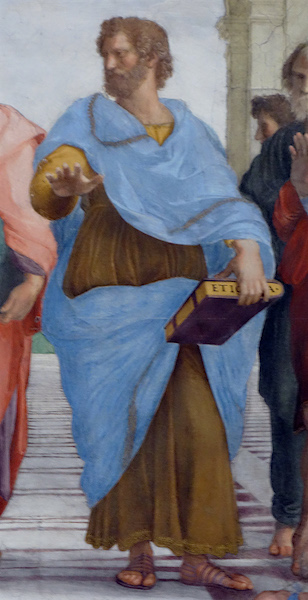
Aristotle
In the painting’s current state, Aristotle is depicted in three-quarter length. His right hand extends to rest on the sculpted bust placed on a table in front of a mountain of books partially hidden by a curtain, but he is not looking at the bust. His eyes are fixed on an invisible point outside the frame of the painting, his dark eyes and absent gaze contributing to a feeling of melancholy and detached reflection.
Held associated this melancholy with a passage from Plutarch which recounts that Aristotle had fallen out of favor with Alexander; Liedtke sees the melancholy as an appropriate attribute of a man of learning in the seventeenth century.
Aristotle’s clothes seem to belong to no particular period, and Rembrandt has eschewed a more traditional, toga-clad approach such as that found in Raphael’s School of Athens. Aristotle instead seems to wear an odd combination of a wide-brimmed hat, a white tunic, and a dark apron-like garment, adorned not only with a gold chain but earrings and a pinky ring. The bust itself is painted in such a warm tone that it seems almost more like flesh than stone, putting the venerable poet almost within reach. The two thinkers, living and sculpted, are linked not only by Aristotle’s gesture, but by the repeated arcs created by their clothing and accoutrements.
The brushwork
Like much of Rembrandt’s work from the last third of his life, Aristotle with a Bust of Homer uses the rich darkness of the background to set off the central figure, who is gently picked out from the darkness almost as if under a spotlight. Quick, vigorous brushwork creates the voluminous folds of Aristotle’s left sleeve; bright spots of white and light yellow crest to form the shimmering surfaces of the chain draped across his torso.
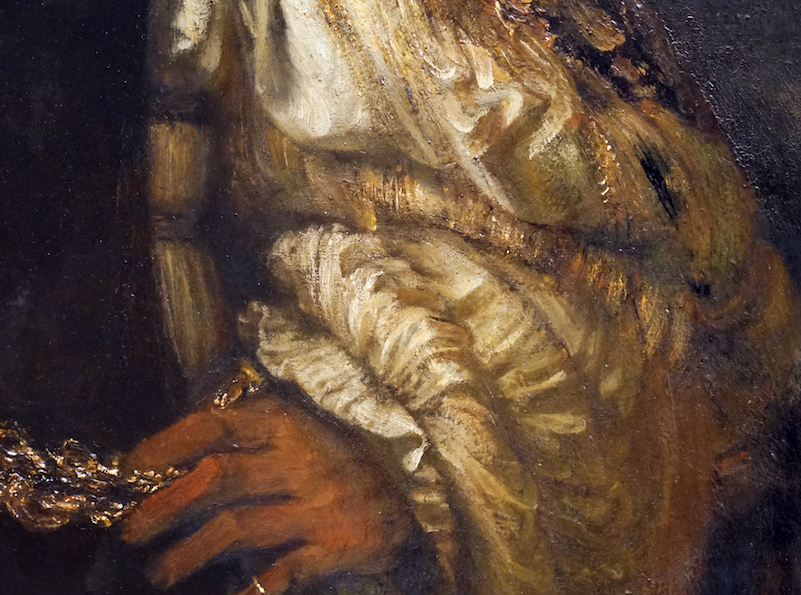
Though the crux of the painting is the interaction between bust and man, the highlights and surface texture carry our attention across Aristotle’s body to his left hand which, accented by a ring, rests on the chain at his hip. The background, by contrast, dissolves into obscure and ambiguous darkness, possibly enhanced over time.

Interpretations
Held proposed that here Aristotle ponders the temporality of worldly success as represented by the golden chain versus the more profound and lasting benefit of wisdom gained from art and literature embodied by Homer’s bust. In this sense, the formal repetition of the arc created by Aristotle’s chain and Homer’s sculpted clothing establishes the two figures as counterpoints.
Aristotle’s chain bears a medallion featuring a portrait of a man, possibly Alexander the Great. The gifting of gold chains was an ancient practice to recognize excellence and service, and had been revived in the early modern period. It is thus both an historical attribute of the figure and an easily recognizable token of honor for the contemporary viewer. The significance of the chain—both for the subject and in compositional terms—is further made evident through the care with which it was painted.
In the Poetics, Aristotle addresses, among other topics, how poetry, theater, and the arts are processes of mimesis, or imitation of the world. Through imitating the world in a new format, the poet or painter presents a new vision to the viewer and a new way of knowing the world. In selecting Aristotle as a subject, Rembrandt commemorated the role of vision—of painting itself—as a noble art.
Perhaps the appeal of the painting derives partly from the way the viewer is invited to participate and asked to contemplate a subject who, as Walter Liedtke wrote, is shown “not as a sage from whom wisdom emanates, but as a man who contemplates ethical problems and puzzles them out for himself.”
By enabling the viewer to take on the Aristotelian role of the one learning by looking, Rembrandt allows the viewer to engage, like Aristotole, in profound thought. In that regard, it was a perfect piece for an educated, thoughtful collector in the Early Modern period and remains an invitation to look and to learn for future generations of visitors to The Met.
Video \(\PageIndex{7}\): Rembrandt van Rijn, Aristotle with a Bust of Homer, 1653, oil on canvas, 56 1/2 x 53 3/4″ / 143.5 x 136.5 cm (The Metropolitan Museum of Art).
Video by The Metropolitan Museum of Art
Additional resources:
This painting at The Metropolitan Museum of Art
Jonathan Bikker, “Contemplation” in Late Rembrandt, Bikker, Jonathan and Gregor J. M. Weber, eds. Amsterdam: Rijksmuseum, 2015, pp. 215-233.
Walter Liedtke, Aristotle with a Bust of Homer, in Dutch Paintings in The Metropolitan Museum of Art (New York, 2007, pp. 629-654).
Julius Held, Rembrandt’s Aristotle and other Rembrandt Studies (Princeton: Princeton University Press, 1969).
Smarthistory images for teaching and learning:

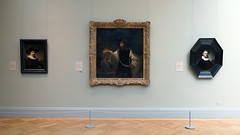
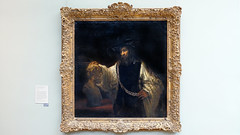


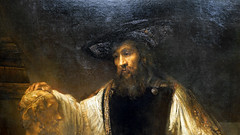
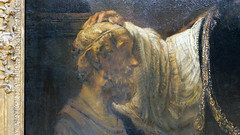
Rembrandt, Bathsheba at Her Bath
by DR. BETH HARRIS and DR. STEVEN ZUCKER
Video \(\PageIndex{8}\): Rembrandt van Rijn, Bathsheba at Her Bath, 1654, oil on canvas, 56 x 56″ / 142 x 142 cm (Musée du Louvre, Paris)
Smarthistory images for teaching and learning:
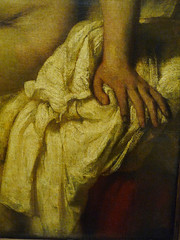
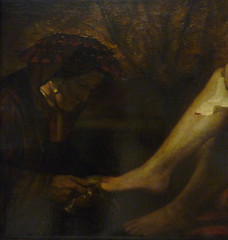
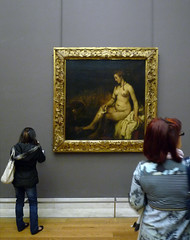
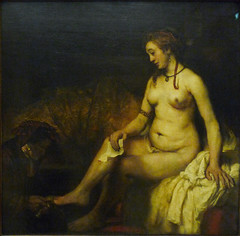
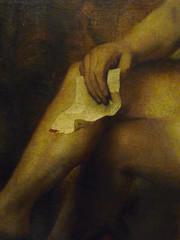
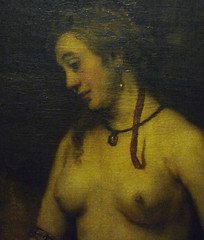
Rembrandt, Self-Portrait (1659)
by DR. STEVEN ZUCKER and DR. BETH HARRIS
Video \(\PageIndex{9}\): Rembrandt van Rijn, Self-Portrait, 1659, oil on canvas, 84.5 x 66 cm (National Gallery of Art)
Smarthistory images for teaching and learning:
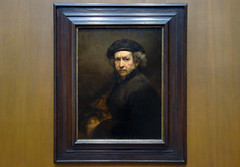
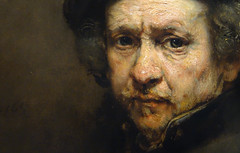
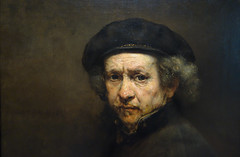
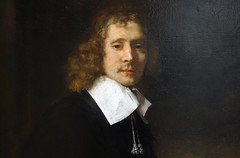

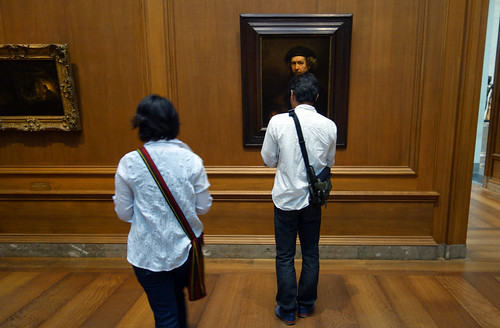
Rembrandt, Self-Portrait with Two Circles
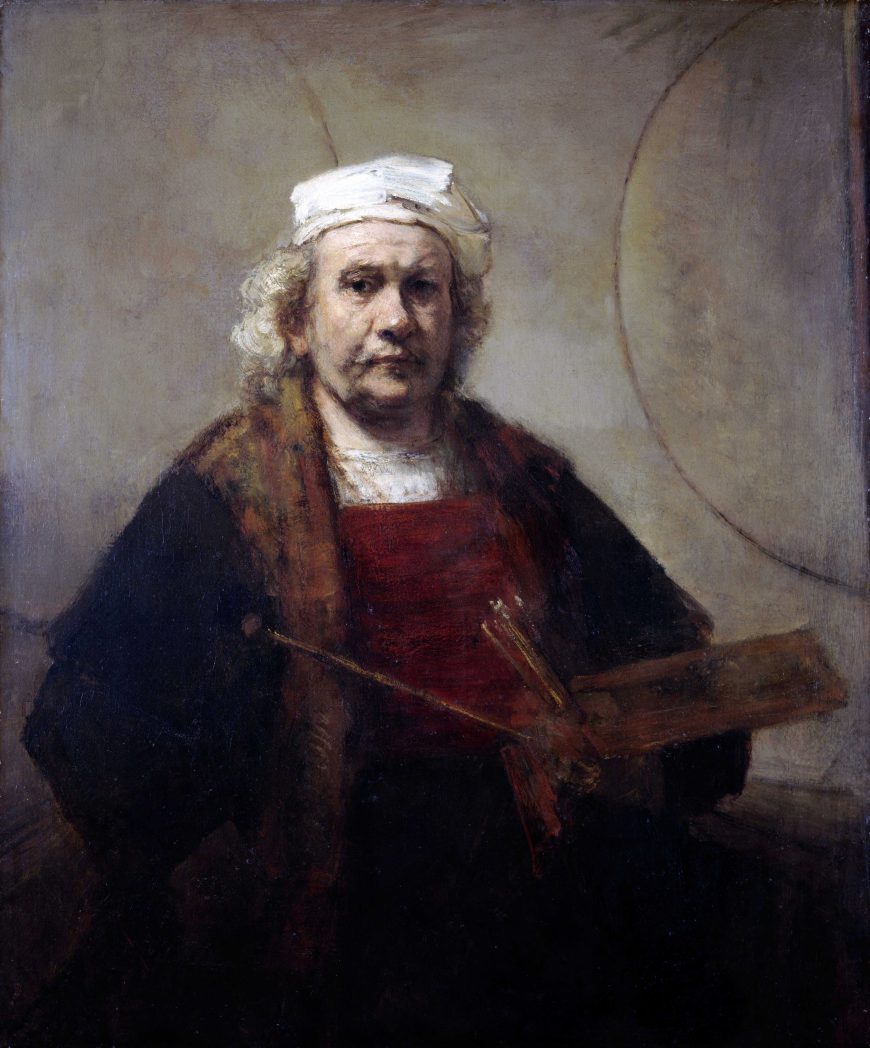
The painter and the painted
An old man in a white cap stares out at the viewer with a penetrating gaze. His left hand holds his hastily painted palette, brushes and maulstick, while his right hand seems to disappear in an unresolved blur into his thigh or the folds of his coat. He wears a red bib over a white shirt, with a fur lined coat on his shoulders. Some viewers perceive a gold chain, usually a mark of high honor, tucked into the folds of his garments.
The right edge of the canvas reveals the edge of the painting the artist is working on, while the back wall is adorned with two enigmatic arcing lines. The painting is not signed and is most likely unfinished. Technical studies suggest that it may have originally been slightly larger, which would have made the painting within the painting more prominent.
This is Rembrandt in the early 1660s —late in his career and during a period when he used thick impasto and dark colors to build up complex and engaging works of art. Scholars have regarded this particular self-portrait, one of many from the last decade of his life, as perhaps the most enigmatic and masterful of them all. It stands out from approximately 80 other self-portraits because of its light-toned background, which emphasizes the strangeness of the two circles that arc across the wall.
Self-portraits as self-exploration
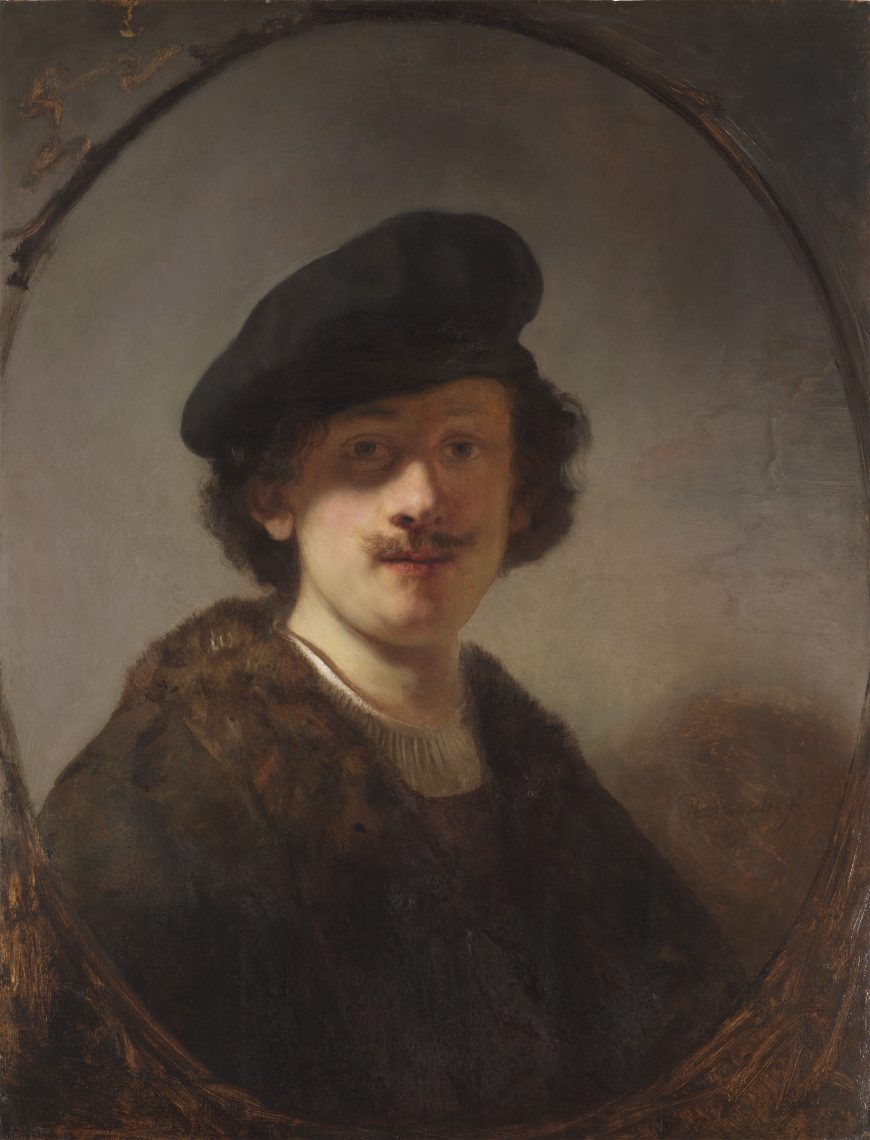
Approximately ten percent of Rembrandt’s output of paintings and prints consisted of self-portraits. This surprisingly high number is even more impressive when you take into account that each print would have existed in numerous copies — perhaps reaching into the hundreds per image.
Why was Rembrandt so captivated with reproducing his own image? Scholars have approached the self-portraits in a variety of ways: as reflections on Rembrandt’s own psychological state, as evidence of the artist’s stylistic and technical development through his life, as a sophisticated technique of self-promotion, and as a means of theorizing about how Rembrandt perceived the role of the artist in society. Fortunately, many of these interpretations can coexist and overlap.
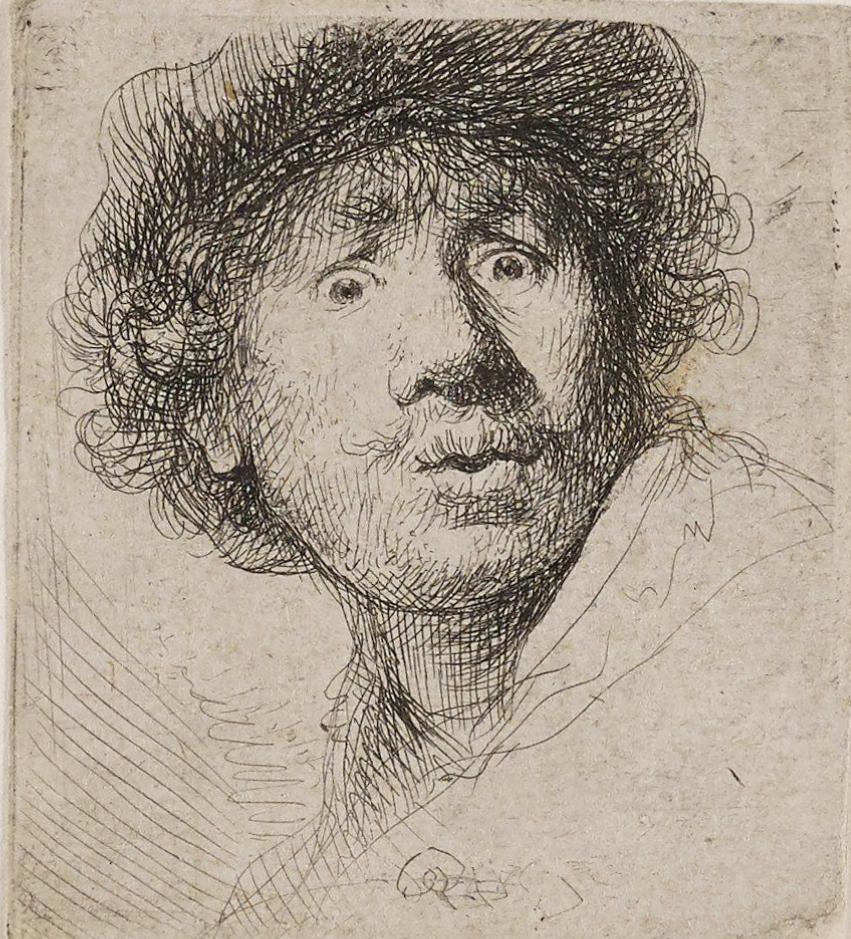
Rembrandt’s almost obsessive relationship with his own visage could be viewed as a process of self-exploration, a way he took stock of who he was at different points in his career. In some ways, this might seem consistent with the seventeenth-century Calvinist mindset within which Rembrandt would have been raised, a mindset that advocated intense personal responsibility for the state of one’s own soul.
Surely, if Calvinist artists were used to routinely scrutinizing their own actions and motives, then also scrutinizing their own faces makes a certain sense (Calvinism became the official religion of the Dutch Republic in 1648). In that regard, many scholars (for example, Perry Chapman) have perceived the self-portraits as deeply personal. This feels very appealing to us as viewers, because we want to try to humanize artists from the past. However, many leading Rembrandt scholars approach autobiographical psychologizing with skepticism because they argue that it is based in an understanding of the self that is rooted in twentieth-century psychological practices.
Rembrandt’s early self-portraits and the many small engraved and etched ones can perhaps be fruitfully interpreted through the application of early modern art theory and ideas about artistic training. As Marjorie Wiesman has noted, when writing didactic texts for painters in the early modern period, authors such as Franciscus Junius (1637) and Karel van Mander (1604) advised artists to examine their own inner emotions so that they would know how to project those emotions into the scenes that they created. Studying the impact of different emotions on bodies and faces was recommended as a means to make a painter a stronger artist. Many of Rembrandt’s early etched and engraved portraits (such as Self-Portrait with Eyes Wide Open) do exactly this, and yet the painted self-portraits (such as Self-portrait with Shaded Eyes primarily) seem to represent him calmly regarding the viewer. We can therefore conclude that he created different self-portraits for different reasons.
The economics of (self) portraiture
Since the work of John Michael Montias on the economics surrounding Johannes Vermeer and the city of Delft, market forces and economic theory have been fruitfully applied to Dutch art of the seventeenth century. In the case of Rembrandt’s self-portraits, we might ask: who was buying all of these self-portraits? If a self-portrait is regarded not as an internally reflective meditation on self and identity as an end in itself, but as a commodity, different avenues of analysis emerge. A self-portrait not only represents the painter visually, but also does so by quite literally showing the technique of the painter. In that regard, they functioned as advertisements that opened the door to future commissions.
During Rembrandt’s own lifetime, eminent figures such as King Charles I of England, Cosimo de’ Medici, and the art dealer Johannes Renialme were known to have owned self-portraits by the artist. At some points in his career, self-portraits clearly sold briskly. And yet a group of several paintings of generic men in moustaches and hats from the studio of Rembrandt reveal, when x-rayed, that they were self-portraits by Rembrandt to which his students later added accessories in order to convert them to character studies. This implies that the self-portraits were no longer selling and were therefore converted into something that would. The fact that there was not a single self-portrait listed among the art and objects inventoried at the time of Rembrandt’s bankruptcy in 1656 furthers our interpretation of the self-portrait as commodity. If they were primarily intended as personal explorations of the internal life of the artist, surely he would have kept at least one.
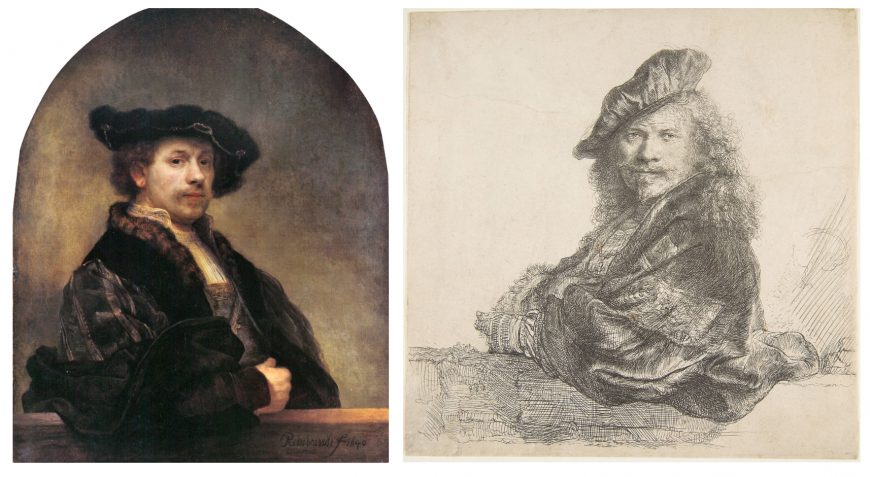
Recently, Marjorie Wiesman has approached Rembrandt’s self-portraits chronologically, separating them into earlier, brasher paintings where he appears youthful and passionate, mid-career works where he acknowledges and advances his rise to fame, and later, mature works that ruminate on the nature of old age and art as a profession. Portraits of the late 1630s and 1640s (mid-career) seem to chronicle his rise to the peaks of artistic accomplishment, particularly the famous painted portrait of 1640 and the companion print from 1639 (see above).
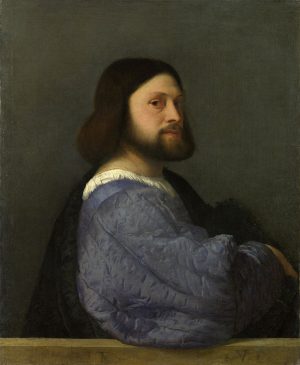
In both painted and printed versions of this portrait composition, Rembrandt dresses himself in a gaudy jacket, and chains and brooches adorn his feathered beret. Moreover, he leans on a windowsill with one elbow, inserting himself into a tradition of portraiture used by artists such as Titian and Raphael. He had seen Raphael’s portrait of Baldassare Castiglione at auction in Amsterdam, even noting on his sketch how much it sold for. He was also familiar with Titian’s Portrait of a Man – Gerolam Barbarigo? By mimicking these two great masters in his own self-portrait, Rembrandt’s posture and attire underline that — like Titian and Raphael — he is a man of means and talent. His self-portrait became a tool for advertising to potential investors and securing a place for himself in Amsterdam society and art history.
Self-portrait with Two Circles at Kenwood House
By the 1660s, however, Rembrandt was no longer presenting himself in the same way, perhaps because he was no longer seeking the same kind of audience he had in the earlier parts of his life. Nearing the end of a long and tempestuous career, the late self-portraits take a different, more somber tone. The Self Portrait with Two Circles at Kenwood House is one of the great examples of the last decade of the artist’s life. It has enticed generations of scholars because of the two incomplete circles on the back wall. A definitive explanation for those circles has yet to be agreed upon, but several compelling suggestions have been made.
One interpretation identifies the circles as the two hemispheres shown on a world map of the time. It would not be unusual for a large wall map to be hanging as a backdrop for a painting; wall maps were commonly depicted in the background of seventeenth-century genre scenes by artists like Johannes Vermeer. The problem with this interpretation, according to the detractors (who include Ernst van de Wetering and the Rembrandt Research Project is that the circles are too far apart to represent the two circles of a map, and that the wrinkling and curling of maps on walls seen in other paintings is not present here.
A more philosophical interpretation, proposed by Jan Emmens, suggests that all artists needed to have ingenium (inborn genius), ars (theory or learned knowledge), and exercitatio (or skill gained through practice). In this interpretation, the figure of Rembrandt stands in for Ingenium, while the circles behind indicate theory (ars) and the canvas at the edge of the picture plane speaks to exercitatio.
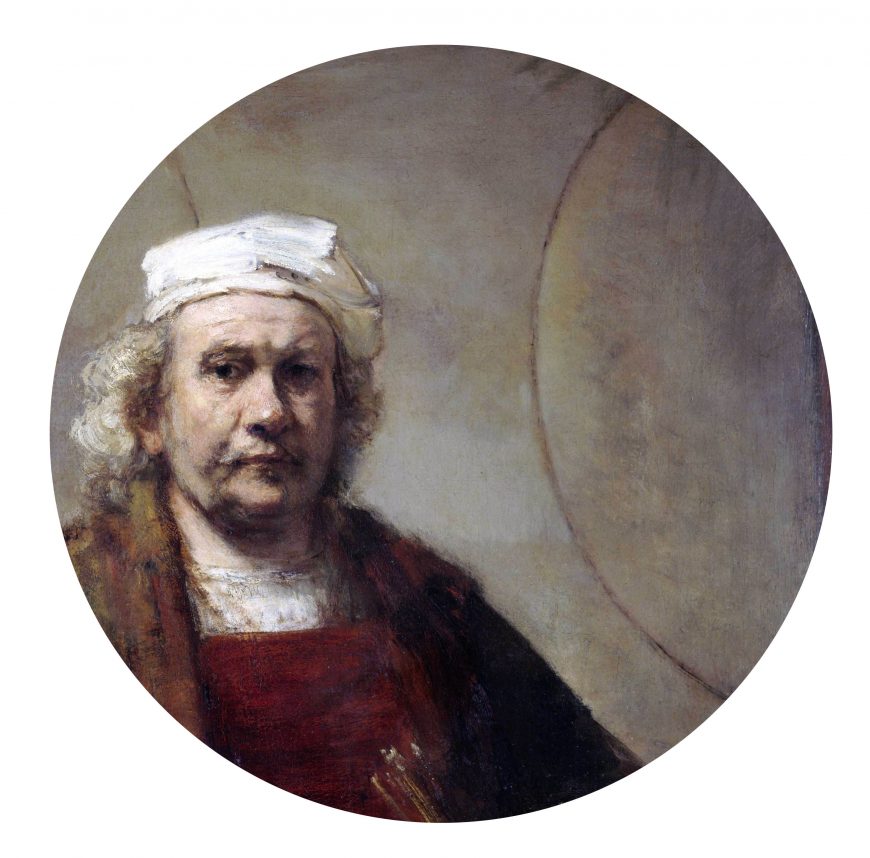
Perfect circles and artistic greatness
Several other scholars, including B. P. J. Broos and Jeanne Porter, connect the drawing of circles with ideas about art theory expressed in contemporary sources. In Het Schilderboek (The Painting Book) (1604), Karel van Mander repeats a famous story from Vasari — that Giotto could draw a perfect circle freehand at a young age. It is a demonstration of an innate skill, the height of perfection. This type of story, that is, about creating the perfect line, can be traced to classical antiquity where the great artist Apelles was also known for drawing the perfect line. Yet in the Kenwood portrait, Rembrandt’s circles are not perfect circles made with single, fluid lines; they are made up of his more characteristic short, interrupted strokes and they are themselves interrupted by the boundaries of the image.
Ben Broos has suggested that the painting reveals “perfection” in a particularly Rembrandt-esque manner. Rembrandt’s late work is defined by heavy impasto and choppy brushwork. By using that technique to create a perfect circle, the artist appropriates a motif from the tradition of artistic biographies and the legends of artistic greatness but makes it fully his own, both in how it is painted and in using it as a backdrop for a self-portrait. The Kenwood self-portrait could be making a claim for the artist as the pinnacle of greatness, situating himself alongside other masters in the long history of art.
A definitive interpretation of the circles remains elusive, and every generation of Rembrandt scholars proposes a new reading of the motif. What’s yours?
Additional resources:
Nederlands Instituut voor Kunstgeschiedenis (Netherlands Institute for Art History)
The Iconic Art at Kenwood House
P. J. Broos, “The O of Rembrandt,” Simiolus: Netherlands Quarterly for the History of Art, vol. 4, no. 3 (1971), pp. 150-184.
Perry Chapman, Rembrant’s Self Portraits (Princeton: Princeton University Press, 1990).
Jeanne C. Porter, “Rembrandt and his Circles: Self Portrait at Kenwood House,” in The Age of Rembrandt: Studies in Seventeenth-Century Dutch Painting, ed. Roland E. Fleischer, et al. (University Park: Pennsylvania State University Press, 1988), pp. 188–213.
Ernst van de Wetering, “The Multiple Functions of Rembrandt’s Self Portraits,” in Rembrandt by Himself, ed. Christopher White and Quentin Buvelot (London: National Gallery, 1999), pp. 8 – 37.
Ernst van de Wetering et al., A Corpus of Rembrandt Paintings, vol. 4: The Self-Portraits (Dordrecht: Springer, 2005).
Marjorie Wiesman, “The Late Self Portraits” in The Late Rembrandt, ed. Jonathan Bikker (Amsterdam: Rijksmuseum, 2015).
Rembrandt, The Jewish Bride
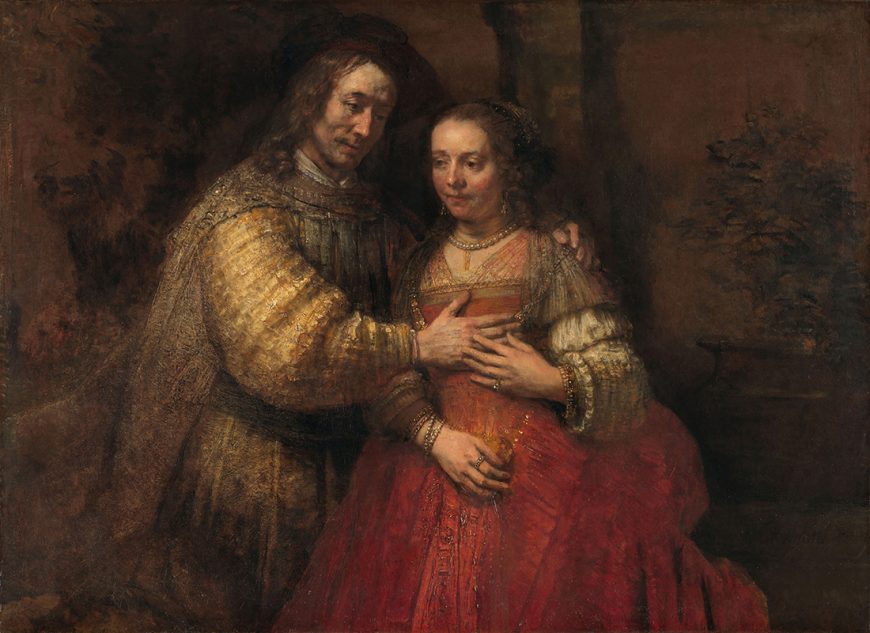
Portrait of a Couple as Isaac and Rebecca, commonly known as The Jewish Bride, is a painter’s painting. According to his letters, Vincent van Gogh was reduced to tears in front of it, writing that he would gladly give up ten years of his life to sit in front of the painting for two weeks, eating only a stale crust of bread. Though modern viewers may require slightly more sustenance, the power of the image remains.
In the center of a horizontally-oriented canvas, a woman in a luxurious red dress stands with her wrists and neck draped in pearls. Her companion stands to her right, one arm reaching behind her, the other reaching out to lay a hand at her breast. He is equally richly dressed in a vertically pleated garment over a shirt in shades of gold and brown. The fingers of her left hand gently rest on his in a touching, protective gesture. The two figures, despite the intimacy of their gesture, do not look at each other, nor do they look at the viewer. They are alone in this moment, set beside an arch and a potted plant barely indicated in shades of dark, mottled brown.
Late in Rembrandt’s career
Rembrandt van Rijn painted this canvas very late in his career. Though born in the Dutch city of Leiden, Rembrandt worked primarily in Amsterdam. There, he built up an impressive local clientele who were eager for his expressive portraits and, later, for his psychologically complex history paintings. His late paintings were intended for a smaller, more selective audience who would appreciate the idiosyncrasies of both the painter and his work. Some scholars have seen the last decade of Rembrandt’s life as a period of decline, yet it is also the decade that yielded many of his most cherished, complex, and psychologically-nuanced works. Paintings from this period are characterized by rich earth tones, in some areas thinly painted and in others applied in a thick impasto.
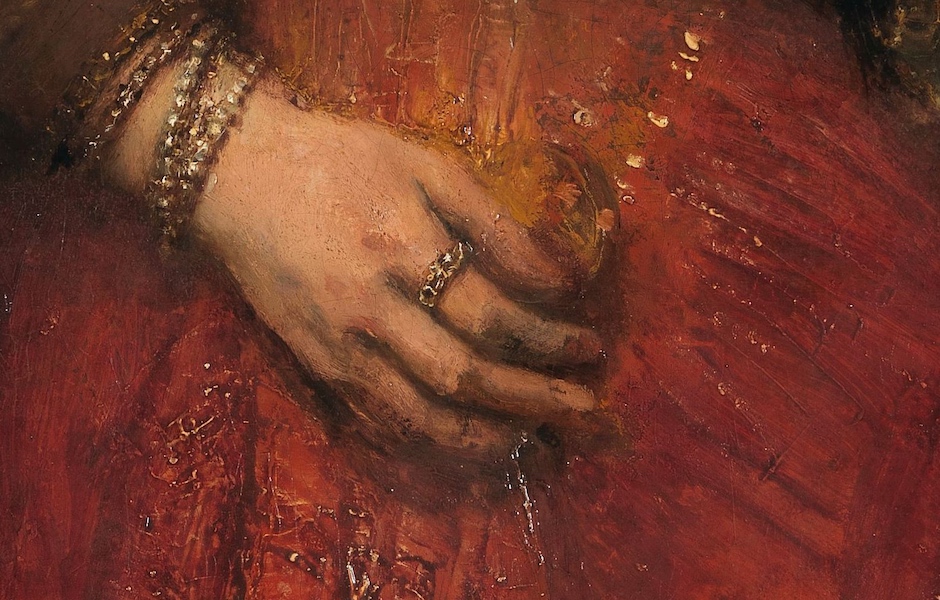
For example, in The Jewish Bride clearly visible heavy slashes of paint create the texture of the folds of the woman’s skirt, while smaller and more delicate highlights of white and gold pick out the rings on her fingers, the pearls at her neck and wrist, and the decoration of her dress.
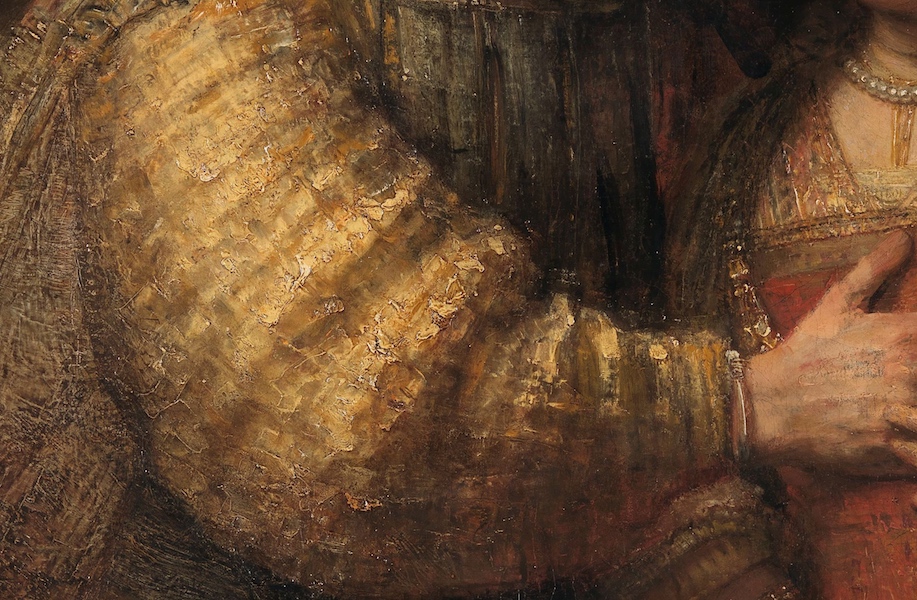
The almost sculptural quality of the paint is repeated in the man’s clothes as well. The small, square brushstrokes that form the man’s voluminous right sleeve work almost like tesserae in a mosaic to create a shimmering golden texture. Even the treatment of their faces reveals the hand of the artist moving over the canvas, building up the skin tones from a range of colors. Rembrandt uses the depiction of surfaces and the surface texture of the paint itself to direct our attention, allowing everything less important to literally dissolve into darkness and obscurity.

Who are the sitters?
Portrait of a Couple as Isaac and Rebecca has attracted more than its fair share of theories over the years, with ambiguity on every level. Who is represented? Is this a double portrait or a scene from a narrative? Who commissioned it and where was it hung? Was the canvas cut down at some point, or is this the whole composition? Despite substantial scholarship, many of these questions evade firm answers.
Like Rembrandt’s famous Night Watch, this painting is most commonly called by its nickname, The Jewish Bride. The nickname was a nineteenth-century addition, as there is no evidence for such a title in any seventeenth-century literature. The identification of the subject has generated a great deal of debate. At one point, it was maintained that this was a portrait of Rembrandt’s son Titus and his wife, though other theories have included a father-daughter identification.
Most commonly accepted, however, is the identification of the figures as the Biblical couple Isaac and Rebecca. There are many textual and visual sources that support this identification. The story of this couple is found in the Old Testament in the book of Genesis: Isaac and Rebecca were seeking refuge in the lands of the king Abimelech. Fearing that the locals might kill him because of his wife’s beauty, Isaac claimed that Rebecca was his sister, not his wife. They were, however, caught in a moment of intimacy by Abimelech, revealing their true relationship. Abimelech reprimanded them for their deceit, but also commanded that no one harm them. Isaac and Rebecca are the model married couple: she is modest, beautiful, and obedient while he is faithful, steadfast, and strong in his faith.
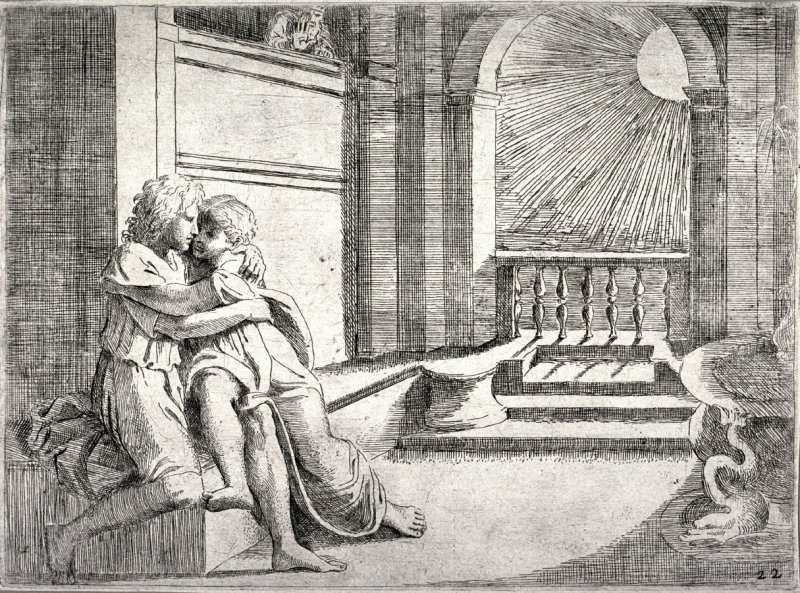

An intimate moment
Earlier works by Rembrandt and other artists support the identification of the subject and reveal how Rembrandt evoked and manipulated earlier compositions. A drawing, now in a private collection in the United States, reveals the characteristic and instantly recognizable gesture of the man reaching out to place a caressing hand on the breast of the woman. The earlier drawing differs, though, in that the spying Abimelech is just visible in a window in the top right corner, barely sketched in. In turn, this composition seems to be based on an earlier print by Sisto Badolocchio (above) after a Raphael fresco in the Vatican. Rembrandt’s subject matter therefore has an eminent pedigree.
By altering the composition between the drawing and the painting, Rembrandt has made an important shift in focus. In leaving out Abimelech, he has chosen to focus the attention of the viewer not on the larger narrative, but instead on a moment of intimacy between the two figures. In addition, as Jonathan Bikker has recently pointed out, leaving Abimelech out of the image casts us, the viewer, in the role of the spying king. This directly involves us in the scene, blurring the boundary between painting and life; we, too, are spying on an intimate moment.
A popular type of portrait
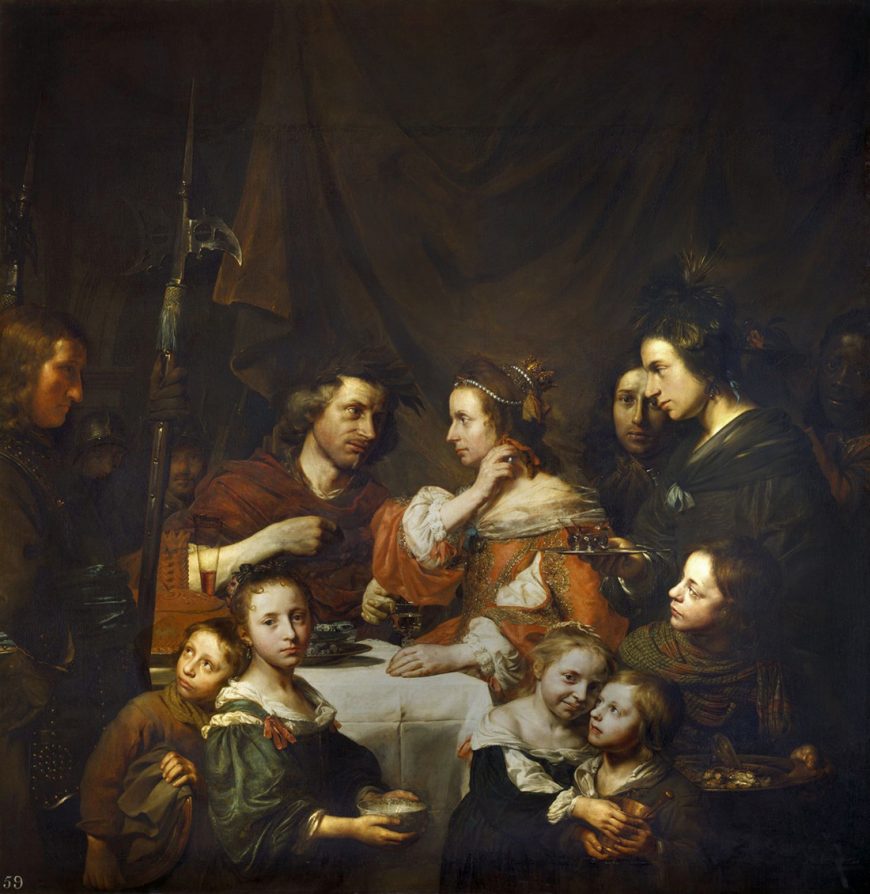
The size, lack of scenery, and intimate focus on two figures supports the idea that this was intended as a particular type of portrait: a portrait historié or historiated portrait, where two real people “dressed up” for their portrait.
Having one’s portrait painted in the guise of an historical or biblical figure may seem strange to us now, but the portrait historié was surprisingly common in the Dutch Golden Age (17th century). Whether the patrons were dressing up as biblical figures (and thereby hoping to lay claim to their virtues), or as mythological figures (demonstrating erudition or theatrical ties), historiated portraits existed comfortably alongside the more typical portraits of stern-faced people wearing black.
Jan de Bray depicted his family as figures in the banquet of Antony and Cleopatra, while the children of the exiled king and queen of Bohemia were depicted by Gerrit van Honthorst in the guises of Roman gods. In the case of The Jewish Bride, by choosing to be depicted as Isaac and Rebecca, the sitters were choosing to emphasize their fidelity and piety as well as suggesting to any viewer that their marriage was a happy and virtuous one.
The Jewish Bride is an example of the aging Rembrandt at his finest. He is both perfectly in step with broader trends in Dutch painting such as the portrait historié while also maintaining the distinctive artistic identity that his late patrons appreciated.
Additional resources:
This work in the Rembrandt database
Eclipses in Art › Isaac and Rebecca Spied upon by Abimelech
Bikker, Jonathan and Gregor J. M. Weber, eds. Late Rembrandt. Amsterdam: Rijksmuseum, 2015.
Van de Wetering, Ernst. A Corpus of Rembrandt Paintings VI. Dordrecht: Springer Netherlands, 2014.
Judith Leyster
Judith Leyster, The Proposition
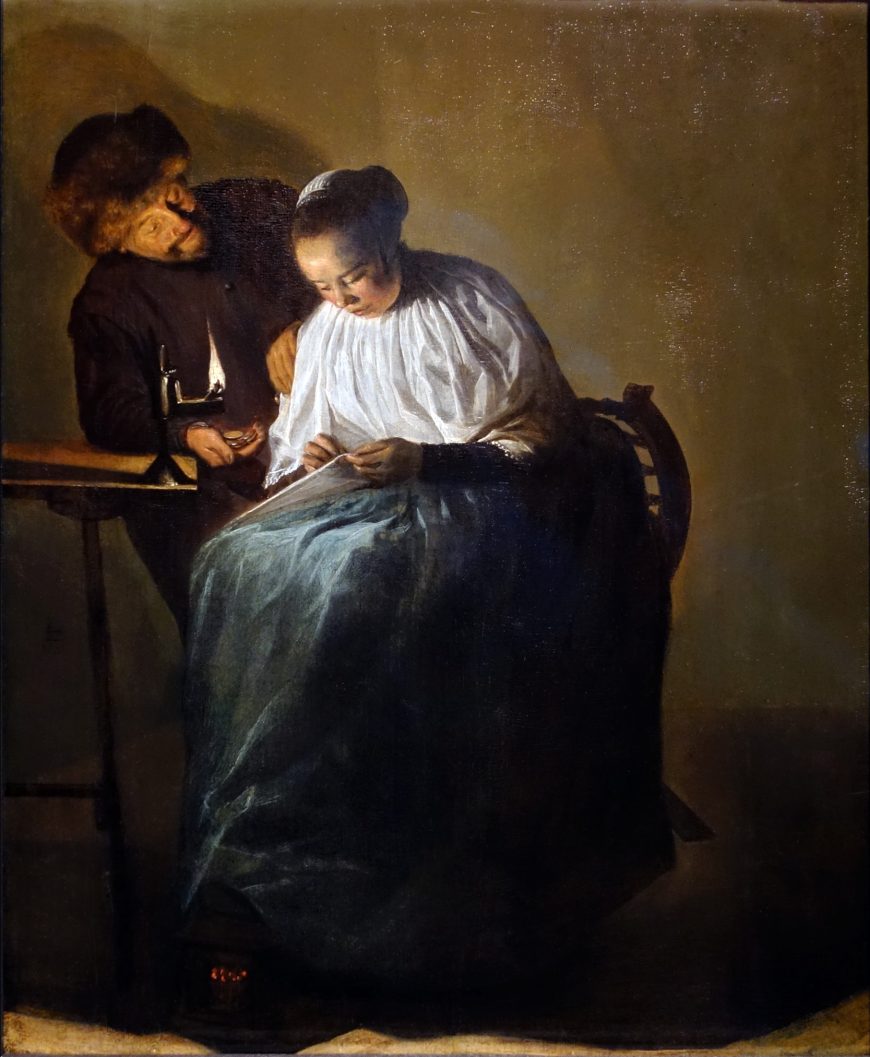
A soberly dressed woman sits in a darkened room, working diligently on her sewing. The only light comes from a lamp on the table, filling the room with deep, ominous shadow. An older man in a fur hat touches her shoulder with one hand and with the other presents a fistful of coins. The sparsely lit and furnished room and the man’s leering countenance generate a sense of unease; the suspended moment leaves the viewer uncomfortable with what has happened—or what is about to transpire. But who are these people? What will the woman choose: to do her work and ignore the man, or to put down her sewing to take the money? Virtue or vice?
Judith Leyster’s painting, called Man Offering Money to a Woman by the Mauritshuis Museum but often referred to as The Proposition, is an enigmatic painting with an ambiguous subject. Painted by one of the few well-known female artists working in the Dutch Republic, its subject matter is unusual in Dutch art, though it has strong ties to several visual and symbolic traditions. Its diminutive size—a mere 30.8 by 24.2 centimeters—invites the viewer to examine it carefully and intimately.
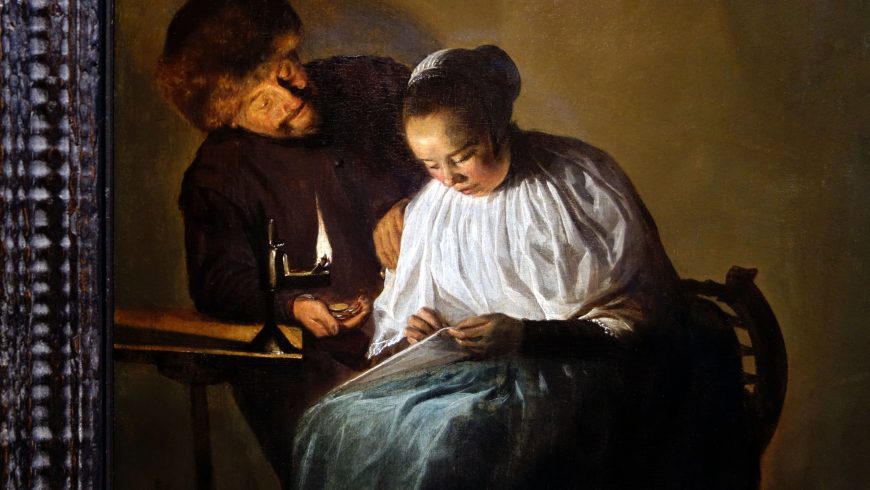
Leyster, Haarlem, and Caravaggio
Judith Leyster lived and worked primarily in the Dutch city of Haarlem, one of the centers of artistic innovation in the first half of the seventeenth century. The city had benefitted from an influx of artists and artisans who fled Antwerp in the Spanish Netherlands (now Belgium) during the 80 Years War. Leyster was a member of the Guild of St. Luke (the guild for painters and several other trades), which was unusual for a woman. Like many of her colleagues including Frans Hals, Dirck Hals, and Pieter Codde, she primarily painted scenes of everyday people doing everyday things (otherwise known as genre scenes). Her work is distinctive for the flat background that gives little sense of an illusionistic interior space. Some scholars have attributed this to her possible contact with the “Utrecht School”—artists in the Dutch city of Utrecht who were influenced by Caravaggio whose early genre scenes such as The Cardsharps (below) display similarly flat backgrounds with figures close to the viewer. The sharp contrasts of light and dark on the woman’s blouse and face are also reminiscent of Caravaggio. There are just two visible light sources, the lamp on the table and the glowing foot warmer under the woman’s feet. The flame in the lamp is a form of illumination often seen in Caravaggio’s northern followers (and not in Caravaggio’s own work).
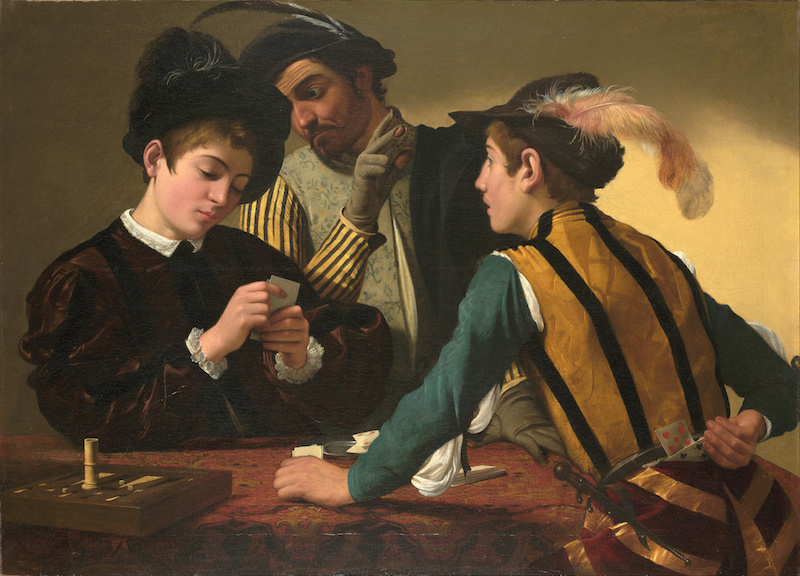
Instilling morality
On the surface, the painting shows an awkward interaction between a man and a woman. Dutch art often seems to reflect everyday life. Yet there are reasons to interpret these images symbolically, and not just as a reflection of life as it was lived. Some scholars (including Wayne Franits and Simon Schama), have interpreted the immense volume of imagery of women as indicative of a general anxiety about women’s education and what it meant to be a good Calvinist housewife. Since religious art was not being produced for the church in this Protestant country, morality had to be instilled in other ways. Secular genre scenes are often perceived as having a role to play in the moral education of the populace, either in presenting an image of ideal behavior or the consequences of bad behavior. Scenes of pious, moral women on the one hand and brothel scenes with lascivious women on the other may have flourished for just these reasons.
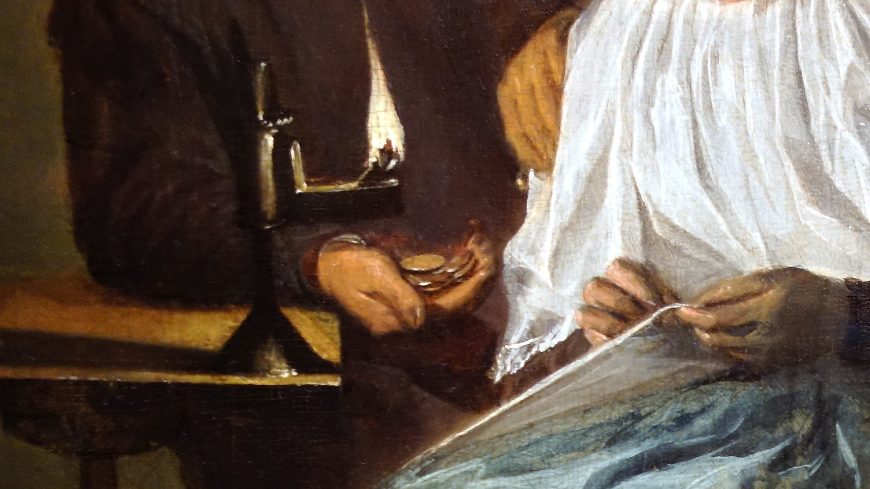
One commonly accepted interpretation of this painting—and the one from which the painting takes its most common nickname—was proposed by a leading scholar who sees the painting as representing a sexual proposition—one which the woman is staunchly ignoring.[1] This is a novel take on a traditional subject—brothel scenes where men interact with prostitutes or men and women drink and make merry in mixed company were among the most common subjects for genre paintings of the early seventeenth century. This type of scene has a long history in northern art (by artists such as Quentin Metsys, Lucas Cranach, Albrecht Durer, and others) and the actions of the participants was presented as unwise, unrestrained, and sinful, and women are usually presented as seductresses and thieves. These paintings therefore are models of how not to behave. By contrast, Leyster’s composition draws on another type of imagery that showed women hard at work—the very model of virtue.
Emblem books
A common component of visual culture in the seventeenth century was a type of book called an emblem book. On one page, the book might contain an image, a motto, and a poem, all explaining one moral lesson the reader was expected to learn. Books of this sort proliferated and some scholars have noted that there were more copies of emblem books circulating in seventeenth century Holland than bibles. Many scholars have tried to use this shared visual language to “decode” the components of genre paintings, with mixed success. Emblem literature was often targeted at specific audiences: for example, Jacob Cats, Houwelijk (Marriage) outlined all the proper stages of life for a woman. In one emblem, he presents needlework as one of the skills most valued and emblematic of domestic virtue.
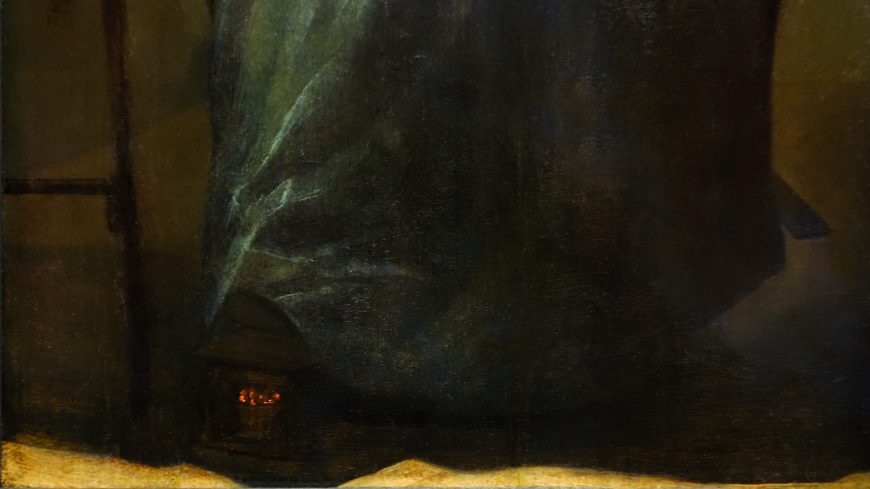
In Leyster’s painting, the woman becomes an icon of domesticity, working diligently in the cold, unlit room. Even the foot warmer on which the woman rests her feet to combat the cold has been connected to emblem books—as a symbol of the woman’s refusal of the man. One emblem book frames the foot warmer as a woman’s best friend since a man would have to be truly enticing to get a woman to step away from her foot warmer on a cold night. The woman’s firmly planted foot does not indicate a tendency towards a sexual liaison. Leyster’s composition has been seen as an important fore-runner of later genre painters such as Gerard Ter Borch, and, most famously, Johannes Vermeer. In Leyster’s painting, the viewer is left wondering to which tradition the woman belongs. Like much of Dutch art of the Golden Age (the 17th century), this painting is about choices: the choices of the subjects and by extension, the choices of the viewer. The woman is in a suspended state, a moment of decision. Will she virtuously continue her work, or arise, take the money, and go with the man? Will she choose virtue or vice?
[1] Frima Fox Hofrichter, Judith Leyster: A Woman Painter in Holland’s Golden Age (Davaco Publishers, 1989)
Smarthistory images for teaching and learning:
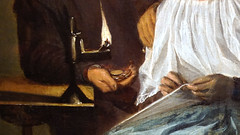
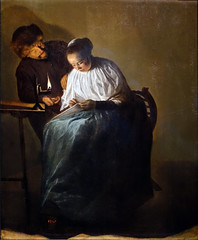

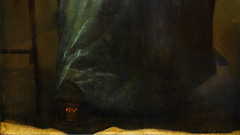
Additional resources:
This painting at the Mauritshuis
Judith Leyster at the National Gallery of Art
Leyster on the Google Art Project
Wayne Fronts, Looking at Seventeenth-Century Dutch Art: Realism Reconsidered (Cambridge University Press, 1998).
Frima Fox Hofrichter, Judith Leyster: A Woman Painter in Holland’s Golden Age (Davaco Publishers, 1989).
Simon Schama, The Embarrassment of Riches: An Interpretation of Dutch Culture in the Golden Age (Vintage, 1997).
Peter Schjeldahl, “A Woman’s Work: The brief career of Judith Leyster,” The New Yorker, June 29, 2009.
Judith Leyster, Self-Portrait
by DR. BETH HARRIS and DR. STEVEN ZUCKER
Video \(\PageIndex{10}\): Judith Leyster, Self-Portrait, c. 1633, oil on canvas, 74.6 x 65.1 cm / 29-3/8 x 25-5/8″ (National Gallery of Art, Washington D.C.)
Smarthistory images for teaching and learning:

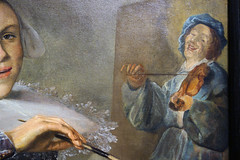





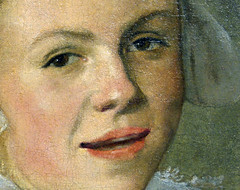
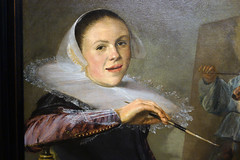
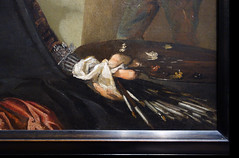
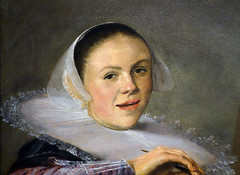
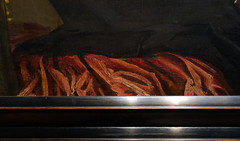
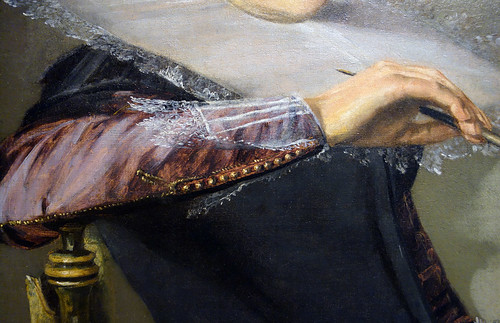
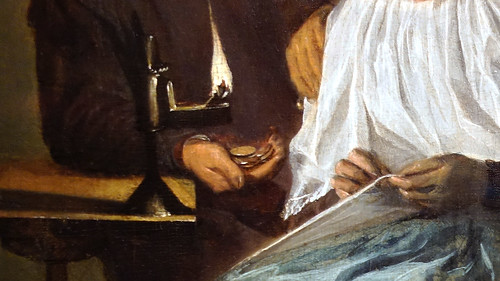
Willem Kalf, Still Life with a Silver Ewer
by STEVEN ZUCKER and BETH HARRIS
Video \(\PageIndex{11}\): Willem Kalf, Still Life with a Silver Ewer and a Porcelain Bowl, 1660, oil on canvas, 73.8 x 65.2 cm (Rijksmuseum)
Smarthistory images for teaching and learning:
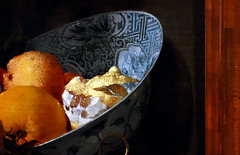
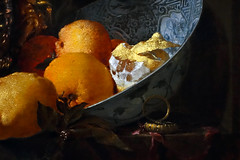
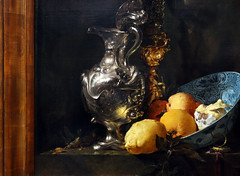

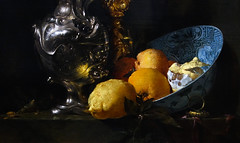
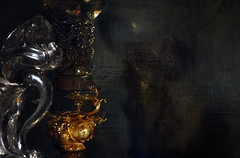
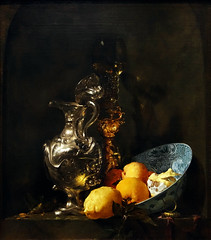

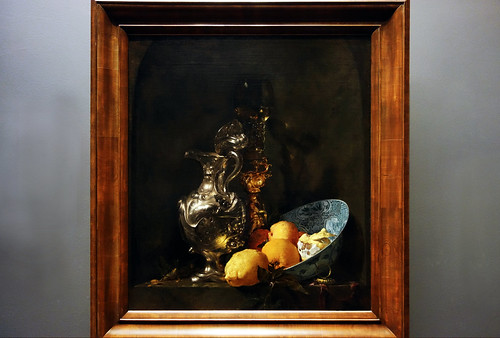
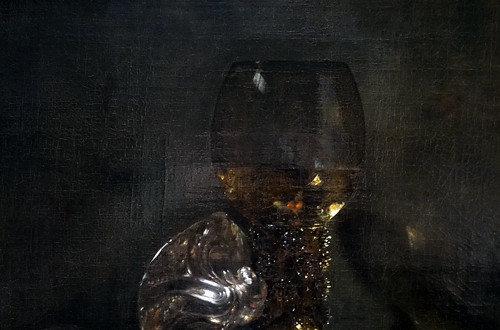
Gerrit Dou, A Woman Playing a Clavichord

A Harmonious Composition
A tapestry is drawn back to reveal a young woman sitting alone in an unlit room. She plays a clavichord, a portable and fairly quiet keyboard instrument, with a decorated lid. Sunlight enters the room through a window to the left, illuminating the figure of the woman and touching on the different still life elements dispersed across the space: an empty birdcage hanging from the ceiling, a velvet cushion on a carved wooden stool, a ewer and basin encircled by a vine, a viol da gamba (the large stringed instrument) and a table with an open music book, flute, platter and wine glass. They are illustrated so realistically that there is a temptation for the viewer to reach out and caress them. The woman looks out towards us as though we have intruded: a momentary interruption of her intimate solo concert. Perhaps, she is awaiting the return of her lover, who will play the viol and join her in a duet. Maybe it is we, the onlooker, who is meant to take her partner’s place.

A Woman Playing a Clavichord was painted by Gerrit Dou around 1665. Dou was the most famous of the group of painters active in the city of Leiden, in the Dutch Republic, who were known as the fijnschilders (literally “fine” painters), who specialized in small-scale paintings full of minute detail and which concentrated on the faithful depiction of different surfaces and textures—a talent that is clearly evident in the Dulwich painting. Dou was the youngest son of a glass-engraver and from an early age trained in his father’s profession. It was this background that doubtless enabled the young Dou to develop his meticulous technique. He began his formal training as a painter in 1628 when he was sent to the studio of Rembrandt, remaining with the master for three years before completing his apprenticeship.

A Woman Playing a Clavichord is regarded as one of Dou’s finest works, and is one of only two paintings that take this musical theme as its subject. The other is A Young Lady Playing the Virginal, c. 1665 (above), and the early histories of the two works have been frequently confused. Indeed, the paintings were first displayed together in 1665, when they were shown in an exhibition organized by Dou’s patron Johan de Bye in Leiden; possibly the first ever monographic exhibition of a living artist.
The paintings show how Dou was able to approach this subject in remarkably different ways. Dou still uses the device of the drawn back tapestry-curtain, delicate rendering of fabrics and textures, and the figure of the woman looking up from her playing (although this is definitely not a portrait of the same woman). However, our eye is drawn to the presence of other figures in a room beyond. Wine is flowing and the woman’s lover already sits waiting with glass in hand whilst another couple sing from songbooks, meanwhile a young serving boy tops up their drinks. The woman in the foreground plays a virginal: significantly louder than a clavichord and presumably intended to accompany the singers. In this way, the Young Lady Playing the Virginal is definitely a noisier and more hedonistic scene than A Woman Playing a Clavichord. In contrast to the intimate affair of the Dulwich painting, here the emphasis is very much on the pleasures of life. Whilst Woman Playing a Clavichord may have alluded to the possibility of a male lover, Young Lady Playing the Virginal makes more explicit the woman’s position as a courtesan-type figure whose role is to entertain men.

Nevertheless, interpreting the intricate layers of meaning in Dou’s paintings is far from straight forward. On the one hand the various still life details can be taken at face value—as a testament to Dou’s meticulous technique when it came to representing the world around him. On the other, each element can be seen as symbolic, and the painting full of hidden meanings. Many of these meanings would underline the idea that the missing “partner” in the Dulwich painting is the woman’s lover, and that the painting has various erotic or sexual connotations.
The latter interpretation, which developed with art historical theory of the 1960s, cites the prevalence of emblem books as a reference point for artists; a kind of book popular in medieval and Renaissance Europe that contained drawings accompanied by allegorical interpretations. In this light, the flute, ewer and bow become symbolic of the male sex; whilst the basin and viol become representative of the female. Likewise, the closed birdcage represents the woman’s virginity which may have already been taken. Critically, the argument against seeing this in such a way is that there are no contemporary sources that confirm such an interpretation for this genre of painting.
Dou’s meticulous style of painting was incredibly influential for both the Leiden painters and the renowned artist Johannes Vermeer, who soon after began to paint his own interior scenes showing women playing keyboard instruments, most notably A Young Woman Seated at a Virginal, c. 1670-2 (The National Gallery, London).
Essay by Helen Hillyard, Assistant Curator at Dulwich Picture Gallery, London.
This essay was produced in conjunction with the Making Discoveries display series at Dulwich Picture Gallery, London. The displays coincide with the release of the Gallery’s Dutch and Flemish Schools Catalogue, published 2016, and aims to disseminate important findings from this major research project.
Johannes Vermeer
Johannes Vermeer, The Glass of Wine
by DR. STEVEN ZUCKER and DR. BETH HARRIS
Video \(\PageIndex{12}\): Johannes Vermeer, The Glass of Wine, c. 1661, oil on canvas, 67.7 x 79.6 cm (Gemäldegalerie, Staatliche Museen zu Berlin)
Smarthistory images for teaching and learning:
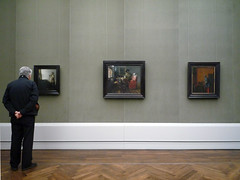
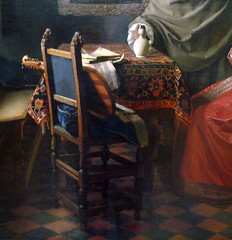
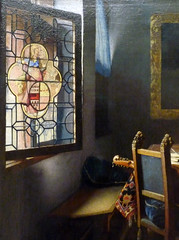
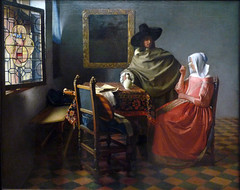
Johannes Vermeer, Young Woman with a Water Pitcher
by DR. STEVEN ZUCKER and DR. BETH HARRIS
Video \(\PageIndex{13}\): Johannes Vermeer, Young Woman with a Water Pitcher, oil on canvas, c. 1662 (Metropolitan Museum of Art, New York)
Smarthistory images for teaching and learning:
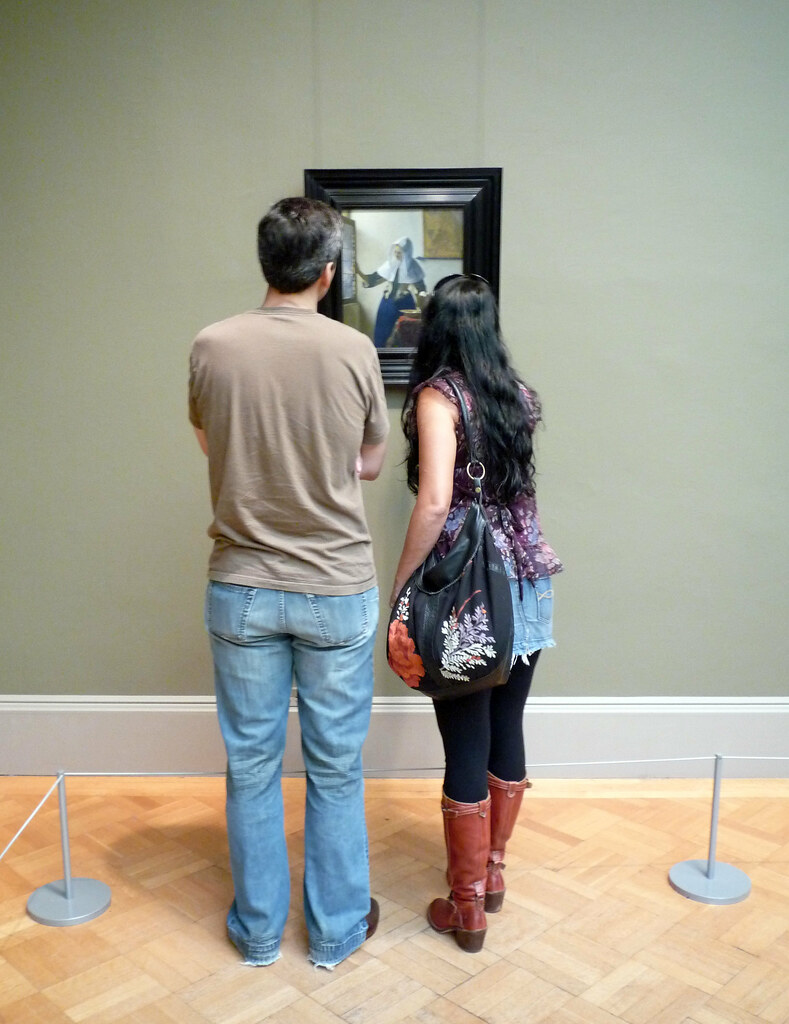
Johannes Vermeer, Woman Holding a Balance
by DR. STEVEN ZUCKER and DR. BETH HARRIS
Video \(\PageIndex{14}\): Johannes Vermeer, Woman Holding a Balance, 1664, oil on canvas, 42.5 cm × 38 cm / 16.7″ × 15″ (National Gallery of Art, Washington D.C.)
Johannes Vermeer, Girl with a Pearl Earring
by DR. STEVEN ZUCKER and DR. BETH HARRIS
Video \(\PageIndex{15}\): Johannes Vermeer, Girl with a Pearl Earring, c. 1665, oil on canvas, 44.5 x 39 cm (Mauritshuis, The Hague)
Smarthistory images for teaching and learning:


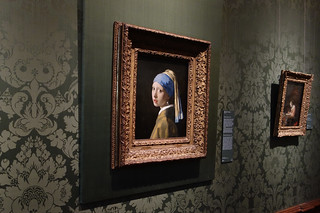
Johannes Vermeer, The Art of Painting
by DR. STEVEN ZUCKER and DR. BETH HARRIS
Video \(\PageIndex{16}\): Johannes Vermeer, The Art of Painting, 1666-69, oil on canvas, 130 x 110 cm (Kunsthistorisches Museum, Vienna)
Saenredam, Interior of Saint Bavo, Haarlem
by DR. CHRISTOPHER D.M. ATKINS and DR. STEVEN ZUCKER
Video \(\PageIndex{17}\): Pieter Jansz. Saenredam, Interior of Saint Bavo, Haarlem, 1631, oil on panel, 82.9 x 110.5 cm (Philadelphia Museum of Art) Speakers: Dr. Christopher D. M. Atkins, Agnes and Jack Mulroney Associate Curator of European Painting and Sculpture, Philadelphia Museum of Art, and Dr. Steven Zucker
Additional resources:
This painting at The Philadelphia Museum of Art
Philadelphia Museum of Art: Handbook (Philadelphia: Philadelphia Museum of Art, 2014, p.136).
Catalogue Raisonné of the works by Pieter Jansz. Saenredam (Utrecht: Centraal Museum, 1961), p. 74.
Jeroen Giltaij, “Review: Gary Schwartz and Marten Jan Bok, Pieter Saenredam: The Painter and his Time, 1990,” Simiolus 20, no. 1 (1990/1991), pp. 87-90.
Rob Ruurs, Saenredam: The Art of Perspective (Amsterdam: Benjamins / Forsten Publishers, 1987).
Gary Schwartz and Maarten Jan Bok, Pieter Saenredam: the Painter and his Time (New York: Abbeville, 1990).
Rob Rurrs, “Review: Gary Schwartz and Marten Jan Bok, Pieter Saenredam: De Schilder in zijn tijd, 1989,” The Art Bulletin 72, no. 2 (June 1990), pp. 332-336.
Jan Steen, Feast of St. Nicholas
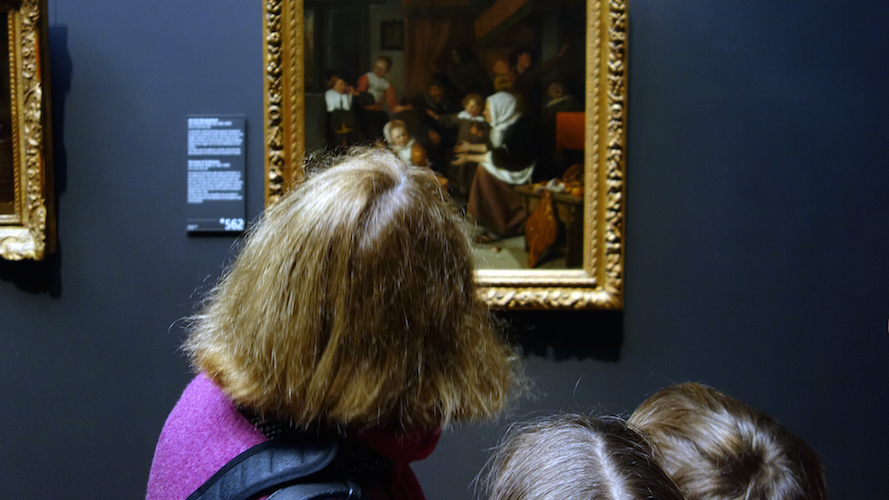
A holiday for children

In this delightful scene, Jan Steen beautifully captures the joys of a family gathering together in their home to celebrate the Feast of St. Nicholas, still one of the most important holidays on the Dutch calendar. The holiday falls on December 6th and is especially devoted to children. In the Netherlands, on the night before the feast, St. Nicholas travels on horseback over rooftops accompanied by his helper, Zwarte Piet (“Black Peter”), whose name comes from his being covered in soot from the chimneys used to access Dutch homes. Children place their shoes on the hearth and hope to find them the next morning filled with presents and other delectable treats. Families sing songs in honor of the saint and share an abundance of candies, specially baked breads, and sweet biscuits. It is a day full of fun and surprises and even a bit of mischief.
A master visual storyteller, Steen incorporates many of these traditions in his painting while also expertly representing the actions and expressions of the children in this middle class family as they react to the morning’s events.



The boy laughs and points to a shoe held by a young maidservant. The shoe contains birch switches that were used to punish naughty children. Clearly, a tearful boy, to the maidservant’s right, received the shoe as a not-so-desirable gift for his poor behavior.

His grandmother, however, beckons him toward the bed in the back of the room, where it appears that she has discovered a better gift hidden behind the bed curtains. On the right side of the scene, three additional children gaze with wide-eyed amazement toward the chimney through which their presents were delivered. An older brother holds up a toddler for a better view. The toddler hugs a gingerbread version of St. Nicholas, a reminder of who is being honored on this joyous occasion.

In the foreground of this domestic interior, Steen tempts us with an assortment of treats piled high in a woven basket and strewn across the seat of an ornately carved chair. Here we see apples, nuts, sugared candies, waffles and other baked delights of various shapes and sizes. Particularly impressive is the large, richly decorated diamond-shaped loaf that leans against the chair. This sweet white bread, called a duivekater, was traditionally enjoyed at the Feast of St. Nicholas, as well as at Christmas, and on the Dutch New Year.
Saint Nicholas
The Christian Saint Nicholas, or as the Dutch call him, Sinterklaas, was a fourth-century Bishop of Myra (a town located in modern day Turkey) who was known for his generosity and kindness especially to children. He died on December 6th in 343 C.E., and it is this day that is commemorated. Although traditionally a Catholic holiday, the Feast of St. Nicholas survived in the Protestant Netherlands, although in a secularized form to be celebrated by all.
Nevertheless, Sinterklaas continues to be shown wearing his customary bishop’s garb: a tall, pointed red mitre (hat) and long red robes. In the eighteenth century, when Dutch immigrants brought their traditions to America, the well-loved Saint Nicholas eventually developed into the figure known today as Santa Claus.

A comic genius
This charming scene of family is a fine example of the type of painting that Jan Steen is best known for. In addition to holiday gatherings such as this, his other works include representations of school life, rowdy taverns, love-sick women, and dissolute households. Steen fills his scenes of everyday life with engaging details, presenting them in a direct and amusing way. While he finds some inspiration in the theater, Steen relies as well on his keen wit and narrative ability to capture, and in some cases, even ridicule human nature in a good humored and entertaining manner. An especially versatile artist, Steen was also a talented painter of biblical and mythological subjects as well as portraits. With some 300 paintings to his credit, Steen leaves a legacy as a comic genius and one of the most prolific Dutch painters of the seventeenth century.
Jacob van Ruisdael, View of Haarlem with Bleaching Grounds
by DR. BETH HARRIS and DR. STEVEN ZUCKER
Video \(\PageIndex{18}\): Jacob van Ruisdael, View of Haarlem with Bleaching Grounds, c. 1670–75, oil on canvas, 55.5 x 62 cm (Mauritshuis, The Hague)
Smarthistory images for teaching and learning:
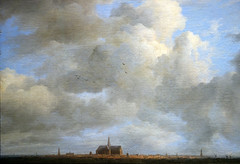
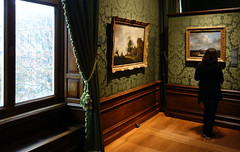
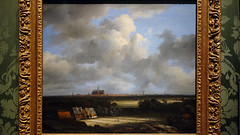
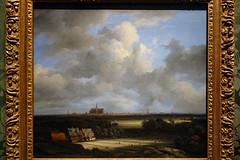
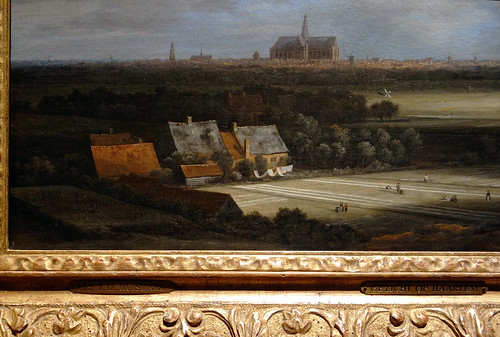
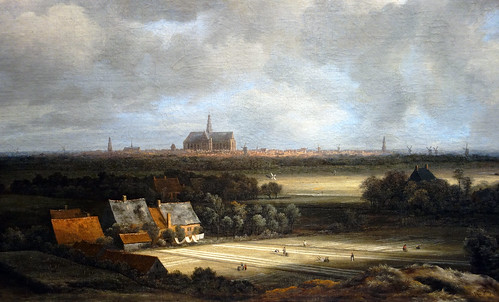
Rachel Ruysch
Rachel Ruysch, Fruit and Insects
by DR. BETH HARRIS and DR. STEVEN ZUCKER
Video \(\PageIndex{19}\): Rachel Ruysch, Fruit and Insects, 1711, oil on wood, 44 x 60 cm (Galleria degli Uffizi, Florence)
Smarthistory images for teaching and learning:
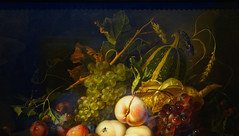
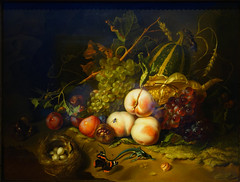

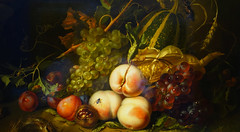
Rachel Ruysch, Flower Still-Life
by LYNN ROBINSON
What would you consider today’s most coveted status symbols? A Mercedes or a Ferrari, a diamond Rolex or a designer handbag? A European villa? In Rachel Ruysch’s day it was a simple tulip. Looking at her floral still life paintings can reveal an entire hidden world—of wealth, status, even the economics of the world’s first financial crises.
Growing up: Art and science

Rachel Ruysch grew up in Amsterdam, into a wealthy and prominent family of Dutch artists, architects and scientists. Her father, Frederik Ruysch, was an eminent scientist and professor of anatomy and botany. He possessed a well-known collection of rare natural history specimens, which Rachel helped catalogue and record. He encouraged her artistic talents, careful observation of the natural world and scientifically accurate renderings of plants and flowers. At age fifteen, Ruysch began an apprenticeship with famous still life painter Willem van Aelst. By eighteen, she was already producing her first still life paintings and starting to establish her long and successful career.
A working mother
At twenty nine, Rusch married portrait painter Juriaen Pool, with whom she had ten children. Despite her enormous domestic responsibilities, she was remarkably prolific, producing more than 250 paintings over seven decades. Her works were in great demand, and she achieved widespread fame and international recognition. Considered one of the most successful artists of her day, contemporary Dutch writers called her “Holland’s art prodigy” and “our subtle art heroine.”
Consumer society
In 1648, the Netherlands became independent from Spain, ushering in a period of great economic prosperity. Flourishing international trade and a thriving capitalistic economy resulted in a newly affluent middle class. Wealthy merchants created a new kind of patronage and art market. Without a powerful monarchy or the Catholic Church to commission artworks (the Dutch were Protestants), artists produced directly for buyers. Like today, buyers purchased art either from professional dealers or from the artist in their studios. Subjects like big historical, mythological or religious paintings were no longer desired; buyers wanted portraits, still lifes, landscapes and genre paintings (scenes of everyday life) to decorate their homes. Proud of their newly independent country and trade wealth, they desired artworks that would reflect their success. In a competitive open market, artists began to specialize. Rachel Ruysch became known as one of the greatest flower painters of her time.
Flowers: A national passion

Ruysch’s career paralleled the growth of the Dutch horticultural industry and the science of botany. The Netherlands became the largest importers of new and exotic plants and flowers from around the world. Once valued primarily for their use as herbs or medicine, flowers became newly appreciated simply for their beauty and fragrance. They became prized luxuries and desirable status symbols for the wealthy. Botanists and gardeners sought the rarest specimens imported from overseas trade. The tulip, like the one featured prominently in Ruysch’s painting below, was the most exotic.
“Tulip mania”
Coveted for their intense and unusually varied colors, tulips were introduced into the Netherlands from Turkey in the late sixteenth century. The Dutch fell madly in love with them. Because it takes so long for a tulip to be grown from seed, demand far outpaced supply. The rarest and most valuable tulips were the variegated or “flamed” tulips, those with feathers of contrasting color on their petals. This exotic coloration was actually caused by a virus that infected the tulip, shortening its life span and making it even more sought after and valuable. The stage was set for a buying craze.
Buyer beware: A cautionary tale?

The word tulip mania is often used today to refer to certain types of economic crises. It describes a financial bubble caused by large numbers of people speculating on unproved commodities or companies. Tulip bulbs were so avidly desired in the seventeenth-century Netherlands that a “futures market” was born. Buyers bought bulbs still in the ground, speculating that they would be worth more in the future and could then be sold for a large profit. Prices rose steadily and irrationally. At the peak of tulip speculation in 1636, some bulbs sold for more than a skilled craftsman earned in ten years. A nursery catalog of the time notes that at the height of the madness, a rare “Semper Augustus” tulip sold for 5,200 guiders, more than the price of a fine house, a ship or twelve acres of land.
In February, 1637, investors suddenly decided that tulip bulbs were grossly overpriced, and began to sell. Within days, panic ensued. With more sellers than buyers, demand for tulips evaporated. Prices plummeted, tulip bulbs lost 90% of their earlier value, and the market crashed. The world had just experienced its first financial bubble.
Look closely: Microscopic detail

A successful Dutch still life painting was highly valued for its degree of skillful realism. Flowers Still Life depicts a profusion of scientifically accurate floral details. Each petal, stem, and leaf is minutely and precisely rendered. Textures are remarkably realistic, from the delicate paper thin poppy petals to the crinkly, brittle leaves. Looking closer still, we see that Ruysch has also meticulously depicted tiny insects: a caterpillar crawls on a stem, a bee gathers pollen from the center of a poppy, a white butterfly alights on a marigold.
Mixed bouquet

Flower Still Life depicts a lush variety of different flowers, from popular common European blooms to rare overseas species. Ruysch combines a complex and intricate arrangement of poppies, snapdragons, roses, carnations, hollyhocks, marigolds, morning glories and a single red and white flamed tulip. Flowers lavishly spill out of the vase, filling the entire picture space. Some are in full bloom, others droop and wilt, as leaves and curving stems entwine throughout. While many of her contemporary flower painters used more symmetrical and formal compositions, Ruysch was known for these lively and informal looking arrangements. The flowers are asymmetrically arranged, leading the eye diagonally from the lower left drooping marigold to the upper right red poppy. Our eye is first attracted to the lightest flowers in the center, then to the brightly colored surrounding flowers, and finally out to the small darker flowers at the edges of the bouquet. Complementary colors create harmony, as warm yellows and rose balance cool blues and greens. Light alternates with shadow, enlivening the flowers as they stand out dramatically against the darker background.
“Vanitas”: Hidden meanings?
Some scholars believe there is another way to view Ruysch’s flower paintings. One common interpretation is to understand them in light of vanitas, a moral message common at the time. Taken from a passage in the Christian bible, it was a reminder that beauty fades and all living things must die. While still life paintings celebrated the beauty and luxury of fine food or voluptuous flowers, vanitas was a warning about the fleeting nature of these material things and the shortness of life. In Flowers Still Life, some flowers wilt and die while insects have eaten holes in the leaves. Wealthy Dutch consumers were being reminded to not become too attached to their material possessions and worldly pleasures; eternal salvation came only through devotion to God.
Additional resources:
Flower Still Life in the Toledo Museum of Art
Jan van Huysum, Vase with Flowers
by PIPPA COUCH and RACHEL ROPEIK
Video \(\PageIndex{20}\): Jan van Huysum, Vase with Flowers, c. 1718-20, oil on canvas, 24 x 31″ / 61 x 79 cm (Dulwich Picture Gallery, London)
Huis ten Bosch (House in the Woods)
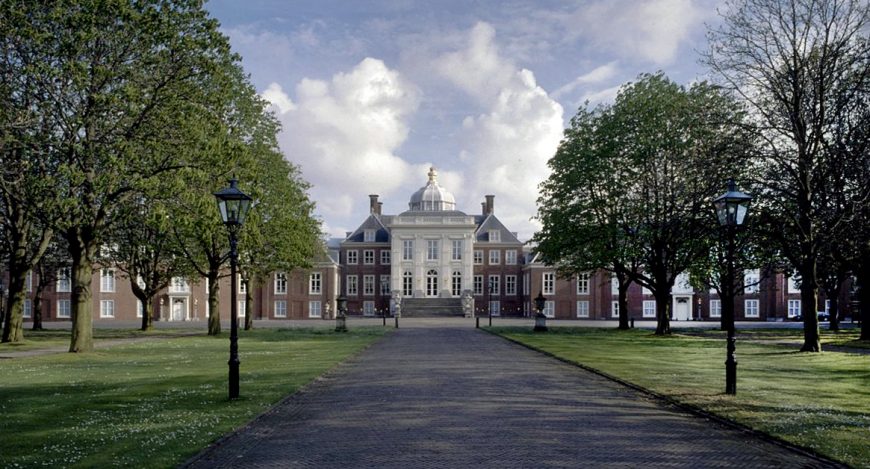
Situated in a wooded area just outside The Hague sits a small brick palace called Huis ten Bosch (House in the Woods). Designed, decorated, and built between 1645 and 1652 for the Princess of Orange, Amalia van Solms, Huis ten Bosch contains the best preserved decorative interior of the Dutch Golden Age: a lavish tribute to the role of the House of Orange in shaping the nation’s independence and success.
The building has had a complex history, and is one of very few surviving palaces built by the seventeenth-century Dutch nobility. In the 18th century, wings were added and its façade was replaced, and later it served as the first national art gallery, housed political prisoners, and was partially destroyed by bombs during World War II. These days, it is surrounded by tall fences and the apparatus of modern security, since it has resumed one of its original functions: to serve as the chief residence of the House of Orange, now the Dutch royal family. Through it all, the central room, called the Oranjezaal, has survived intact and its cycle of baroque canvases live to tell of the glories of the House of Orange.
The Patron
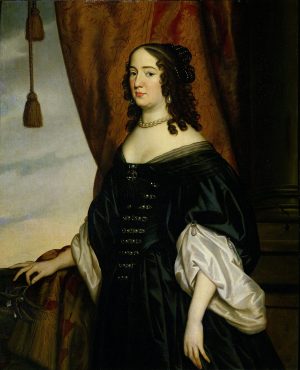
The House of Orange played an unusual—yet essential—role in the formation of the Dutch Republic. Since the time of William of Orange in the late 16th century, male members of the family traditionally held the position of stadtholder: head of the military as well as symbolic figurehead of the Republic. The stadtholder was not a king and was subject to the ruling body, the States General. Therefore, the House of Orange, who always sought to elevate their status to compete with landed nobility elsewhere in Europe, were frequently at odds with the republican nature of Dutch politics.
Amalia van Solms was a German princess who married the Prince of Orange, Frederik Hendrik, in 1625. In the years following her marriage, she raised five children, worked to create a glittering court culture, and collected art and decorative objects, including porcelain and gemstones. She was also politically very adept, trying to arrange the best possible marriages for her children and promoting her favorites at court to situate them to their (and her!) advantage.
By 1645, as the Dutch Republic approached independence and her husband’s health was failing, she was granted land on which to build a palace for her own personal use. She used this building as a venue to showcase the virtues of her husband and her family and to create a dynastic mythology that placed the House of Orange at the very heart of Dutch identity. In this way, she sought to preserve her husband’s legacy and her own social and political status.
Dutch classicism refined
Like the Amsterdam Town Hall, which was built around the same time, Huis ten Bosch was built in the Dutch Classicist style, which uses components derived from Italian architectural treatises by architects and writers such as Serlio, Scamozzi, and Palladio. The architect was Pieter Post, who had previously worked alongside the architect of the town hall, Jacob van Campen, on commissions like the Mauritshuis.
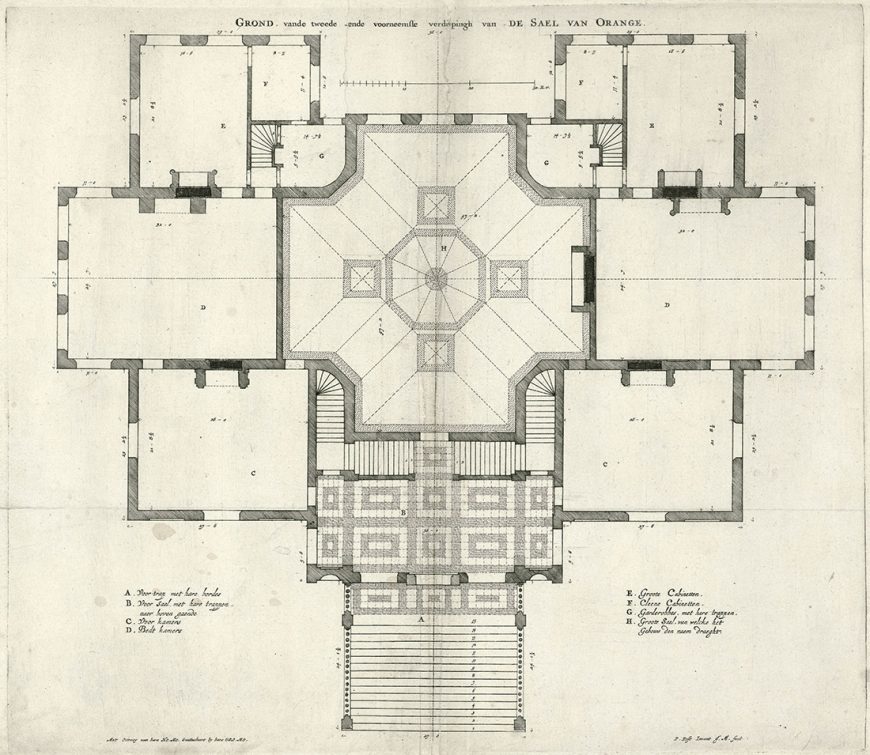
The floorplan of the Huis ten Bosch is structured around a cross-shaped hall—a distinctive and unusual feature which may have been based on villas designed by Palladio. On either side of the hall is a five-room apartment with a salon, a bedchamber, a study, and two smaller dressing rooms. Arranged in order from public to private, these spaces enforced social etiquette by controlling access to the resident. Amalia would have occupied the rooms to the east of the central hall; it is not clear who would have used the other apartment.
The Oranjezaal
The central room, known as the Oranjezaal, has received the most attention over the years because it is well preserved and is such a remarkable monument of the Dutch Baroque. The room contains a multi-story cycle of canvases and ceiling paintings that glorify the House of Orange. The cycle was coordinated by Jacob van Campen, but a team of a dozen artists from the northern and southern Netherlandish provinces did the actual painting.
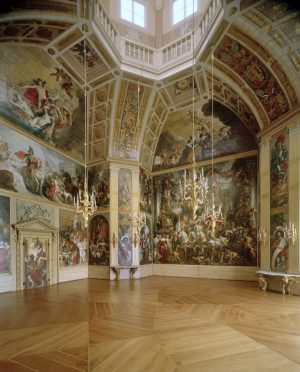
These artists included some who may be familiar, such as Jan Lievens and Jacob Jordaens, but also some less well-known painters like Pieter de Grebber or Gonzales Coques. The design committee selected these artists not only because they represented the best of Netherlandish art, both Flemish and Dutch, but also because they could paint in a Rubenesque style that would best suit the lofty nature of the commission.
The room tells the story of the Prince of Orange, including allegories of his birth, education, and military victories. Biographical scenes circle the room, unifying the space horizontally, while each major wall depicts a theme. The biographical scenes are situated above a fanciful triumphal procession that weaves through the room. Painted triumphal arches contain scenes of a parade of trophies including captives and material goods. These two levels of canvases are topped by thematically related scenes of classical mythology and surmounted by a domed roof and cupola painted with putti. The room has been compared to the Medici cycle painted by Peter Paul Rubens 25 years earlier: both are large, allegorical cycles commissioned by politically active widows who traded on their husband’s memory for dynastic advancement.
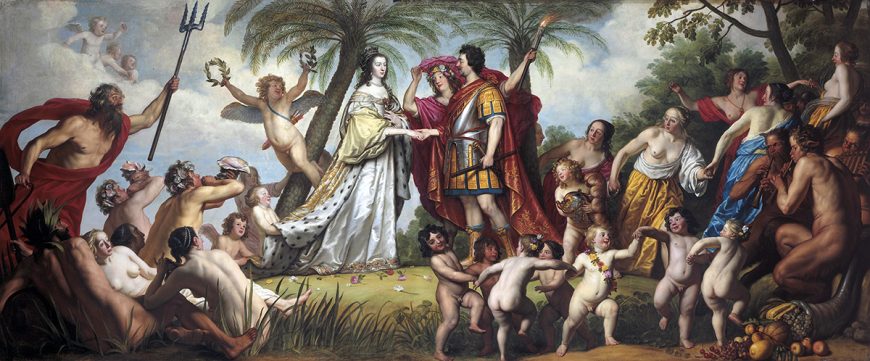

The first painting visible to a visitor entering the Oranjezaal from the foyer would have been an allegory of the marriage of Frederik Hendrik and Amalia. It was painted by Amalia’s favorite portrait painter, Gerard van Honthorst. The Prince and Princess stand with their hands clasped, in front of emblems of marriage drawn from Cesare Ripa’s iconographic handbook, Iconologia.
They are flanked by representatives of the sea on one side and the fruitful land on the other, the two sources of local pride and prosperity: the Dutch depended economically on overseas trade and a large maritime empire, while the land had particular significance for the newly independent region. The group of frolicking putti likely represent the different provinces of the Dutch Republic, dancing in unison because of this fortunate marriage.
Amalia herself is also represented in the Oranjezaal in two additional paintings by Honthorst: a portrait with her daughters (which concealed a secret door connecting to her rooms) and an octagonal bust-length portrait in the apex of the dome, through which she literally becomes the keystone of the house.
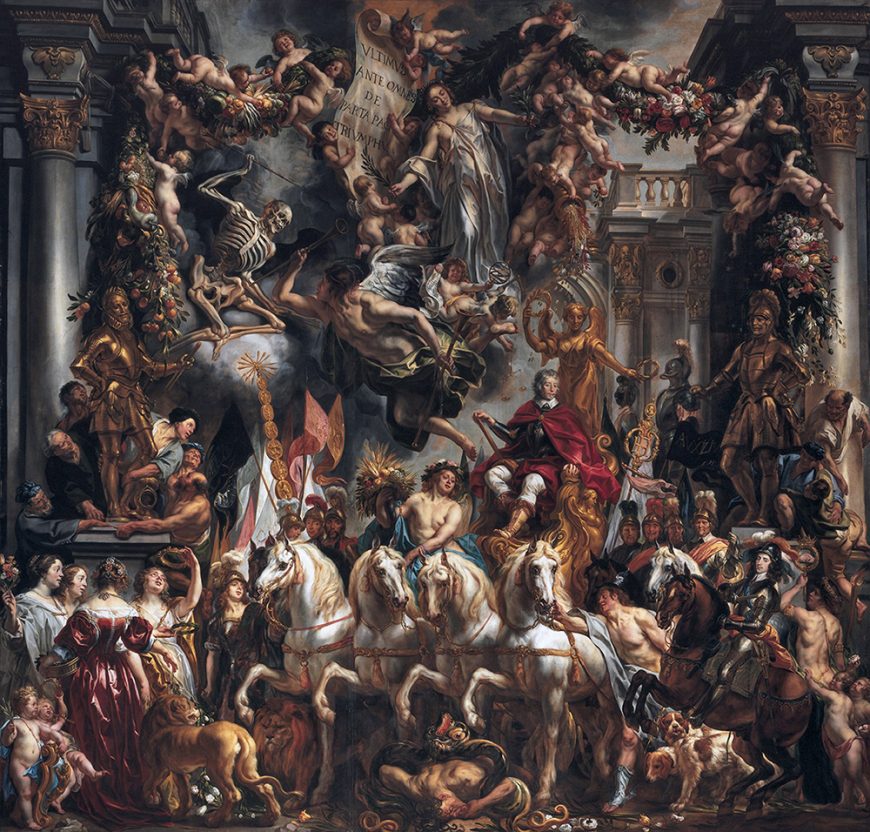
The cycle is dominated by the massive canvas on the east wall by the Flemish painter Jacob Jordaens, The Triumph of Frederik Hendrik. At 19 meters tall, it is possibly the largest single canvas produced during the seventeenth century in the Netherlands and shows a bombastic scene glorifying the recently-deceased prince. Draped in a red robe, he is seated in a chariot drawn by four white horses that trample his adversaries, while the flying allegory of Fame uses one of his trumpets to keep the specter of Death at bay. A statue crowns the Prince with golden laurels. His son and successor, Willem II, rides behind him in the triumphal procession. All of this is framed within tumbling garlands and groups of putti. It is a masterpiece of Baroque drama, glorifying—in the most grandiose visual terms—the role played by Frederik Hendrik in securing independence for the Dutch Republic from Spain in 1648.
The “New Artemisia”
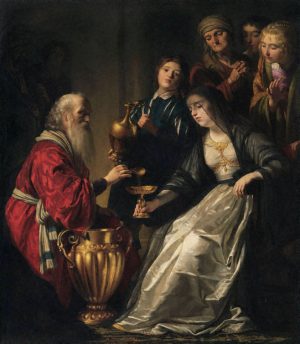
The building is simultaneously a house for the Dowager Princess and a mausoleum for the deceased Prince. One of Amalia’s private rooms was decorated entirely in ash grey satin. A painting by Honthorst of the ancient Greek figure of Artemisia of Caria was displayed in another room. According to Herodotus, Artemisia had cremated her husband Mausolus, mixed his ashes with wine, and drank them, becoming a living memorial to her deceased husband.
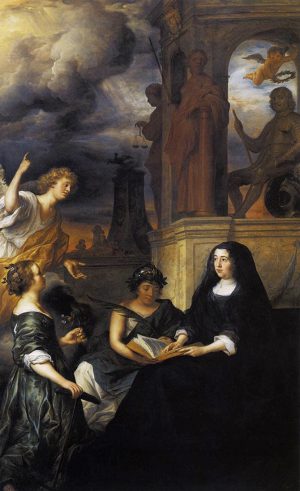
This theme of the vigilant, hopeful widow resonated with Amalia van Solms: for her cabinet, a room that would have been relatively private, she commissioned a painting by Govert Flinck that represents her in front of a fantastical tomb of her husband and son while a phoenix rises from the ashes in the background. Huis ten Bosch became the perfect site for Amalia to present herself as the grieving widow enshrining the memory of her husband, like a “New Artemisia”: a similarity consciously emphasized not only through imagery but also in texts by the architect and Princess Amalia’s private secretary.
While the memory of the Prince is ever present at Huis ten Bosch, so are representations of his descendants. Flinck’s painting emphasizes hope for the future as much as mourning for the past. Further, family portraits are prominently displayed in almost every room, balancing the past and the future and creating the perfect monument to the enduring role played not only by Frederik Hendrik and Amalia but by the entire House of Orange in shaping national history.
Additional resources:
Virtual tour of Huis ten Bosch
Maarten Loonstra, The Royal Palace Huis ten Bosch in a Historical View (Zutphen, 1985).
Margriet van Eikema Hommes. “‘As Though It Had Been Done by Just One Master’:Unity and Diversity in the Oranjezaal, Huis Ten Bosch.” In Aemulatio. Imitation, Emulation and Invention in Netherlandish Art from 1500 to 1800. Essays in Honor of Eric Jan Sluijter, edited by Anton W.A. Boschloo, Jacquelyn N. Coutré, Stephanie Dickey and Nicolette Sluijter-Seiffert (Zwolle: Waanders, 2011).
Koen Ottenheym, “Possessed by Such a Passion for Building. Frederik Hendrik and Architecture” in Princely display : the court of Frederik Hendrik of Orange and Amalia van Solms, compiled and edited by Marika Keblusek and Jori Zijlmans (Zwolle : Waanders Publishers, 1997).
The Town Hall of Amsterdam
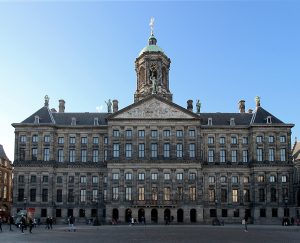
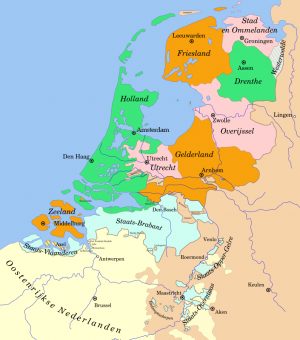
The Eighth Wonder of the World
The year was 1648. The United Provinces of the Netherlands had just been granted independence from Spain, marking the end of eighty years of war. Amsterdam, a hub of finance and trade, was positioned to take its place on the world stage as a great modern city.
However, its town hall, on the square facing the thirteenth-century dam on the Amstel River, was a dilapidated warren of cramped late-medieval buildings. The burgomasters of Amsterdam had already planned to erect a new town hall that would be the “eighth wonder of the world” and appropriately represent the city’s prosperity and status as a center for trade, but this project took on new significance with the declaration of peace and independence.
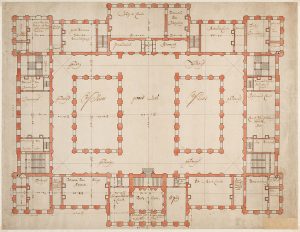
The winning design was submitted by the architect Jacob van Campen, and took over a decade to complete. The new town hall housed all of the administrative functions of the city of Amsterdam—serving as criminal court, magistrate, police office, city bank, armory, prison, tax office, mayor’s office, marketplace, and the center of political activity. It remained in use at the heart of the city until it was converted to a royal palace in 1806, when Napoleon Bonaparte installed his brother on the Dutch throne. Today the building still functions as a palace, but also serves as a museum and a monument to two important eras in Dutch history.
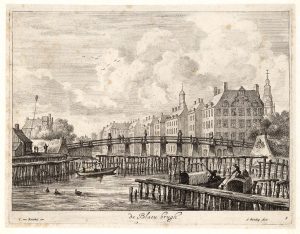
Dutch Classicism
Because the Dutch Republic in the seventeenth century had no monarchy and a much smaller aristocracy than other countries in Europe, there were fewer people commissioning monumental architecture. The marshiness of land upon which Amsterdam was built required driving piles deep into the ground to support construction and limited the scale of projects. Land for building plots tended to be thin and long, with narrow façades oriented toward the street. The local scarcity of stone also meant that brick architecture dominated.
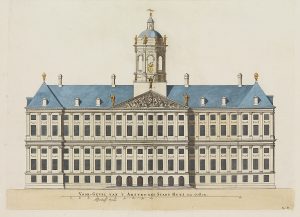
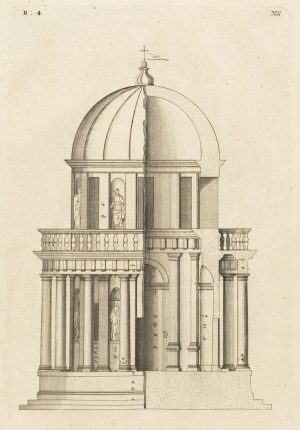
However, for large sites such as the town hall, architects like van Campen chose to build in stone and in a new style: Dutch Classicism. Architectural texts circulated widely in early modern Europe, and the writings of Italian Renaissance and Mannerist architects like Palladio, Serlio, and Scamozzi, in particular, resonated with Dutch architects. Dutch Classicism used the rules of symmetry and ideal ratios drawn from these Italian authors as well as classical sources like Vitruvius. The new style also incorporated surface application of pilasters, classicizing festoons, and allegorical sculpture. Compared to the typical local, small-scale brick architecture of Amsterdam, Dutch Classicism would have appeared striking and impressive.
For the town hall, van Campen designed a massive, symmetrical, orderly universe in miniature. Corinthian pilasters rhythmically divide the surface, while flanking pavilions subtly add bulk to anchor the corners of the composition and balance the larger central one. A cupola housing a bell salvaged from the old town hall dominates the roofline. The cupola, an otherwise jarring addition to the sober classicism of the rest of the exterior, may have been based on Bramante’s Tempietto, as illustrated by Palladio.
The interior is structured around the 120-foot-long barrel-vaulted Burgerzaal (Citizens’ Hall) that bisects the building on an east-west axis. This room is the same size as the central space of a basilica designed by Vitruvius, the only one for which he recorded dimensions. Two interior courts break up the mass, creating light wells that flank the Burgerzaal and provide light and airflow for both the central hall and the galleries. Offices were arranged around the exterior perimeter of the building.
A Wealth of Decoration
Rijksdienst voor het Cultureel Erfgoed)" aria-describedby="caption-attachment-22063" height="121" sizes="(max-width: 300px) 100vw, 300px" src="https://smarthistory.org/wp-content/...ed-300x121.jpg" srcset="https://smarthistory.org/wp-content/...ed-300x121.jpg 300w, https://smarthistory.org/wp-content/...ed-870x351.jpg 870w, https://smarthistory.org/wp-content/...891-edited.jpg 1200w" width="300">
Festoon with shells, exterior of Amsterdam Town Hall (Rijksdienst voor het Cultureel Erfgoed)
Dutch Classicism was not purely derivative. While van Campen carefully copied architectural components from prints after the Italians, his collaborator Artus Quellinus designed a universe of decorative sculptural festoons for the exterior. Rather than repeating one stock design across the entire façade, the festoons are varied and include the forms of fruit, flowers, sea creatures, ships’ instruments, and other symbolic representations.
The building instantly asserts through its exterior decoration that it is a temple to the newfound peace and prosperity of Amsterdam in the wake of independence. Both the east and west façades have a central projecting block with a pediment topped by sculpture. An 8,000-pound sculpture of Peace, accompanied by allegorical figures representing Prudence and Justice, surmounts the eastern pediment. The pediment itself contains a sculpture group representing the Maid of Amsterdam and the bounties of the sea. Meanwhile, the west façade supports Atlas, accompanied by Fortitude and Temperance. The western pediment contains allegories of the four continents and the benefits of global trade. The two façades balance each other: male and female, land and sea.
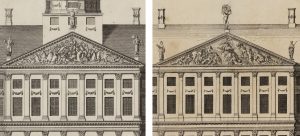
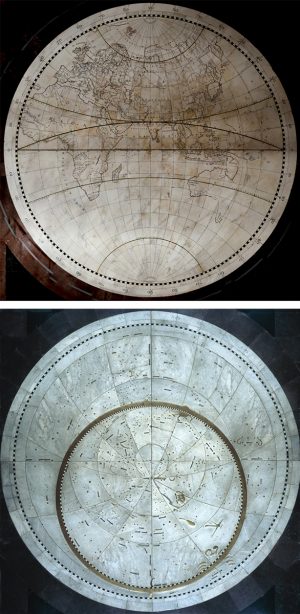
Microcosm of the World
Once inside, a visitor walks up a grand staircase into the Burgerzaal, which contains the universe in miniature: maps of the world are embedded in the floor flanking a representation of the skies of the northern hemisphere.
The southern hemisphere was initially intended to adorn the massive 90-foot barrel vault above. A viewer standing in the center of the room stood at the symbolic center of the world—watched over by sculptures of Atlas and the Maid of Amsterdam.
The entire interior is a unified decorative cycle carried out in expensive imported stone. Allegories representing the four elements, planets, virtues, and the bounties of land and sea act as wall decoration.
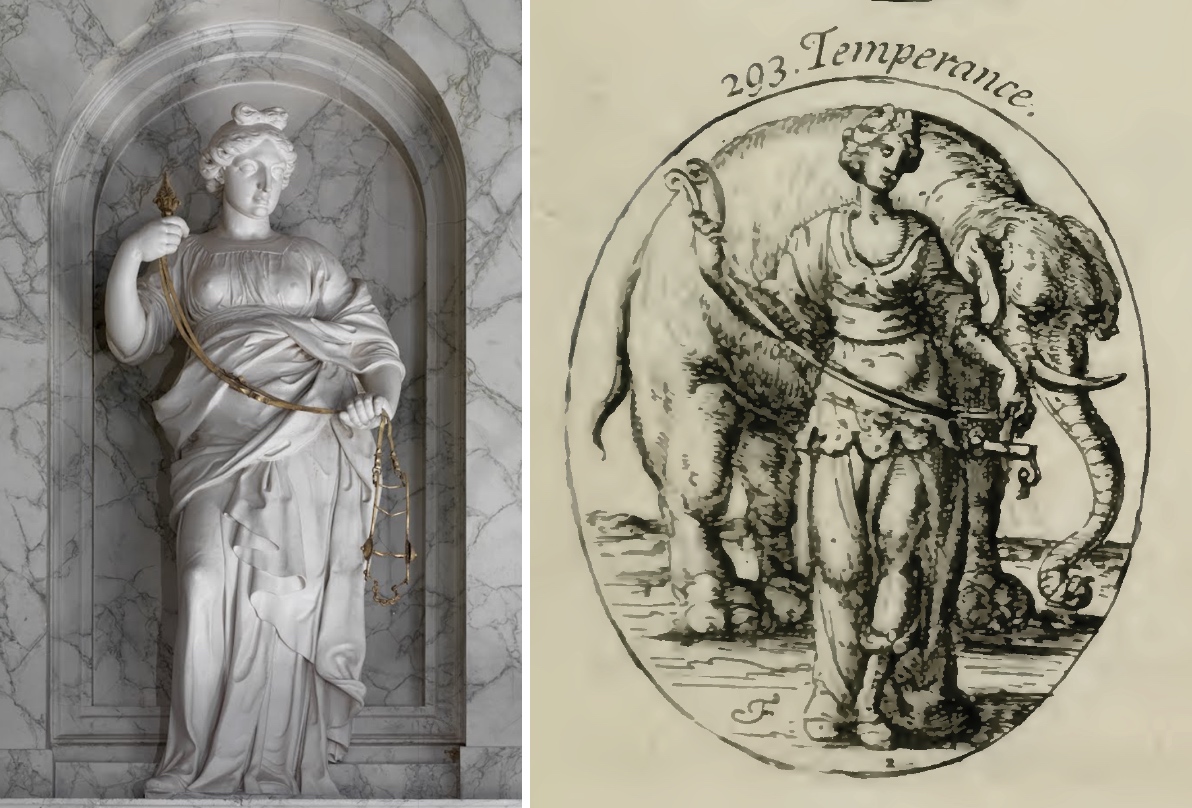
This imagery stems from Cesare Ripa’s Iconologia, an influential Italian iconographic manual originally published in 1593. It circulated widely throughout Europe and even appeared in a Dutch translation in 1644, and the dual representations of each element in the Burgerzaal closely correspond to Ripa’s descriptions. The times of day, sunrise and sunset, and the zodiac signs are also present. Representations of the planets lined the corridors, and were located closest to the offices with which they were symbolically associated.
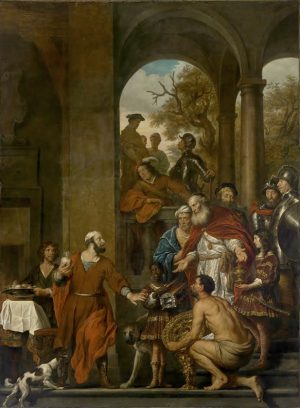
Rembrandt’s Failure?
Various media all worked together to emphasize personal and civic virtue throughout the offices. The mantelpieces in the larger offices emphasized the character traits city officials were intended to exhibit: humility, frugality, and responsibility. For example, Govert Flinck painted The incorruptible Consul Marcus Curius Dentatus, who, according to classical sources, preferred his humble turnips to the large, glittering bribe being presented to him. Each room’s mantelpiece consisted of a sculpted marble frieze and a poem relating directly to the subject of the painting.
In the galleries, the scope was even greater. Initially, Flinck was commissioned to produce a cycle of twelve monumental paintings illustrating the story of the Batavian uprising. In the Histories, Tacitus recounts the tale of the Batavians, a Germanic people who rebelled against Rome, gaining their independence. Since the late sixteenth century, the Batavians had been adopted not only as the mythical but as the as actual ancestors of the Dutch, who similarly refused to succumb to an empire. Flinck had worked as an assistant in Rembrandt’s workshop, but by the time of the Town Hall commission was a well-established independent master. The cycle was intended to illustrate the whole story of the rebellion as an allegory of the war against Spain. Unfortunately, he died before completing any of the cycle. The project was reduced in scale and split between a series of painters, including Jacob Jordaens, Jan Lievens, and Rembrandt van Rijn. Rembrandt’s contribution, The Oath of Claudius Civilis, was removed from the town hall for unknown reasons less than a year after its installation; a fragment survives in Stockholm, presenting one of the great puzzles of the Dutch Golden Age.
Splendor and symbolism
The interior and exterior decorative schemes function on several levels: they celebrate the peace and bounty of Amsterdam, provide visual models of virtuous classical and biblical leaders, and chronicle the mythic history of the Dutch. All of this is contained within a mathematically ideal and symbolically rich microcosm. It is designed to impress new visitors with the splendor and wealth of the Dutch Republic as well as to provide ongoing moral instruction to those who do business there every day.
Additional resources:
This building on the Google Art Project
Katherine Fremantle, The Baroque Town Hall of Amsterdam (Utrecht: Haentjens Dekker & Gumbert, 1959)
Eymert-Jan Goosens, The Palace of Amsterdam: Treasure Wrought by Chisel and Brush (Amsterdam: Waanders, 2010)
Baroque art in SpainSpain was the dominant power in Europe for much of the sixteenth and seventeenth centuries.
1600 - 1700
A Still Life of Global Dimensions: Antonio de Pereda’s Still Life with Ebony Chest
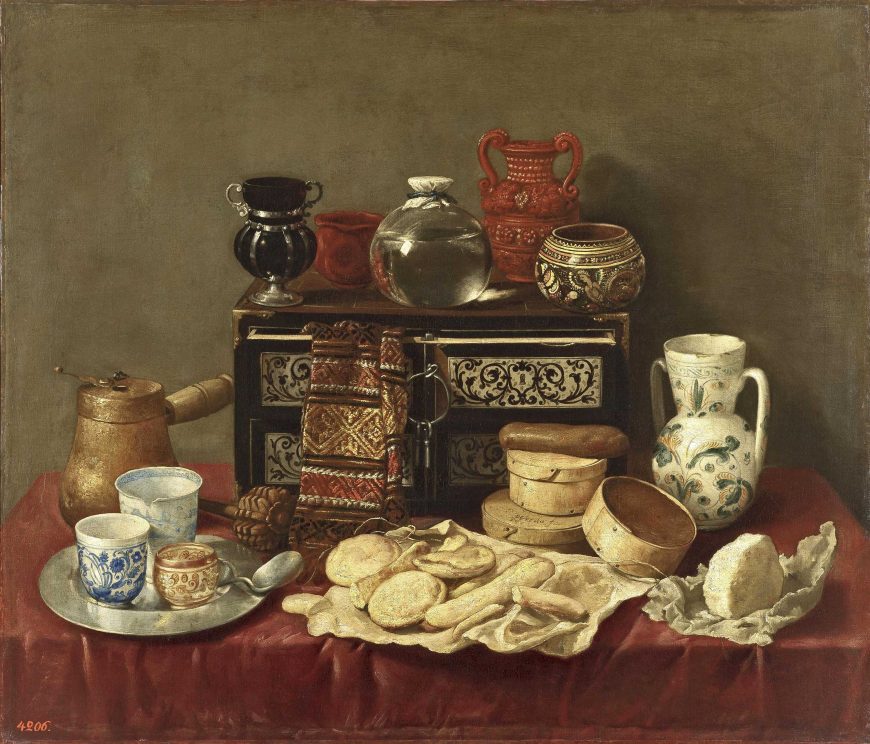
Obsessed with chocolate
In her Memoirs written in 1680, a person who went by Madame d’Aulnoy—presumably a French noblewoman visiting the Spanish court—wrote with dismay that Spanish ladies drank “six cups (of chocolate) one after another, and this they do very often twice or thrice a day.”[1] The vogue for this (at the time) exotic beverage is depicted in Antonio de Pereda’s Still Life with Ebony Chest, one of a series of still lifes he painted in the second half of the seventeenth century in Madrid.
The picture represents a group of objects related to the preparation, display, and consumption of chocolate. But why should we care about a bunch of painted vessels and other mundane things? In Still Life with Ebony Chest, Pereda visually elevates these seemingly insignificant objects, arranging them on a slightly tilted table so that they appear to tower over the viewer, while theatrical lighting adds drama to the scene. The table is covered with a red velvet cloth, a color associated with the monarchy and a staple of royal portraiture at the Spanish court. All of this contributes to the visual glorification of these objects—and by implication, of the social custom they illustrate.
The painting in fact represents what you would find if you were invited to a merienda (or afternoon snack) at a well-appointed home in seventeenth-century Madrid: one or more cups of chocolate made from cocoa from Mexico—which at the time was under Spanish control—and pastries served in wares from all over the world. The painting thus stands as a document of one of the most popular social rituals of the Spanish nobility, as well as the global dimensions of its rich material culture in the seventeenth century.
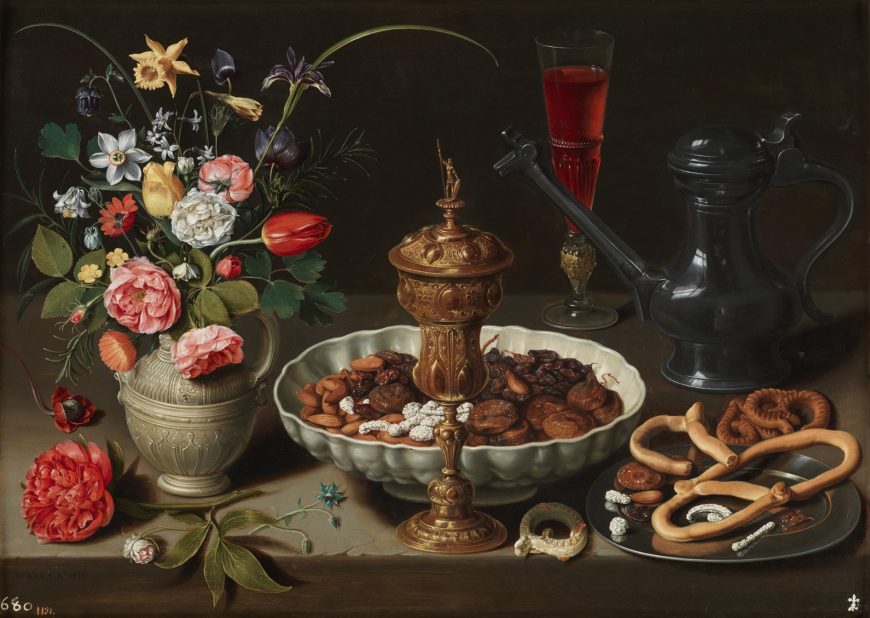
Still life in the seventeenth century
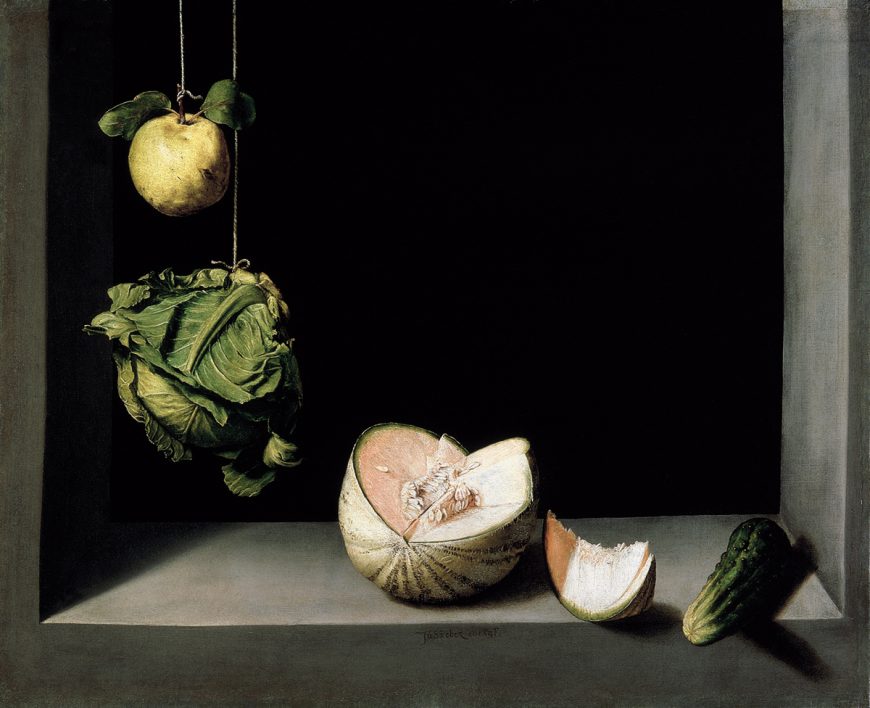
Some people today may think that still lifes are dull and meaningless, but in the seventeenth century they were among the most exciting genres of painting. Known to have existed in antiquity only through written descriptions, the painting of fruits, vegetables, and other inanimate objects appeared new and fresh to artists and audiences of the seventeenth century, accustomed, as they were, to paintings that portrayed edifying narratives based on the human figure. We don’t know exactly where the first independent still life was painted, but a number of examples with similar characteristics seem to have appeared simultaneously in Spain, Italy, and the Netherlands at the turn of the 17th century.
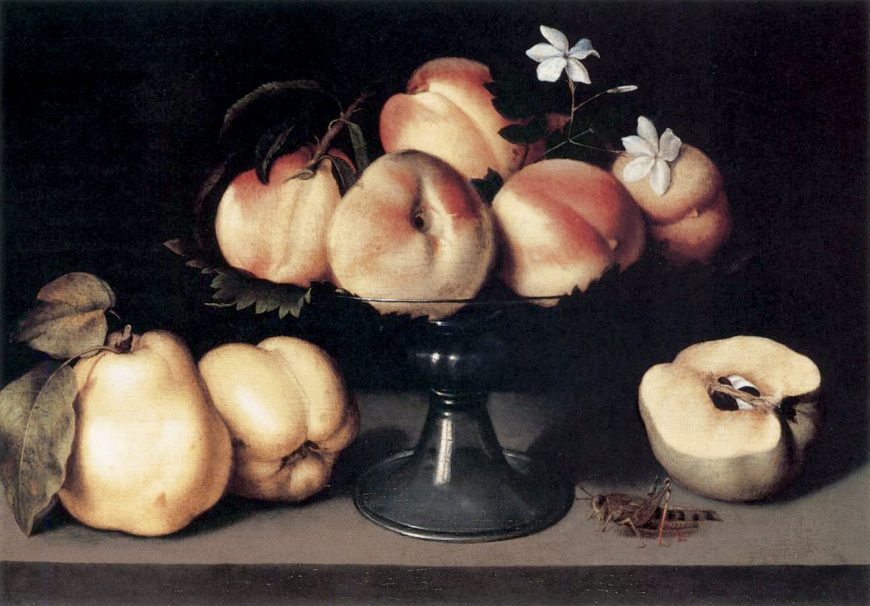
Juan Sánchez Cotán in Spain, Fede Galizia in Italy, and Clara Peeters in the Netherlands are among the first artists who established the conventions of the new genre: a few objects set against a neutral background painted with unprecedented naturalism and meticulous detail. Although for much of the twentieth century scholarship was concerned with stylistic evolution and religious symbolism in these paintings, today there is a growing interest in approaching them from the perspective of material culture. This means not only asking questions about how the pictures functioned in their original contexts, but also examining the cultural significance of the objects they represent.
A painting of global dimensions
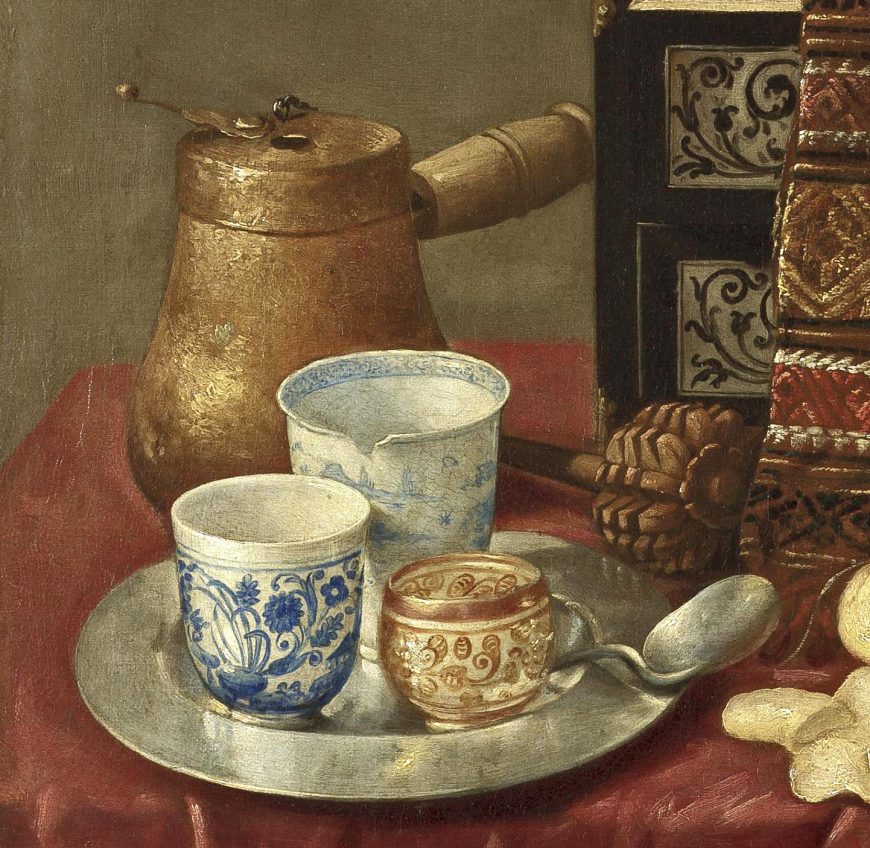
Pereda’s picture probably hung on the walls of a well-to-do Madrilenian household in which meriendas involving chocolate must have been common. It presents a rich collection of objects of different provenance. Starting on the left, you’ll notice a pear-shaped copper vessel with a wooden handle. This is a chocolatera or chocolate pot, and next to it there is a wooden whisk to stir the chocolate and make it frothy. In the seventeenth century, chocolate was still an exotic product, although it had been introduced to Spain from Mexico during the century before. The Aztecs—who considered the beverage precious and used it in religious rituals—drank the cocoa unsweetened, but once it was brought to Europe, it was substantially transformed. Spaniards added sugar and spices and made it the center of elite social gatherings.
In his picture, Pereda alludes to these get-togethers with the inclusion of a wide array of wares. In front of the chocolatera you can see a silver tray with three cups and a spoon. The three cups—called jícaras, from the Nahuatl xicalli—were used specifically to drink chocolate, and according to some scholars, each of them has a different origin: the blue cup is probably from Delft in the Netherlands (although imitating Chinese porcelain), the small lusterware (a technique used in Muslim Spain) bowl is from Manises in eastern Spain, and the larger one in the back is from China. Next to the tray there is a plate full of pastries, probably for dipping in the chocolate, and next to this are several wooden boxes containing cocoa paste. Behind the boxes there is a vase with two handles from Talavera in central Spain, and in the foreground on the lower right there is a piece of cheese or sugar to complement the chocolate (in Colombia people still drink their chocolate with cheese today).
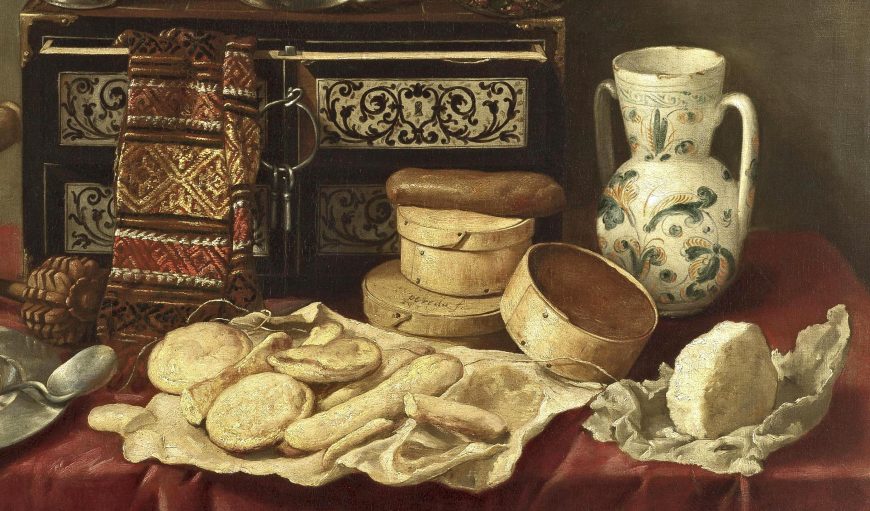
The small piece of furniture that centers the composition is an ebony chest decorated with ivory: a luxury object used to keep treasured belongings such as chocolate. It is made of exotic materials— ebony, likely from India, Angola, Gabon, or Indonesia, and the ivory, made of the tusks of African or Indian elephants. Notice the set of keys hanging from the first slightly open drawer, and the intricately woven cloth. The latter—perhaps produced in Guatemala, Mexico, or even China—was known as paño de chocolate ( “chocolate cloth”) and was used to wipe chocolate foam from one’s mouth or the spoon before drinking.
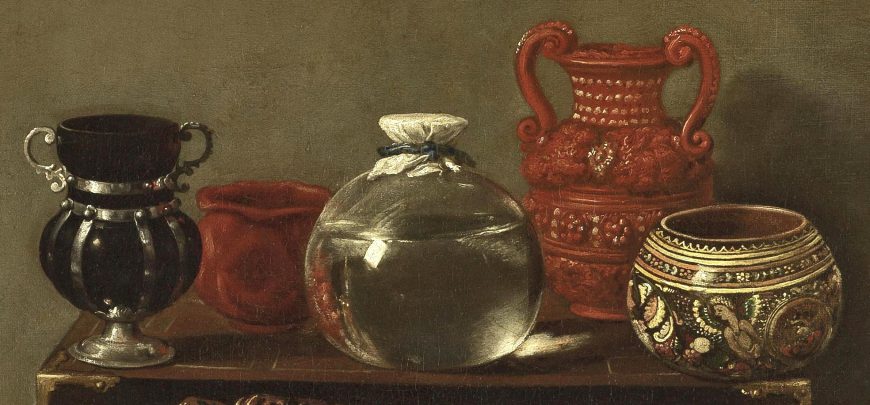
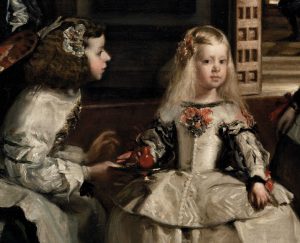
The reds in this cloth lead us toward two bright red vessels resting on the chest. These pots are two types of so-called búcaros, earthenware vessels used to cool water and appreciated for their aroma and taste. Spanish women (and sometimes men) ate little pieces of these wares as if they were candies, and some believed they had special properties, such as the ability to whiten the skin or prevent pregnancies. Although they were originally from Portugal, by the seventeenth century búcaros were also produced in several Spanish American colonies. In Diego Velázquez’s celebrated Las Meninas, the infanta Margarita is portrayed receiving a small búcaro. Scholars have identified the shorter, simpler búcaro in Pereda’s painting as being from Guadalajara, Mexico, and the larger one—called enchinado because it is decorated with small fragments of quartz—as likely being from Chile.
Additionally, we find a black vessel with silver mounting that is probably of European origin, a transparent glass vessel with water or aloja (an aromatic wine from Southern Spain), and a lacquered (a Japanese technique) gourd cup decorated with flowers and winged figures of Mexican or Italian origin.
Showing off skill

These objects exemplify how people in the seventeenth century interacted with a global world in their daily lives and, more specifically, how elite Spaniards enjoyed the fruits of the large Spanish empire. Some of these connections were quite complex and are wonderfully illustrated here: The Delft jícara, for instance, is a ceramic cup made in the Netherlands, imitating Chinese designs, and used to drink chocolate from Mexico in a Spanish household.
The owner of this painting must have been proud to have such an array of worldly goods represented in a painting that was itself a precious possession. The painter’s task, in turn, was to represent these objects as faithfully as possible: on the one hand, so that the viewer could identify the objects; on the other, to show that painting can imitate all the other crafts. Notice how carefully Pereda imitates other materials and how he shows off his skill by depicting the way these materials are reflected on various surfaces. Red and black are reflected on the glass vessel and the whisk is visible in the surface of the silver tray. If you look closely, you can see Pereda’s signature in one of the boxes. From the perspective of the artist, the painting seems to be a celebration of global craftsmanship as much as his own.
Notes:
- Madame D’Aulnoy, Travels into Spain, edited by R. Foulché-Delbosc (London and New York: Routledge, 2004), p. 212.
Additional Resources:
This work at the Hermitage Museum
Essay on Antonio de Pereda y Salgado from the Museo del Prado (in Spanish)
“A Brief History of Chocolate” from Smithsonian Magazine
Essays on bodegones (still life genre) from the Guggenheim and Oxford Bibliographies
Anne Gerritsen and Giorgio Riello, “The Global Lives of Things: Material Culture in the First Global Age.” In Anne Gerritsen and Giorgio Riello eds., The Global Lives of Things: The Material Culture of Connections in the Early Modern World (Routledge, 2015), pp. 1-28.
Byron Hamman, “Interventions: The Mirrors of Las Meninas: Cochineal, Silver, and Clay.” The Art Bulletin vol. 92, issues 1/2 (2010), pp. 6-35.
William Jordan ed., Spanish Still Life in the Golden Age, 1600–1650 (Kimbell Art Museum, 1985).
William Jordan and Peter Cherry, Spanish Still Life from Velázquez to Goya (National Gallery, 1995).
Cinta Krahe, Chinese Porcelain in Habsburg Spain (Centro de Estudios Europa Hispanica, 2016).
Marcy Norton, “Tasting Empire: Chocolate and the European Internalization of Mesoamerican Aesthetics.” The American Historical Review , vol 111, issue 3 (2006), pp. 660–691.
Marcy Norton, “Foreword.” In Stacey Schwartzkopf and Kathryn E. Sampeck eds., Substance and Seduction: Ingested Commodities in Early Modern Mesoamerica (University of Texas Press, 2017).
Natacha Seseña, El vicio del barro (Ediciones El Viso, 2009).
Juan Sanchez de Cotán, Quince, Cabbage, Melon and Cucumber

Stark, spare, meticulous
This starkly simple still life by Juan Sánchez de Cotán is the kind of life-long puzzle that makes for great contemplative fodder on long plane rides and sleepless summer nights. What could a cabbage, a cucumber, a melon and quince mean? Is there some underlying universal truth at the heart of their stark, spare, meticulous arrangement within the window’s inky, impenetrable darkness? Completely different from the voluptuous pronkstilleven, the ostentatious seventeenth-century still lifes of Dutch art—with their luscious lobsters, silver chargers and glass vessels strewn in careless abandon (as in the example below), Cotán’s pristine austerity is akin to a vegetal altar.

Cotan was a pioneer of the Spanish still life bodegón, an arrangement of simple foodstuffs. Some historians have suggested he drew his inspiration from his own ascetic Carthusian piety (the Carthusians are an order of monks that live in seclusion and devote themselves to prayer). Born in Orgaz, his art developed in completely the opposite direction from El Greco, whose profuse and luxurious altarpiece of the Burial of Count Orgaz is located in the Cathedral of San Tomé, Toledo, where Cotán had a studio. His still lifes, however, belong to his secular period before entering the monastery, after which he took up religious painting, later electing to leave the monastery and dying as a lay brother in Granada.

Archimedes’ hyperbola
If these still lifes are not ascetic deliberations, or early meditations on vegetarianism, what could they possibly mean? What of the quince and cabbage, suspended, as was typically done in country kitchens, to keep them from spoiling? Why a sectioned melon, seeds exposed, a quivering sliver sitting on the sill beside the cut fruit? The final member of the quartet is the intact cucumber, pushed over the edge of the sill toward the viewer, completing a sequence of gradual emergence from the window’s depths. In fact, the gradual, emergent curvilinear plane has been compared to Archimedes’ hyperbola, suggesting that such paintings, which were generally made for an educated, secular clientele, were perhaps understood as geometric meditations (Archimedes was a third-century B.C.E. Greek mathematician and astronomer).
Archimedes was first translated and published by Federico Commandino in 1565 (Archimedis De iis quae vehuntur in aqua libri duo/ a Frederico Commandino restituti et commentariis illustrate), at approximately the same time that he published his own De Centro Gravitatis. Commandino’s work was followed by Luca Valerio’s De Centro Gravitatis in 1604—confirming a strong contemporary interest in spherical bodies that might be related to Cotán’s still-life experiments.

Empire and conversion
Others have suggested that the arrangement of spheres and sectioned semi-spherical fruits and vegetables is to be understood in terms of astronomy, a representation of celestial bodies moving against the night sky, possibly in relation to celestial navigation. Spain was, of course, at the forefront of exploration in the fifteenth and sixteenth centuries. Or, they could represent specific celestial bodies in their various phases, although Galileo did not turn his telescope toward the moon until 1609. Finally, all four of the items here were introduced from Europe for cultivation in the New World, perhaps alluding, however obliquely, to Empire and conversion.
Diego Velázquez
Diego Velázquez, The Waterseller of Seville

Diego Velázquez was originally from the southern Spanish city of Seville. Though he began his career painting genre scenes (images of everyday life) that were often redolent with religious undertones, in 1623 he was ordered to paint a portrait of King Philip IV. Although unfortunately now lost, that portrait secured his future and he was named official painter to the king, a position he served until his death. Although he created many portraits of members of the royal family, Las Meninas is by far his most famous and technically brilliant work.
Just one year before his death in 1659, he received the Knighthood of Santiago, an honor he yearned for his entire life (during this time artists were generally not permitted to ascend to noble rank by the mere fact that they worked with their hands).

Seville in the sixteenth century
Seville was once the largest city in Spain, with a population of around 130,000 people—quite a large population for early modern Europe. It was also the most culturally diverse city in Spain. As a port city (see the image above) Seville was the main hub for trade between Europe and the Americas. Merchants from across the continent frequented the city, bringing with them artworks and other fine commodities. Wealth poured into Seville and some even remarked that the city was so wealthy that the streets could be paved with silver and precious gems.

While on the surface there was much to admire about this cosmopolitan city, there were also the common realities that come with large cities. Harsh distinctions in social class left a minority of wealthy people surrounded by a desperate group of impoverished citizens. In addition, Seville was a stop along the slave trade route and most middle and upper-class citizens in Seville owned slaves.
Bodegones
The painting, The Waterseller of Seville is often labeled as a bodegón. Derived from the word bodega, which means tavern in Spanish, bodegón was a term used to describe artistic representations of daily life, and particularly those associated with food. Essentially these are genre scenes with still life objects.

Velázquez certainly was not the first artist to paint bodegones. By the time he painted The Waterseller of Seville, Netherlandish artists such as Pieter Aertsen had already established themselves as masters of still life and genre painting (see below). The movement was also gaining momentum in Italy where Caravaggio and others explored ordinary people in ordinary places. There were even some Spanish painters whose still lifes and kitchen scenes had tremendous influence on Velázquez. Velázquez departed from these other works by making his compositions more simple—pared down to only a few figures and objects.

As a fairly new genre relatively speaking, Velázquez’s bodegones were not well-received by some traditional artists. Despite these reservations, there were many other artists and patrons who were fascinated with genre scenes and Velázquez found a market for his works. With their earthly color palettes, dramatic lighting and understated backgrounds, these works reveal the influence of Caravaggio. Set in kitchens or taverns, the bodegones portray the simple nature of daily life and demonstrate a naturalism and verisimilitude that was unparalleled by Velázquez’s contemporaries.

The Waterseller of Seville
In the center of the compacted composition stands the monumental profile figure of the Waterseller, aged from the hot sun and donned in a humble brown cloak. He offers a boy a glass of water, freshened by a fig, which he has just poured from the large clay vessel in the immediate foreground. Although they are physically connected to one another as they both hold the glass, the boy and old man do not make eye contact but instead stare past one another. Perhaps their difference in age prevents a connection between the two, or perhaps it is their difference in social status. The face of a young man emerges from the shadows of the background between the old Waterseller and the boy. He stares out at the viewer while drinking from his mug. Within this painting we see three ages of man represented.

While Velázquez has dismissed any background details in favor of the figures in the foreground, we can assume by the objects that this scene is taking place inside or near a tavern. The light coming from the left not only illuminates the face of the young boy, but also draws attention to the beads of water trickling down the slightly misshapen curve of the water vessel. This painting is a tour de force of naturalism; the textures of the clothes, jugs, glass, and even the waterseller’s face are meticulously rendered using a combination of thick and tiny dabs of paint. The naturalism is as much the subject of the work as the Waterseller himself.

Watersellers

Although watersellers were a common feature in any urban landscape of early modern Europe, they were especially prevalent in Seville, known for its long and brutal summers. As marginalized figures, contemporary literature and imagery often represented watersellers as beggars or cheats who routinely fought with their customers.
However, in Velázquez’s depiction, there is nothing of the scoundrel type that one would expect from a waterseller. Some have argued that this is an idealized representation that does not depict the true nature of this impoverished class—a class that was growing ever larger during this time. Others argue that this painting is not concealing the harsh realities of poverty, but rather imbues this waterseller with both monumentality and dignity.
Additional resources:
Jonathan Brown, Collected Writings on Velázquez (New Haven: Yale University Press, 2008).
Jonathan Brown and Carmen Garrido, Velázquez: The Technique of Genius (New Haven: Yale University Press, 1998).
Tanya J. Diego Tiffany, Velázquez’s Early Paintings and the Culture of Seventeenth-Century Seville (University Park: The Pennsylvania State Univesrity Press, 2012).
Barry Wind, Velázquez’s Bodegones: A Study in Seventeenth-century Spanish Genre Painting (Fairfax: The George Mason University Press, 1987).
Diego Velázquez, Los Borrachos (The Drunks), or The Triumph of Bacchus
by DR. BETH HARRIS and DR. STEVEN ZUCKER
Video \(\PageIndex{21}\): Diego Rodríguez de Silva y Velázquez, Los Borrachos (The Drunks), also known as The Triumph of Bacchus, 1628-1629, 165 x 225 cm (Museo Nacional del Prado, Madrid)
Diego Velázquez, Vulcan’s Forge
by BETH HARRIS and STEVEN ZUCKER
Video \(\PageIndex{22}\): Diego Velázquez, Vulcan’s Forge, c. 1630, oil on canvas, 223 cm x 290 cm (Museo del Prado, Madrid)
Speakers: Dr. Beth Harris and Dr. Steven Zucker
Diego Velázquez, The Surrender of Breda

What defines a great leader
How military leaders treat their vanquished enemies conveys much of their character. In early modern Europe, paintings of military victories usually followed a preconceived structure: the victorious commander appeared seated high on his horse, or on a throne, while the capitulating general would kneel on the ground. Degraded and humiliated, the conquered army leader would prostrate himself in submission to the contempt of the triumphant general. But what happens if these dynamics are shifted? What would an image of an honorable commander showing respect for a conquered army communicate? Would a magnanimous leader be seen as weak? And how could abstract concepts such as honor or magnanimity be represented? Velazquez’s The Surrender of Breda revolutionized the genre of military painting precisely by emphasizing that to win with elegance and magnanimity is what defines a great leader, and not merely the ferocious capacity to triumph in combat.
A commission from the King of Spain
Between 1630 and 1635 the Spanish king Philip IV commissioned the construction of a royal palace just outside of Madrid. The Surrender of Breda was one of the paintings that decorated the most lavish room in that palace, the Hall of Realms. This multipurpose room had two important functions; it was a throne room, and it was a place for music and theatrical performances. As such, the Hall of Realms was the space where emissaries and ambassadors were received and entertained. When visitors entered the room, they encountered a highly ornate space decorated with large paintings that celebrated the Spanish king’s military victories. The Surrender of Breda is one of these paintings. It commemorates the capture of the city of Breda during the Eighty Years’ War, a conflict between Spain, which controlled the Low Countries, and the Dutch, who were fighting for political independence.

The aftermath of battle
Though the painting depicts a military victory, Velázquez removed the bloody and violent aspects of the battle from the canvas. Instead, he chose to present the aftermath of the battle: the capitulation of the Dutch to the Spanish troops. It is important to notice how Velázquez established the difference between these two groups. The Dutch, on the left, appear disorganized, youthful, and few in number. This contrasts with the Spanish troops located on the right, which are presented as a large, well-organized, and seasoned group. Velázquez’s depiction of the spears, vertically rising over the horizon, has received much attention, to the point that the painting is also known as The Lances. The numerous spears create a sense that there are more Spanish troops than we can actually see and, because of their ordered arrangement, they emphasize the military competence of the Spanish soldiers.

A painting about magnanimity
The center of the painting is dominated by the exchange of the keys. Ambrogio Spinola, the captain of the Spanish troops, receives the keys of the city from Justinus van Nassau. Having descended from his horse, and looking at the Dutch commander eye-to-eye, Spinola places his hand over Justinus’ shoulder, most likely in order to stop him from kneeling. This respectful gesture separates The Surrender of Breda from typical surrender scenes. In The Surrender of Breda, the battle remains in the distance, only noticeable because of the smoke columns rising in the background. It is the human encounter, in the foreground, that Velázquez emphasized. Hence, it is a painting about magnanimity as much, if not more, than a painting about military prowess.
Not a document of the event
Some aspects of the painting correspond to the historical reality of the event. After the siege, Spinola granted the Dutch army very generous terms of surrender; he ordered the Spanish army to respect the Dutch, who were allowed to leave Breda in military formation and carrying their ensigns. However, we should not let Velázquez’s naturalistic style deceive us. The Surrender of Breda is not a faithful reproduction of the event. It is highly unlikely that the encounter between the two commanders took place as depicted. The painter, who was not present at the siege of Breda, carefully constructed the scene to commemorate Spinola’s magnanimous character, not to document an event. Velázquez has subtly emphasized the figure of Spinola who, holding a baton of command, wears a distinct, splendid armor and a vivid magenta sash. At the same time, Velázquez’s astonishing skill is precisely shown in the easiness with which he transforms the viewers into eyewitness to an impromptu encounter. The muted earth tones and a soft light give the painting a naturalistic character. Without blatant symbols, allegorical figures, or even idealized figures, the viewer is invited to encounter the scene as if they had been there.
The painting presents a humane encounter in the midst of the chaos and cruelty of war. But we should not think that there are no ulterior motives for the presentation of this seemingly virtuous moment. Spinola, the Spanish troops, and by extension Philip IV, are presented as powerful and honorable. Thus the painting operates at multiple levels: it is a rhetorical exaltation of Spanish national identity, a symbol of Philip IV and his army, and a tribute to Spinola, a personal friend of Velázquez who had died a few years before the commission of the painting.
Additional resources:
This painting discussed on “Art Through Time”
Diego Velázquez, Juan de Pareja
by THE METROPOLITAN MUSEUM OF ART
Video \(\PageIndex{23}\): Julie Mehretu on Velázquez’s Juan de Pareja (1650). “Looking at his expression I’m moved, almost to tears. That’s not often that a painting can do that.”
Diego Velázquez, Las Meninas
by DR. BETH HARRIS and DR. STEVEN ZUCKER
Video \(\PageIndex{24}\): Diego Rodríguez de Silva y Velázquez, Las Meninas, c. 1656, oil on canvas, 125 1/4 x 108 5/8″ / 318 x 276 cm (Museo Nacional Del Prado, Madrid)
Francisco de Zurbarán, The Martyrdom of Saint Serapion
Soldier, friar, hostage, martyr, saint
St. Serapion’s life reads much like a medieval action-adventure drama, but it’s his death that we are left to meditate on.

Accounts conflict about Serapion’s origins—some say that he was born in England, others in Ireland or Scotland. What is known is that he was a soldier in the army of King Richard I (the Lionheart) and later that of Leopold VI, Duke of Austria. He then went to Spain to participate in the Reconquista (the Christian “reconquest” of parts of the Iberian penninsula—today Spain and Portugal—that had been under Islamic rule) before becoming a friar in the Mercedarian Order. This order was founded in Spain to ransom Christians who had been captured by Muslims. There are several conflicting accounts of Serapion’s martyrdom—one story has him martyred by pirates off the British coast, another says he was left for dead, recovered and then was killed in Algiers. According to the Mercedarians, Serapion made several successful hostage rescues. During the last captive exchange the ransom money took too long to reach Algiers and Serapion was killed. The saint was nailed on an X-shaped cross like the Apostle St. Andrew, and dismembered or disemboweled.
Tenebrist drama

This horrific martyrdom is the subject of this seventeenth-century painting by the Spanish painter Francisco de Zurbarán. None of the grisly details are evident in this painting—Zurbarán chose to convey this event as a still and contemplative scene. The three-quarter-length figure of Serapion takes up most of the composition; his lifeless body robed in his beige habit emerges from a dark background. The tenebrism (the intense contrast between light and dark) provides a dramatic illumination of the saint’s body and is characteristic of Baroque art in the style of Caravaggio. One can imagine that in a dimly lit room the intensely realistic figure would appear to be emerging from the darkness into the viewer’s space. The only reminder that this is indeed a painting is the small piece of paper where Zurbarán identified Serapion and signed and dated the work.
Monastic patrons
Zurbarán’s primary patrons were monks. He and his workshop sometimes lived in the monasteries they worked for and thus were able to experience and understand the lifestyle of the Order. Monastery life varied from order to order but monks generally woke early to pray and prayed several times a day while also tending to their work around the monastery—writing, copying books, studying scripture, and/or physical labor. Most observed long periods of silence which was meant to free the mind and soul to contemplate God.
Zurbarán’s realism and austere, spiritual aesthetic made for a style that was well-suited for the quiet and contemplative monastic environment. This particular painting was displayed in a room where deceased monks were laid out before their burial—so in this sense it was a funerary image. Monks reflecting on death would be confronted by this image of martyrdom and all its spiritual connotations.

The Mercedarian Order was founded on the notion of self-sacrifice, ransoming and taking the place of captive Christians. Many in the Order met bloody deaths like Serapion and this element of their origin was ever-present. Zurbarán depicted Serapion with his arms stretched up and tied to a faintly visible tree. His pose is reminiscent of Christ on the cross, and the fact that Serapion willingly risked his life (as did many Mercedarians) echoes Christ’s own sacrifice. Zurbarán favored a largely monochrome color scheme that adds to the subdued tone of the work. The muted browns and cream colors are pierced only by the small yet prominent red and yellow Mercedarian badge on the saint’s torso.
Martyrdom in the 17th century

Scenes of martyrdom enjoyed particular popularity in seventeenth-century Spain where the Counter-Reformation spirit was strong (the Counter-Reformation was the Catholic Church’s response to the Protestant Reformation). In England, King Henry VIII’s of Act of Supremacy (which made the King the head of the Church of England) resulted in the persecution of Catholics, especially between 1534 and 1680. The reign of Queen Elizabeth was particularly bloody with many of the martyrs killed by being hanged, drawn, and quartered. St. Serapion was painted in 1628, right in the midst of that persecution. Zurbarán was also commissioned by the Carthusian Order to paint the martyr St. John Houghton who was killed in England by being hung, drawn, and quartered. It is worth noting that Serapion is associated with Britain, whether he was born there or not, he is said to have spent time preaching and recruiting for the Order in London.
Serapion was beatified (the third in four steps to becoming a saint) in 1625 by Pope Urban VIII and by doing so he was symbolically recalling England’s tradition of martyrs for the faith and providing a model for those who were suffering persecution and the threat of a similar death. In the painting of St. John Houghton, Zurbarán also omitted any bloody details, instead showing the saint holding out his heart and wearing a noose around his neck. Similarly, St. Serapion’s copious garments conceal any violence done to his body, though his open habit is a reference to his body being cut open. Except for a small welt on his forehead, Zurbarán has omitted any obvious signs of trauma.

Compare these images by Zurbarán to the Martyrdom of St. Bartholomew, by his contemporary, José de Ribera, which details the torturous peeling off of the saint’s skin, revealing his blood and muscles. In bypassing the horror of the method of death and conveying a peaceful scene, Zurbarán has emphasized the eternal reward of heaven.
Jusepe de Ribera, The Martyrdom of Saint Philip
by DR. BETH HARRIS and DR. STEVEN ZUCKER
Video \(\PageIndex{25}\): Jusepe (José) de Ribera, The Martyrdom of Saint Philip, 1639, oil on canvas, 92 x 92″ / 234 x 234 cm (Museo Nacional del Prado, Madrid)
The English Romantic poet, Lord Byron, wrote that the artist, “Spagnoletto [the little Spaniard] tainted / His brush with all the blood of all the sainted” (Don Juan , xiii. 71).
Juan Martínez Montañés and Francisco Pacheco, Christ of Clemency
“The Lord Christ crucified must be [portrayed] alive, before having expired, with his head inclined to the right side, looking toward whatever person might be praying at his feet, as though Christ himself were speaking to him or her, and as though complaining that what he is suffering is for the sake of the one praying. And so the eyes and face of Christ should have a certain severity, and the eyes should be completely open.”
So says an early seventeenth-century contract stipulating the appearance of a sculpture of Christ on the cross for Seville Cathedral. The crucifix’s patron, Mateo Vázquez de Leca, the archdeacon of Carmona (a position at the Seville Cathedral), went to great length to instruct the artists on how he wanted this sculpture to appear. Today, it is known as the Cristo de la Clemencia, or Christ of Clemency, and it was sculpted by Juan Martínez Montañés and painted by Francisco Pacheco likely between 1603 and 1605.
The God of Wood
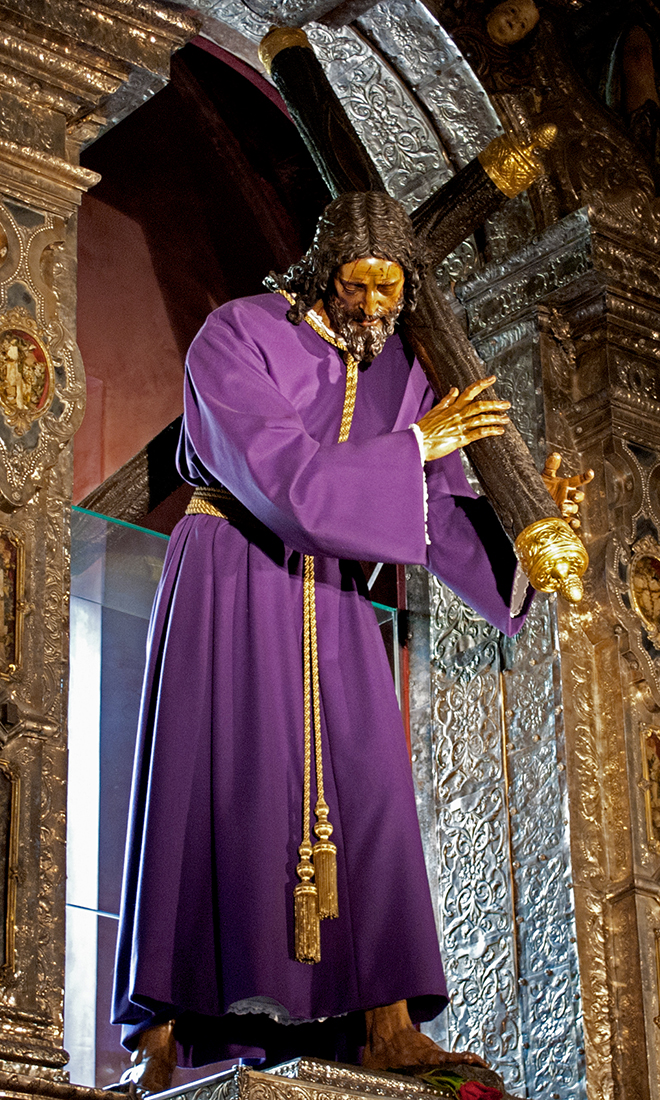
Juan Martínez Montañés was a Spanish Baroque sculptor who was sometimes called the “God of Wood,” or “Dios de la Madera,” for his skill working this material. He was known for the subtle naturalism of his sculptures. Sculpting in wood allowed him to create graceful bodies that, unlike the work of some of his Baroque contemporaries, were never flashy or overly distorted. He made many sculptures in Seville, including Jesus of the Passion (Jesús de las Pasión) from 1618. His renown was international, and some of his works were even shipped to the Spanish Americas.
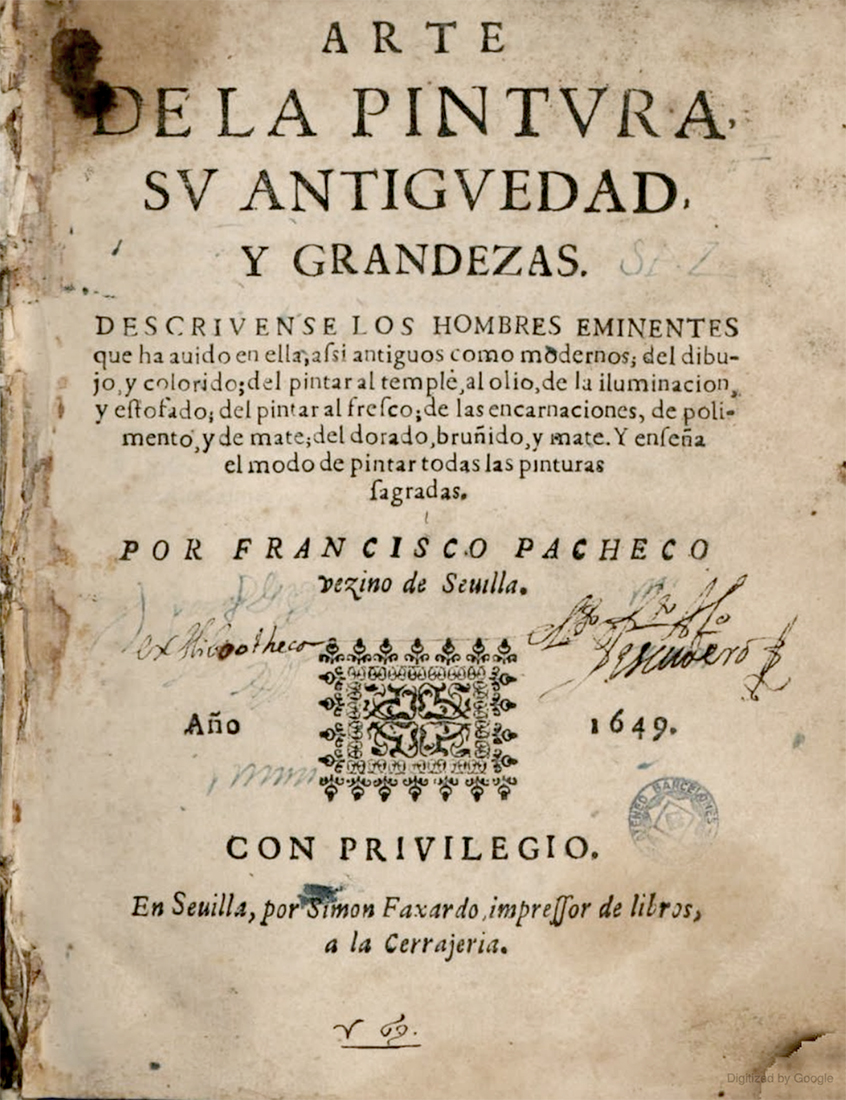
Francisco Pacheco was a painter, but is perhaps more famous today for his artistic treatise, The Art of Painting (Arte de la pintura, written in 1638 and published in 1649). The treatise discusses many topics, among them how to paint a wooden sculpture in order to achieve the greatest sense of naturalism. He desired artworks that followed Christian orthodoxy, and in 1618, he became an Inquisition censor for artworks (someone who evaluated artworks for their adherence to Catholic beliefs).
Iconography
The Christ of Clemency depicts the Crucifixion. Christ’s lifelike body displays the artist’s interest in anatomy, with the ribcage pressed up against his stretched skin, arms sagging under his weight, and carefully rendered leg muscles, all of which serve to highlight his humanity. Tiny rivulets of blood run down around Christ’s shoulders from the crown of thorns on his head, and, as stipulated in the archdeacon’s instructions, his head is turned down and to the right, with open eyes. His mouth is also open, as if he might be speaking to the viewer.
The four nails that pin Christ to the cross, one for each hand and foot, were also stipulated in the contract for the sculpture. This particular point addressed a long-standing debate within the church over how many nails—three or four—pierced Christ’s flesh.
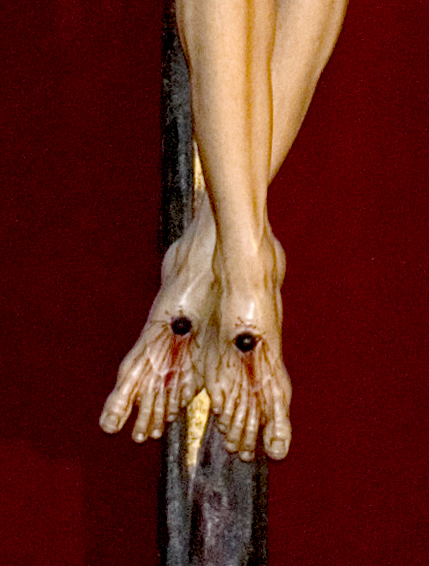
At the twenty-fifth session of the Council of Trent in 1563, the ecclesiastics in attendance stressed the need for imagery that was free of confusion and would not lead anyone astray. Artists were expected to model their figures on canonical sources, like the Bible. Pacheco composed his treatise in part to provide painters with instructions on the “correct” way to produce their works in accordance with the decrees of the Council of Trent.
Based on their reading of Christian sources, artists like Pacheco decided that including four nails was the proper way to represent the Crucifixion. Even though Pacheco’s treatise dates to after the Christ of Clemency, its discussion of four nails relates to the general cultural climate of Seville at this time. Sculptors such as Martínez Montañés followed the decrees and included four nails. Painters like Pacheco, Diego Velázquez, and Francisco de Zurbarán also depicted the Crucifixion in this way, and they may have looked to sculpture made by Martínez Montañés as a model.
Living Sculpture
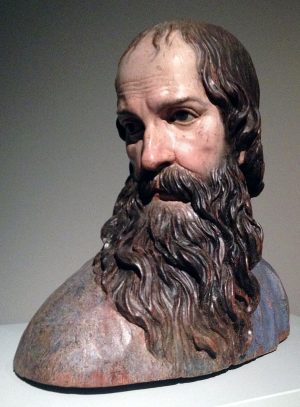
There was a long tradition of polychromed wooden sculptures in Spain. In the seventeenth century, artists such as Alonso Cano and Juan de Mesa became famous for their polychrome sculpure. However, while we may think of a sculpture as the work of an individual, Spanish polychrome sculptures was almost always the result of collaboration among artists who specialized in wood carving and painting. In fact, there were strict rules prohibiting sculptors from painting their own work. After the sculptor modeled and gessoed the figure, a pintor de imaginería (a painter of religious images), would produce the flesh tones and clothing. This was known as the process of “incarnation” (in Spanish, “encarnación”): painting flesh onto the sculpture in order to “bring it alive.”
One motivation for commissioning and creating naturalistic polychromed wooden sculptures was to provoke an emotional or spiritual response in the viewer. Even though polychromed wooden sculpture existed prior to the seventeenth century (and outside Spain), those produced during the Baroque era achieved a new level of naturalism that was considered desirable in the wake of the Council of Trent.
Individuals like Teresa of Ávila and Ignatius of Loyola ushered in a new way of engaging with the divine, one that asked devotees to use their senses to insert themselves into sacred narratives and spaces. Artists like Martínez Montañés and Pacheco responded to the need for artworks that would move viewers emotionally and inspire them to atone for their sins.
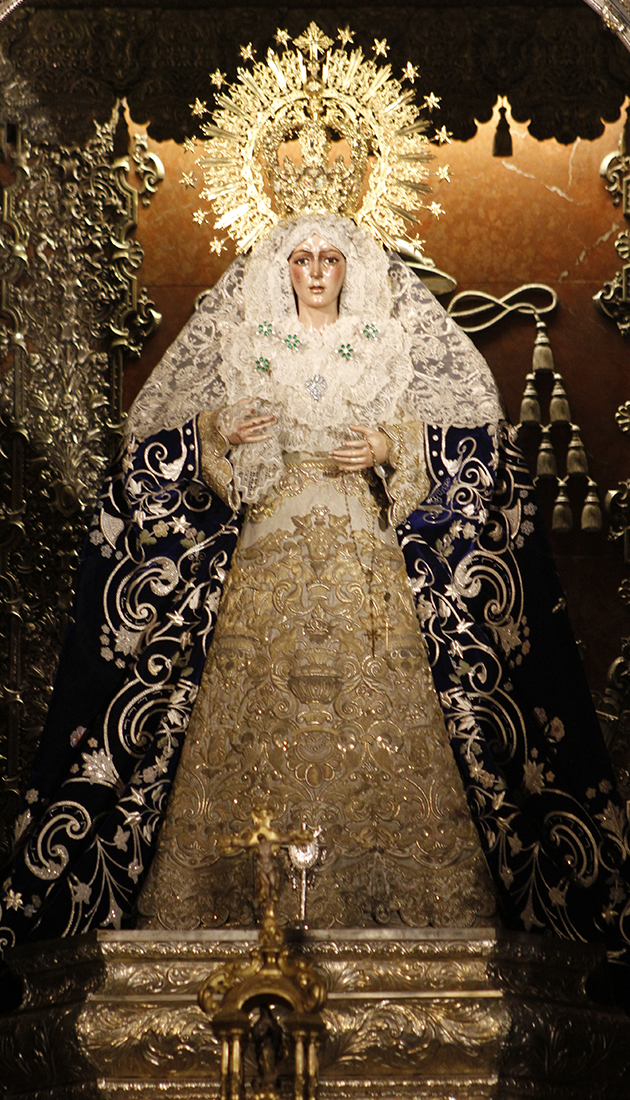
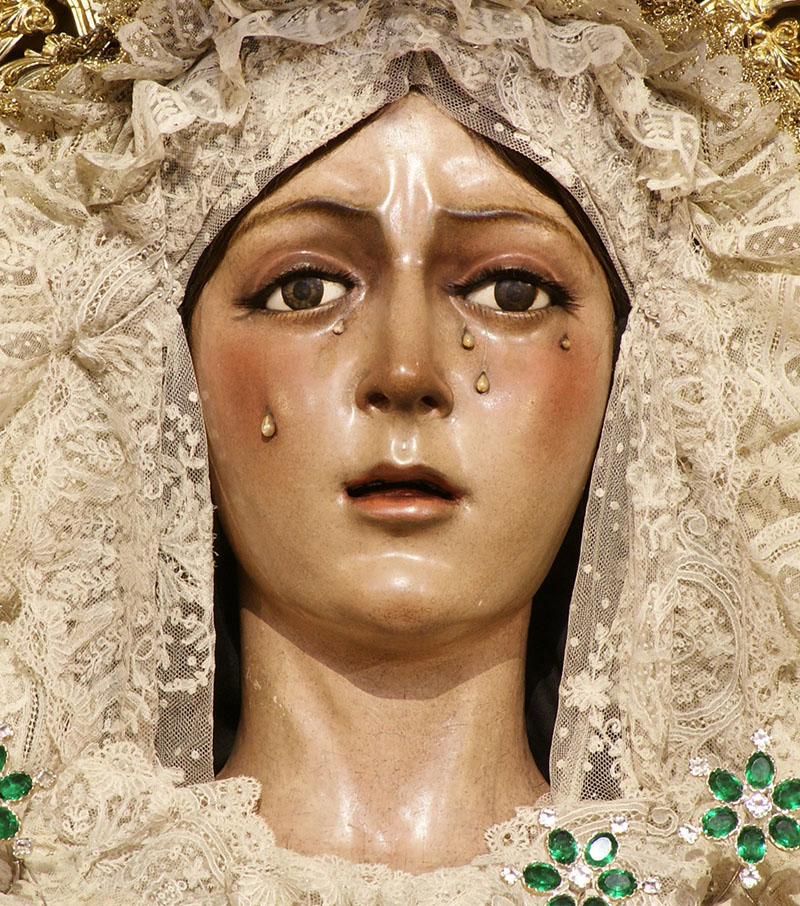
Polychromed sculptures encouraged those who saw them to identify, for example, with the sorrows of the Virgin Mary, whose tears streamed down her grief-stricken face, or with Jesus, whose sorrows and torture were marked onto his body in the form of wounds. To achieve greater realism, sculptors would sometimes add cork, which was then painted, to replicate mutilated flesh and coagulated blood. Other additions, like clothes, wigs, teeth (wooden, ivory, or even real human teeth), leather, and resin added to the impression of living sculpture. Some sculptures even had articulated limbs that allowed them to be placed into different poses, endowing them with even more lifelike qualities. When they were (or are still today) carried through the streets during religious processions, their limbs could move gently, giving the impression of life.
Holy Week Processions
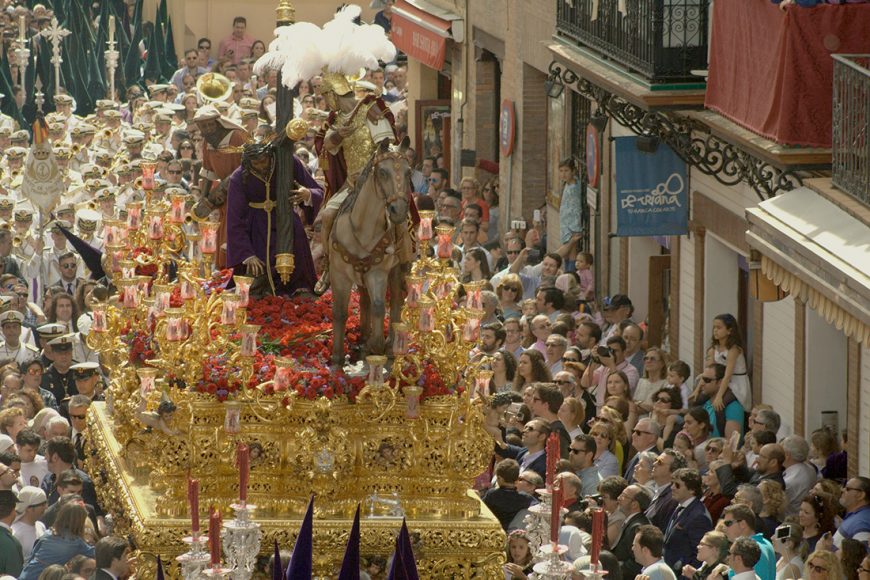
Sculptures like the Christ of Clemency were often used during Holy Week, a time during which Catholics meditate on the sufferings and martyrdom of Christ.[1] During Holy Week processions, confraternity members would carry floats on which the sculptures would rest, arranged to portray specific moments in the Passion narrative. The floats were also commonly adorned with canopies, textiles, candles, and metal objects, making them quite heavy. Confraternity members would pause frequently to rest and to allow people to gaze at the sculptures. Some confraternity members also engaged in flagellation as they processed, whipping their backs in imitation of Christ, represented before their eyes in wood.
Many of these polychromed wooden sculptures are still used today during Holy Week, and Seville is famous for its elaborate processions. A song from 1927, written by José Muñoz San Roman, captures the experience beautifully:
“the Montañés Christ,
the Virgin of Hope
. . . pass by
on flower-strewn calvaries
beneath fine embroidered canopies
of velvet and precious stones.”
[1] It should be noted, however, that the Christ of Clemency was not used in processions.
Additional resources:
Making a Spanish Polychrome Sculpture, from the Getty Museum
The Making of a 17th-century Polychrome Sculpture, from the National Gallery of Art
Smarthistory video of The Ecstasy of St. Teresa by Bernini
The Sacred Made Real: Spanish Painting and Sculpture, 1600–1700 from the National Gallery of Art
The Sacred Made Real: Spanish Painting and Sculpture, 1600–1700, ed. Xavier Bray (London: National Gallery, 2009).
Susan Verdi Webster, Art and Ritual in Golden-Age Spain: Sevillian Confraternities and the Processional Sculpture of Holy Week (Princeton: Princeton University Press, 1998).
Jerónimo de Balbás, Altar of the Kings (Altar de los Reyes)
by DR. LAUREN KILROY-EWBANK and DR. STEVEN ZUCKER
Video \(\PageIndex{26}\): Jerónimo de Balbás, Altar of the Kings (Altar de los Reyes), 1718-37, Metropolitan Cathedral of the Assumption of the Most Blessed Virgin Mary (Mexico City)
Smarthistory images for teaching and learning:

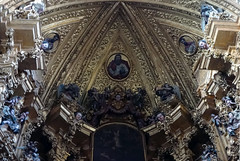


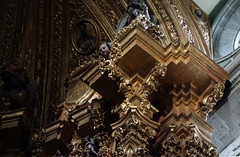


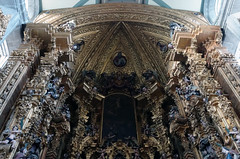
Baroque art in France and England
France and England looked to southern Europe for inspiration, but made the Baroque their own.
1600 - 1700
France
Nicolas Poussin, Et in Arcadia Ego
by DR. STEVEN ZUCKER and DR. BETH HARRIS
Video \(\PageIndex{27}\): Nicolas Poussin, Et in Arcadia Ego, 1637-38, oil on canvas, 87 x 120 cm (Musée du Louvre, Paris)
Nicolas Poussin, Landscape with Saint John on Patmos
by DR. STEVEN ZUCKER and DR. BETH HARRIS
Video \(\PageIndex{28}\): Nicolas Poussin, Landscape with Saint John on Patmos, 1640, oil on canvas, 100.3 x 136.4 cm (39-1/2 x 53-5/8 inches) (Art Institute of Chicago)
Smarthistory images for teaching and learning:
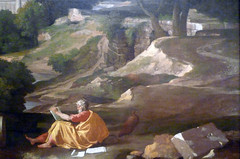
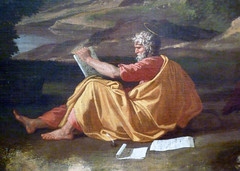
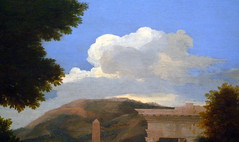


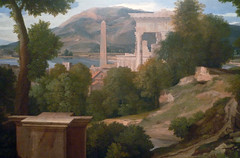

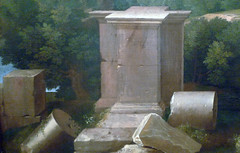
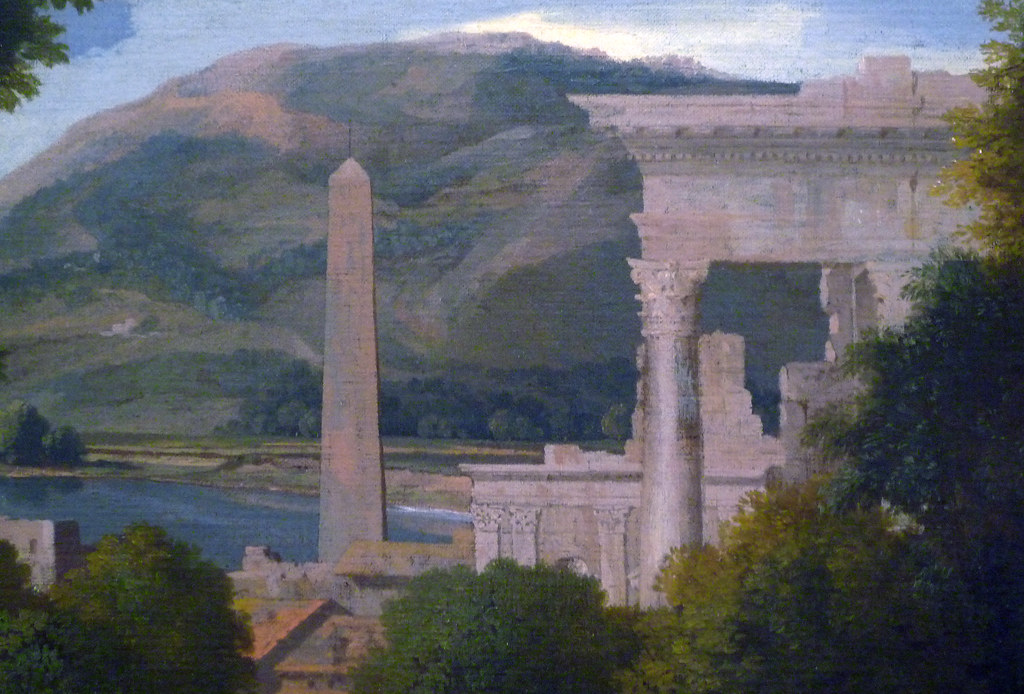
Antoine or Louis Le Nain, Peasant Family in an Interior
by DR. BETH HARRIS and DR. STEVEN ZUCKER
Video \(\PageIndex{28}\): Antoine or Louis Le Nain, Peasant Family in an Interior, 2nd quarter of the 17th century, oil on canvas, 1.13 x 1.59 m (Musée du Louvre, Paris)
Smarthistory images for teaching and learning:


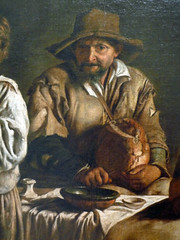

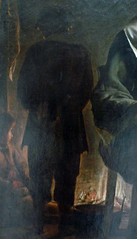
Hyacinthe Rigaud, Louis XIV
by TESSA FLEMING
Art and state

The early seventeenth century was marked by unrest and near constant warfare; however, by the mid seventeenth century, France had emerged as Europe’s largest and most powerful country. France, under Louis XIV, was an absolute monarchy where full power resided with the king. As an absolute monarch, Louis was not subject to any constitutional limitations, leading him to declare “l’etat, c’est moi” (“I am the state”). Louis ruled by divine right, receiving his authority directly from God. The concept of divine right allowed Louis to quash emerging rebellions while establishing legitimacy. Louis became known as le Roi Soleil, the Sun King, furthering his claim of divine lineage by recalling the ancient Greek god Apollo and declaring himself, in his usual modest manner, to be the center of the universe.
Recognizing the importance of propaganda, Louis and his advisors embarked on many large-scale projects, most memorably the expansion of Versailles from a rather unassuming (by royal standards, at least) hunting lodge to an enormous, gilded (and mirrored) palace. Versailles reinforced the image of the Sun King and infused the Baroque style with classical elements, visually linking Louis’ rule to the might of Imperial Rome. As the leading patron of the era, Louis XIV employed a workshop of artists and architects; Hyacinthe Rigaud became the principal painter to the king.

“L’etat, c’est moi”

Rigaud’s monumental portrait displays a life-size, full-body depiction of Louis XIV. The composition recalls Anthony Van Dyck’s 1635 Charles I Dismounted. Louis, as the focal point, stands in the center of the canvas, his body angled slightly while his face is turned to meet the viewer with the confidence and directness expected from a king.
Billowing embroidered silk curtains form an honorific canopy over the King’s head while the lavish carpeting creates an opulent environment worthy of the king’s presence. To the left, a marble column sits atop a gilded base, symbolizing the strength of the monarch while again recalling the classical era.
Louis’ pose, like Charles’ before him, allows him to literally look down on the viewer, despite both monarchs being quite short. As royal portrait painters, both Rigaud and Van Dyck were able to assert the dominance of the monarch by carefully creating the illusion of height; to please their patron, royal painters often opted for idealized elements at the expense of realism. Despite the similarities in their portraits, Louis met a happier (or at least far less grisly) end than Charles I who was beheaded in 1649.
Accessories make the man

Like Versailles, nothing in Louis XIV is understated; every detail was intended to remind the viewer of the supremacy of the monarch and his divine authority. Louis, dressed to the nines, is bedecked in his coronation robe. Even the materials of the robe reinforce the image of the monarch; the black-and-white ermine fur and the blue-and-gold fleur-de-lis, a stylized lily, are symbolic of the French monarchy.
Rigaud paints Louis with a royal sword fastened to his hip, the precious materials contributing to the extravagant atmosphere while also symbolizing his military might. In his right hand, Louis holds the royal scepter while the crown rests on the table below, just in case there were any lingering doubts that this Louis was a pretty important fellow.

Louis’ hair is also worth noting (and not just because it’s amazing). To modern eyes, the king’s hair seems more appropriate for a member of KISS than for a sixty-three year old absolute monarch; however, Louis’ hair cascades down his royal robes—representing a still youthful and robust king. In official royal portraits, there was constant negotiation between historical accuracy and the ideal form. How exactly to render Louis’ hair sparked an intense debate on more than one occasion: should the hairstyle be accurate, the king presented as he actually looks, or should concessions be made so that the regal qualities of the king might be more readily apparent? Like with Louis’ (lack of) height, royal painters had to strike a balance between an identifiable and recognizable portrait and one that idealized the sitter to meet the patron’s desired result.

Similarly, Louis’ legs, which Rigaud has cleverly and prominently displayed, are rather well defined for an aging king. Louis’ advancing age (he would die fourteen years after this portrait) is betrayed by his lined face, slight jowls, and double chin; the king was reportedly in ill health and had to have several teeth extracted due to infection. It is no coincidence that Louis is posed with his majestic robe draped over his shoulder to reveal his lower limbs: Louis had been a ballet dancer in his youth and prided himself on his dancer’s legs. The legs, while in contrast to his aged face, suggest a vital and vigorous man, still in the prime of his power. Rigaud tempers the monarch’s timeworn face by reminding the viewer of Louis’ athletic past; the heeled shoes are not only flattering but add several precious inches onto Louis’ height. Here, Louis is identifiable—clearly the portrait is of the king in the later years of his life—yet also idealized, his well-toned legs and lustrous hair preternaturally preserved.
Success
Rigaud’s portrait, originally commissioned as a gift for Louis’ grandson, Philip V of Spain, was so well received that Louis ultimately chose to keep it and sent a copy in its place. Rigaud so successfully captured power of Louis XIV that the image was placed over the throne and in the king’s absence, the painting served as his proxy and courtiers were forbidden to turn their backs on the painting.
Louis le Vau, André le Nôtre, and Charles le Brun, Château de Versailles

When the King of France, Louis XIV, first decided to build a new palace and move his court out of Paris, there was nothing on his chosen site at Versailles but a smallish hunting lodge. Today, the palace stands as a prime example of the over-the-top excesses of the French nobility that led to the French Revolution.

Huge, but oh so stylish
Thanks to the team of Louis le Vau (architect to the aristocracy), André le Nôtre (landscape designer extraordinaire), and Charles le Brun (über-fashionable interior decorator and painter), Louis XIV’s enormous and stylish palace was completed 21 years after it was begun in 1661 allowing Louis (and his closest friends, family, courtiers, servants and soldiers—all 20,000 of them) to officially set up court there (by that point, the next superstar architect, Jules Hardouin Mansart, had taken up the design reins). Enormous is no joke. The place has 700 rooms, 2,153 windows, and takes up 67,000 square meters of floor space (for those of you keeping track at home, that’s over 12 American football fields or a bit more than 9 soccer pitches).
Over and above anything else, Versailles was meant to emphasize Louis’s importance. After all, this is the guy that called himself The Sun King; as in, everything revolves around me. “L’état, c’est moi” (I am the state), he said, famously and oh-so-modestly. By building Versailles, Louis shifted the seat of French government away from the feuding, gossiping, trouble-making noble families in Paris. He had the whole palace and its massive gardens built along an East/West axis so the sun would rise and set in alignment with his home. And he filled both the palace and its gardens with sculpture, painting, and fountains that all focused on…you guessed it…himself.
Buttons and bedchambers
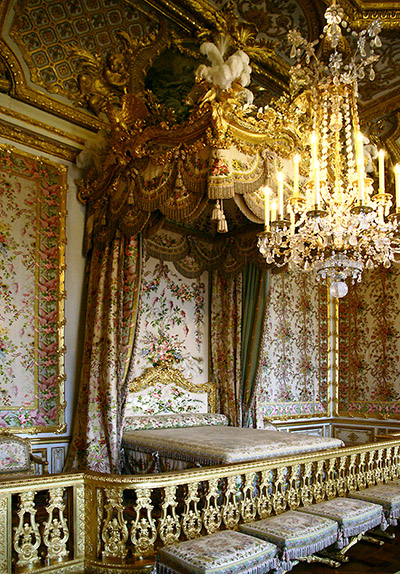
When you walk through the palace at Versailles, you’re bombarded with room after room of marble and gold and paintings: ceilings painted to place Louis in the company of the Greek gods, busts of him in a huge formal curly wig staring at you wherever you go, and gold gold gold, so you never lose sight of how wealthy the King of France was. To give you just a hint, we’re talking about a man who spent the equivalent of $5,000,000 on buttons over the 54 years of his reign. That’s an average of almost $100,000 a year. On buttons.
Of the 700 rooms inside the palace, there are a few notable ones that served very particular functions. The king’s official state bedroom is one, where the incredibly detailed lever (rising) and coucher (going to sleep) rituals would be performed each day. Both involved a whole host of courtiers waiting on the king while he got up or went to bed, following strict rules of position and rank to determine who got to perform which parts of the ceremony.
The queens of France who lived at Versailles were the focus of a similar ritual (the Toilette) in the queen’s main bedchamber, a room where they also gave birth in public. The symmetrical Salon of War and Salon of Peace are decorated with paintings highlighting, unsurprisingly, France’s military might and the benefits of living calmly under a tranquil ruling government. And the Cabinet des Chiens (literally, the Study for Dogs) was a room that Louis XV’s valets shared with his dogs, who also got to sleep in a room full of gilding and painted decoration.

Hall of Mirrors
The most famous room is the Hall of Mirrors, which runs along the entire length of the central building. One wall contains a row of giant windows looking out over the gardens (almost 2,000 acres of manicured lawns, fountains and paths arranged in the formal garden style that André le Nôtre was known for), and the other wall is covered with 357 mirrors that catch the rising sun’s rays inside the palace and remind us yet again (as if we could forget) of Louis XIV’s power.
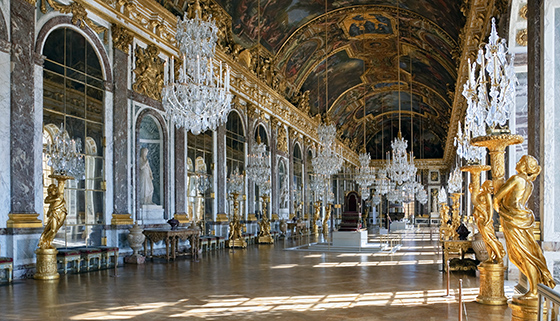
Though the room is over the top in its grandeur, it was mainly used as a passageway. After the king got up for the day, he proceeded through this mirrored hall to his private chapel, and as many courtiers as could fit would squeeze in, waiting for their chance to beg a favor of the king as he passed by them. Since Louis XIV’s day, the room has also been used for parties (the masked ball for the wedding of Louis XVI and Marie Antoinette) and military agreements (the Treaty of Versailles that officially ended World War I was signed here in 1919).
Classical restraint
The palace’s outside isn’t as ornate as its inside. Sure it’s still huge, and sure it’s still got plenty of gold and statues and embellishments, but the basic structure is classical; it’s symmetrical, repetitive, and based on simple elements that are directly borrowed from ancient Greek temples. The façade that faces the gardens looks remarkably similar to the White House in Washington, DC, albeit much bigger and not so white.

Before you go thinking that this is a sign of Louis XIV’s hidden modesty, keep in mind that classical architecture was intended to remind people of the greatness of the antique Greek and Roman past (Greek and Roman civilization were often lumped together and called classical). When Versailles was being built, this ancient past was seen as the root of the intellectual and aesthetic superiority they believed had descended to the French nation. Classical architecture was the name of the game at Versailles, and although it wasn’t as complicated as some of Louis XIV’s other choices, he was making a direct link from himself all the way back to the great thinkers and builders of the ancient, classical, past.
Sun King or Sun God
Louis, ever modest, especially liked linking himself directly to the Greek god Apollo (Sun King = Sun God… subtle wasn’t Louis’s middle name). The Apollo Fountain and Apollo Salon remain two of the major highlights of a visit to Versailles. Not content with the restraint of pure classical design, he had his team create a palace that used classical structures to contain the elaborate grandeur of the Baroque style that was all the rage in the mid-seventeenth century. He wanted to make the biggest possible statement and what he ended up with was Versailles: a palace designed to glorify the French monarch by incorporating both ornate Baroque decoration that amply demonstrates his wealth and glory and the stricter rules of classicism that express his intellectual and cultural stature.
Additional resources:
Claude Perrault, East façade of the Louvre
by DR. PAUL A. RANOGAJEC

It is not immediately obvious why the eastern façade of the Louvre Museum, originally a royal palace, was considered among the most important architectural works in France at the end of the seventeenth century. There is an incongruity today between the grandeur of the building and the ordinariness—and smallness—of the space in front of it, the Place du Louvre. Originally designed to be the main, ceremonial entrance to the palace, the façade repays close attention, despite its unexalted position today. It is a premier example of the rigorous design tradition in French classicism, a revered model for subsequent palace design, and a monument associated with the origins of modernity in architecture.
The Louvre through the centuries
The Louvre as we know it today resulted from a series of expansions over 800 years. It should be remembered that, while the Louvre is now in the very center of Paris, until the eighteenth century it was at the city’s western edge.
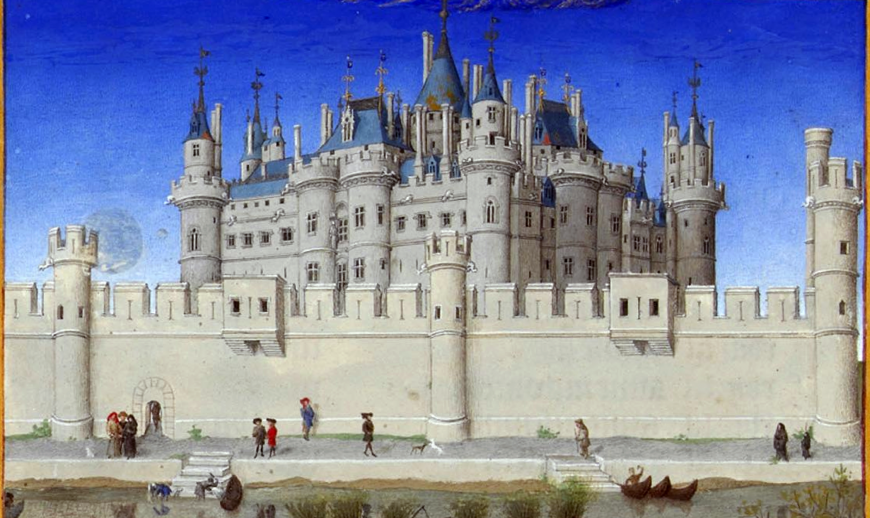
Starting around 1190, King Philippe II constructed a fortified arsenal on the right bank of the Seine River. In the fourteenth century, Charles V transformed it into a royal residence. The October illustration from the famous Très Riches Heures du Duc de Berry, a beautifully decorated Book of Hours (a collection of daily prayers for the laity) by the Limbourg Brothers (above), suggests what the fortress-palace looked like just after Charles’ interventions.
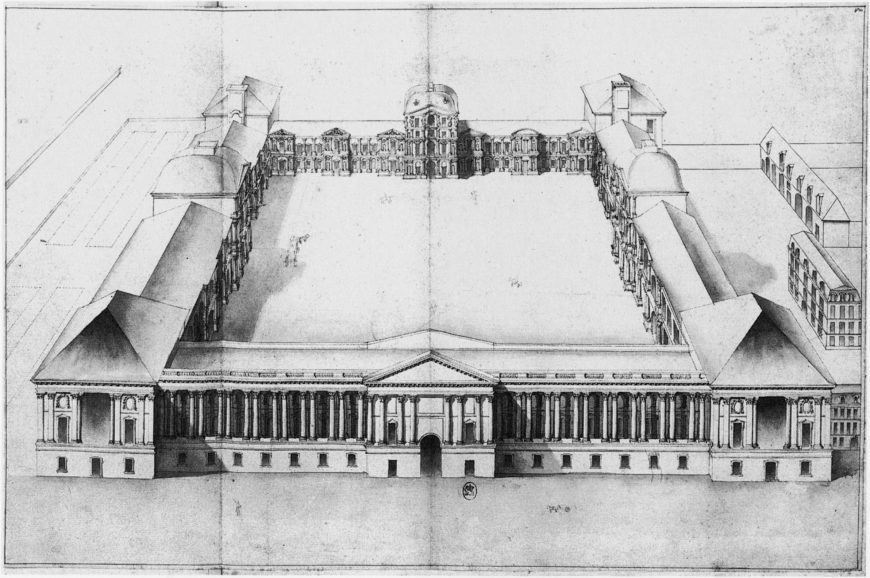
In the early sixteenth century, Francis I’s architects planned to expand the palace into a more spacious Renaissance building. His successors, especially Kings Henri IV, Louis XIII, and Louis XIV, continued making ever grander plans—turning the palace into a sprawling structure along the river. Louis XIII initiated construction of the eastern block known as the Cour Carrée (square courtyard) in the seventeenth century—a symbolic gesture of reaching out toward the city’s center from its periphery (above). Its façades were meant to suggest the connection of the king to his capital city. By the middle of the seventeenth century, nothing above ground was left of the medieval fortress or the fifteenth-century palace. Finally, during the 1660s, the east wing was reimagined as a grandiose royal entrance to the whole structure.
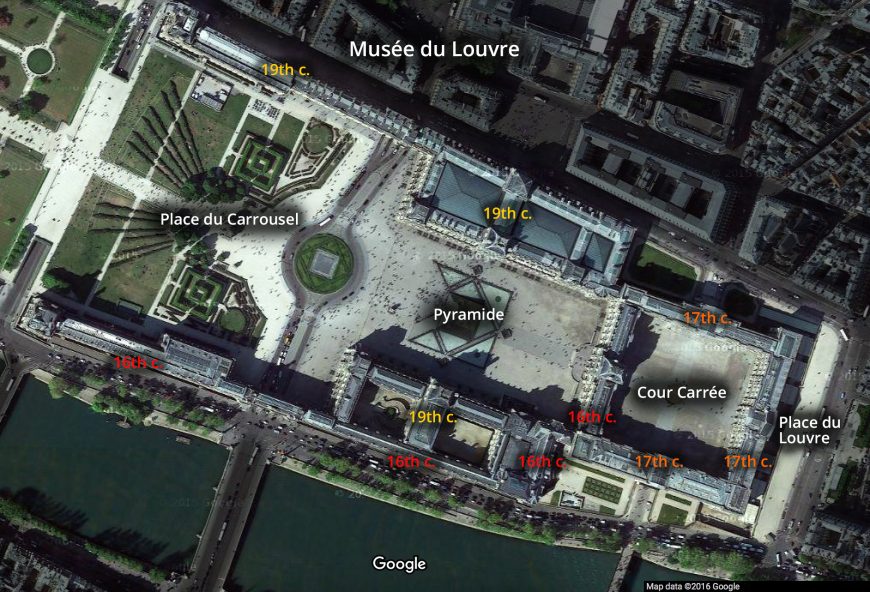
However, by 1680 Louis XIV had directed his full attention—and brought his whole court—to the new palace at Versailles. Work at the Louvre stopped, and the abandoned Cour Carrée languished unroofed for about a century. Ironically, then, what had been intended by its patron and architects as one of Paris’ most prominent symbols of royal dominion over the city became instead a sign of the king’s absence.
Colbert, Le Vau, and Bernini
In 1664, the completion of the Cour Carrée with new eastern and southern wings became the responsibility of Louis XIV’s finance minister, superintendent of buildings, and leader of royal cultural patronage, Jean-Baptiste Colbert. The king’s Premier architecte (Chief Architect), Louis Le Vau, had already completed the south wing in 1663. As part of his plan to finish the Cour Carrée, he also began construction of the east wing with a design comprising a colossal order (taller than one story) of columns along its length and a central pavilion (a section that projects forward). This had similarities to Le Vau’s Collège des Quatre Nations (below), being built at the same time directly across the river from the south wing of the Cour Carrée.
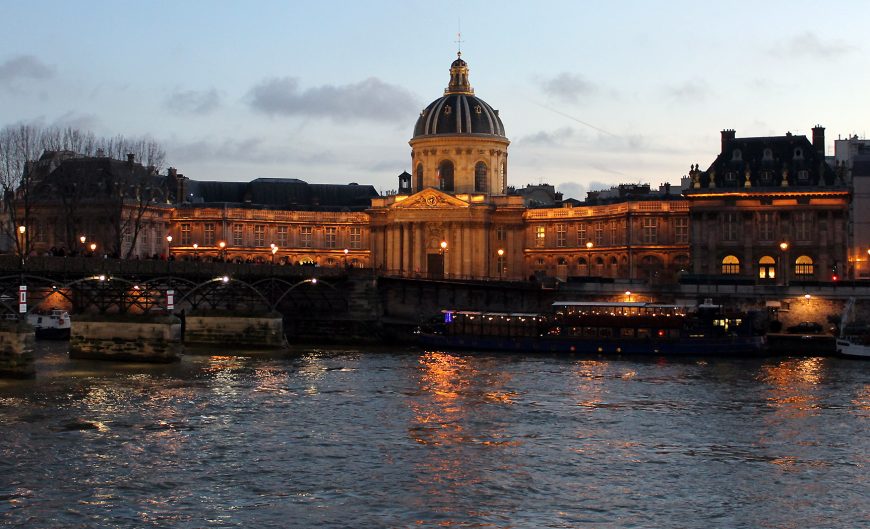
For seemingly political reasons, all work on Le Vau’s Louvre designs was halted by Colbert when he assumed his post as building superintendent on January 1, 1664. Le Vau had recently designed a spectacular chateau, Vaux-le-Vicomte, for Nicolas Fouquet (finance minister before Colbert). In 1661, Louis XIV had Fouquet imprisoned for life on exaggerated charges of mishandling the treasury. Colbert stopped Le Vau’s Louvre work, perhaps wishing to bolster the king’s claim to absolute power, and to assert his own exclusive prerogative to decide on artistic matters. Then Colbert solicited designs from other French architects, and in March he invited a proposal from Gianlorenzo Bernini, easily the most famous artist in Europe at the time. Bernini was Italian and worked primarily for papal patrons in Rome.
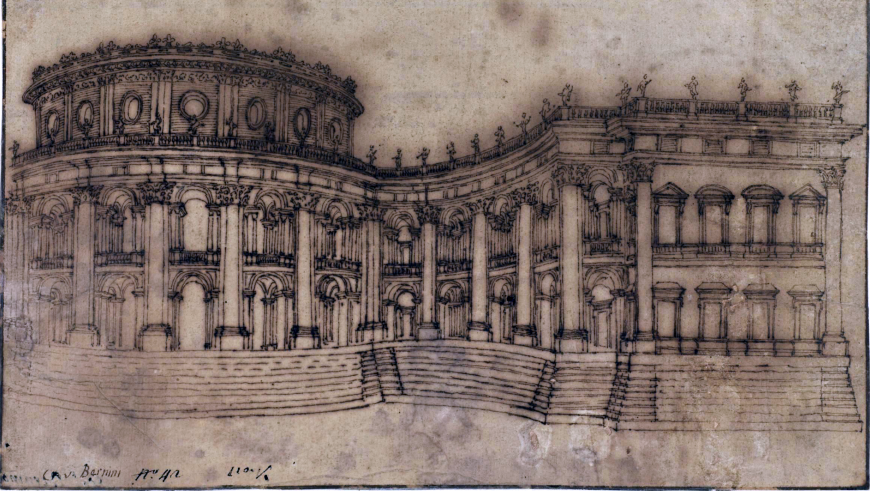
Bernini’s first designs for the east façade of the Louvre (above) were remarkably vibrant, articulated by colossal engaged columns (“engaged” here means attached to a wall). His walls were enlivened by contrasts of light and shadow, solid and void, curved and straight lines. Colbert disapproved of these designs as being too far from French traditions, but, intent on having so esteemed an artist build for the king (and disregarding the affront French architects would feel at being snubbed for a foreigner), he invited Bernini to Paris to try yet again. Bernini stayed in Paris from June to October 1665. The project he produced (below) was a massive block, raised up on a heavily rusticated base and again articulated by a colossal order of engaged columns and pilasters (pilasters are flat engaged columns). Although its end and central pavilions were a nod to the traditional form of French palaces, it seemed more at home in Rome than Paris. Construction began just before Bernini left Paris, but Colbert soon halted this work, too.

The petite conseil and the final design
To move forward with work on the east wing, Colbert appointed a petite conseil (small council) in early 1667, consisting originally of three members: Louis Le Vau (still the Premier architecte despite his Fouquet connection), the Premier peintre (Chief Painter to the King) Charles Le Brun, and the physician-turned-scientist-and-architect Claude Perrault. Claude was the brother of Charles Perrault, a writer best known for his fairy tales, a prominent member of the Académie française (French Academy), and a close associate of Colbert’s. Charles probably influenced Colbert to give his brother Claude a place on the petite conseil. In his favor, Charles could point to his brother’s recent pursuits in architecture, which included a 1666 commission from Colbert himself to translate into French the treatise of the ancient Roman architect Vitruvius.
By May 1667, the council had produced a new design. The three members were joined by a fourth, the architect Roland Fréart de Chambray in 1668; he seems to have contributed to the final design of the pavilions. Because of the committee structure, debate about authorship of the east wing has continued from the beginning to the present. Undoubtedly all four members of the council—each a forceful personality—contributed to the design. However, the relative importance of Le Vau’s and Perrault’s contributions has remained contentious.
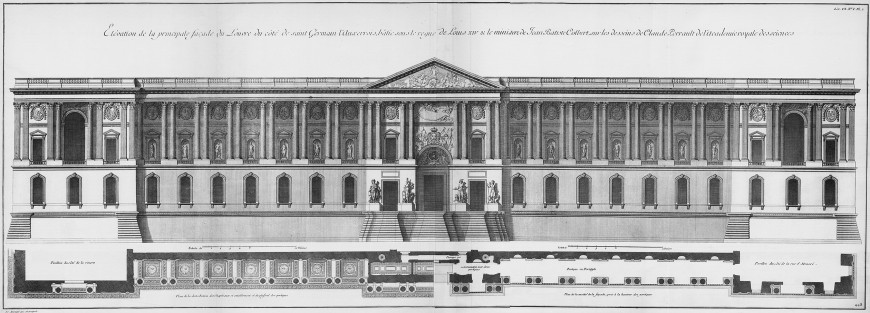
The council’s design is a study in unity. The long façade follows the five-part pattern of French palaces: two pavilions, one on each end, with recessed wings and a central entrance topped with a pediment. However, the pavilions only slightly project forward from the wings, and they do not rise higher than them, as was traditional. Only the low triangular form of the central pavilion’s pediment breaks the strict horizontality of the roofline, emphasized and softened with a balustrade (a continuous railing), which was a favorite motif of Le Vau’s. The end pavilions, elegantly detailed with low-relief sculpture, recall Roman triumphal arches. Designed as a solid base, the lower story uses windows similar to earlier ones at the Louvre, creating visual continuity with the older sections and providing a visually strong support for the colonnades above.
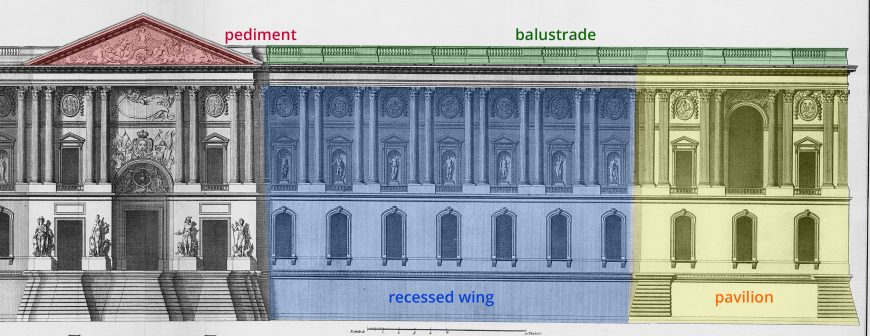
The classical orders
Along with the horizontality of the façade, the doubled columns of the twin porticos (covered walkways or porches, here along the colonnades, or recessed wings), mark a departure from earlier royal buildings in France. The Corinthian columns impart a continuous, steady rhythm to the whole façade. Set in front of the deep porticos, the light and shadow of the columns create visual enrichment. And there is variety in the use of the columns: at the center pavilion and in the colonnades they are free-standing, but at the end pavilions they turn into engaged columns around the central windows and into pilasters at the outer edges. Their slightly slimmer proportion compared to most Corinthian columns compensates for the wider proportion one perceives in the coupled motif.
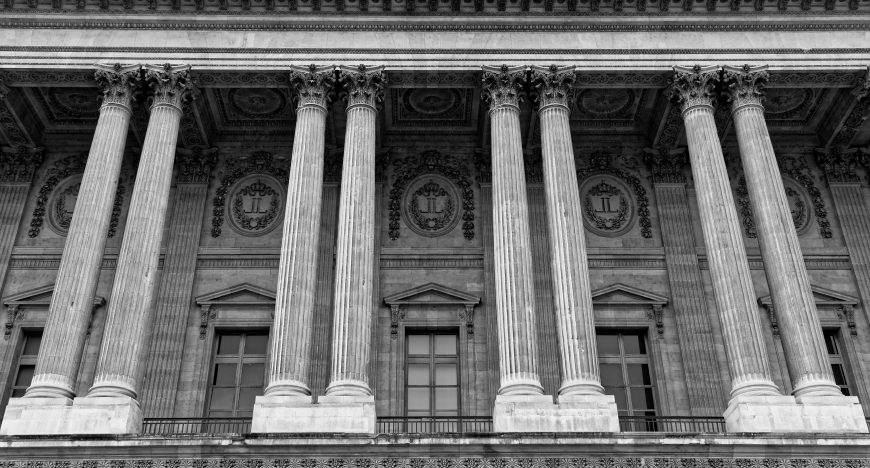

At the time, the paired columns were the most startling aspect of the design. The issue of the spacing of columns (called intercolumniation), was one on which Vitruvius and Renaissance architectural writers had spent much time. A small diagram published in Claude Perrault’s translation of Vitruvius, Les dix livres d’architecture de Vitruve, explains how the colonnades were designed. Perrault shows a series of four columns spaced evenly in a row. This is the typical intercolumniation of an ancient temple, for instance. To achieve the Louvre’s colonnade design, Perrault shows how every other column is displaced toward its neighbor to the left.

By displacing half of the columns to create the double-column pattern, greater emphasis is put on the spaces between the columns: that is, the large space between each pair of columns (B) and the narrow space between the columns of each pair (A). This creates the dynamic visual rhythm, A-B-A, instead of the more static A-A-A.
According to Perrault, this arrangement, resulting in wider-than-usual spacing (dégagement), is a legitimate invention of a sixth type of classical intercolumniation. The ancient Roman architectural authority, Vitruvius, had discussed five ideal types of column spacing; Perrault claimed the Louvre was a new type appropriate to modern French taste. He argued that while the ancients preferred closely spaced columns—due in part to the structural limits of building in stone—the French, with their tradition of lighter, more open structure deriving from the Gothic cathedrals of the late Middle Ages, prefer wider spacing. Perrault, however, never discusses the fact that the façade uses a large quantity of iron reinforcement, without which structural forces would tend to push the columns outward.
Perrault’s theory of beauty and the quarrel of the ancients and moderns
Although the conseil’s collective authorship of the façade is now established, Perrault’s later architectural theory has long been read as an explanation of the design and a confirmation of its inherent modernity. Perrault’s fundamental challenge to traditional architectural ideas was the assertion that beauty was not a natural or universal quality; it did not depend on precise, immutable laws of proportion or on mathematical harmony. Beauty, Perrault argued, was contingent, based in imagination and customary usage. To overcome the possibility of completely subjective judgment regarding architectural beauty, reason had to govern the architect’s approach. Architects had to discover beauty for themselves through the process of design.
Perrault’s own attempt to apply a modern approach to beauty is found in his architectural treatise, Ordonnance des cinq espèces de colonnes selon la méthode des Anciens. He posits two types of beauty available to architecture: positive and arbitrary. Positive beauty is,
based on convincing reasons … whose presence in works is bound to please everyone, so easily apprehended are their value and quality. They include the richness of the materials, the size and magnificence of the building, the precision and cleanness of the execution, and symmetry … [which] consists in the relationship the parts have collectively ….” By contrast, arbitrary beauty is “determined by our wish to give a definite proportion, shape, or form to things that might well have a different form without being misshapen and that appear agreeable not by reasons within everyone’s grasp but merely by custom ….
Proportion was a second area where Perrault offered something new to architectural theory. Up to his time, writers on architecture had usually assigned proportion a determining role in the perception of beauty. By contrast, Perrault writes on the first page of the Ordonnance that “the beauty of a building, like that of the human body, lies less in the exactitude of unvarying proportion and the relative size of constituent parts than in the grace of its form.” Nevertheless, Perrault recognized that certain ranges of acceptable proportions could be extracted from both the existing monuments of antiquity and the proportional schemes developed by Vitruvius and famous Renaissance architectural writers. He admits that there exists “detailed rules from which one cannot deviate without robbing an edifice of much of its grace and elegance,” but he quickly asserts that there is still “enough latitude to leave architects free to increase or decrease the dimensions of different elements according to the requirements occasioned by varying circumstances.” He criticizes the proportioning systems of earlier writers, and then offers his own: a mean taken from the extremes found in esteemed buildings from history. Although he leaves room for invention, he is nonetheless careful to justify his proportional system based on examples from the past.
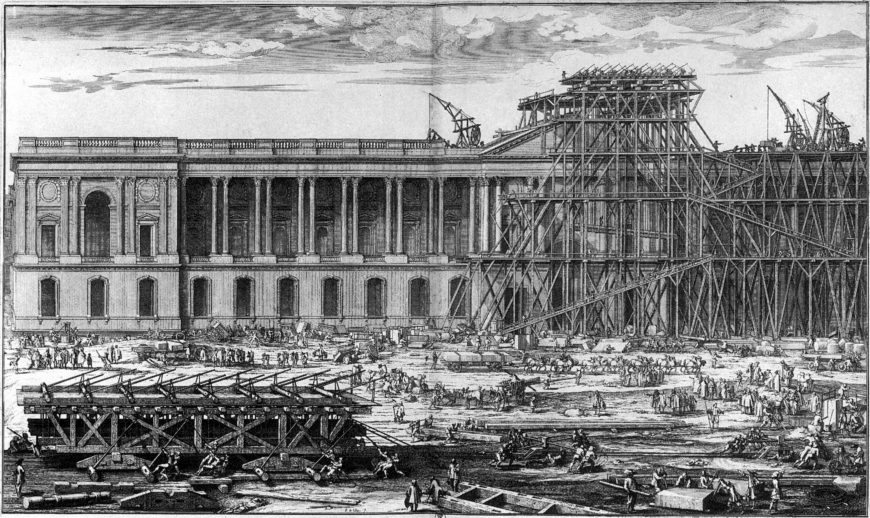
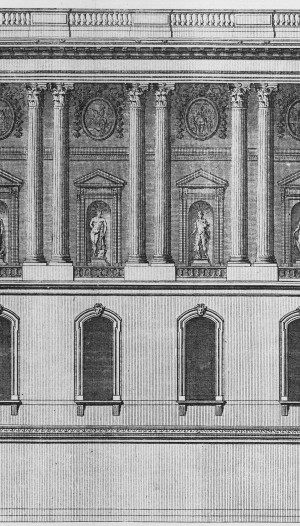
In the Ordonnance Perrault excoriates traditionalists who have an “exaggerated respect for antiquity” and who “genuinely believe that the glory of their beloved antiquity rests on its being considered infallible, inimitable, and incomparable.” This placed him in the modern camp in the elite cultural debate that became known as the Quarrel of the Ancients and Moderns. This debate centered on questions about the relative merits of literary and artistic achievements in the modern age (particularly the time of Louis XIV, but also of his immediate predecessors) and antiquity. The Moderns, led by Claude Perrault’s brother Charles, whose serial book Parallel of the Ancients and Moderns was a touchstone for the debate, believed in the ever greater perfectibility and supremacy of the modern age. The Ancients, on the other hand, found certain things from the antique past to be so exceptional and incomparable that they could not be surpassed by anything in the modern age. Because of his innovative ideas about beauty, proportion, and invention, Claude Perrault has always been identified as a proponent of the Moderns. And the Louvre façade has always been connected to his theory, making the building an early monument of modern architecture.
But Perrault, as we have seen, also relied on the authority of antiquity, and he accepted the classical orders as the primary elements in architectural design. As an innovator rather than a radical, he took great pains to emphasize that he was not contradicting tradition so much as extending, even perfecting it. He wrote,
I also contend that whatever innovations I introduce are intended not so much to correct what is ancient as to return it to its original perfection. I do this not on my own authority, following only my own insight, but always in reference to some example taken from ancient works or from reputable writers. … I am proposing nothing without precedent in example or in the work of illustrious authors. … I would say that my purpose is simply to extend change a little further than before.
A masterpiece hidden in plain sight
The east façade of the Louvre remains one of the most impressive examples of French classical design. Whether we see it pointing to the future or building upon tradition, it is a touchstone in debates about classicism in modern architecture. Studied by architects since the time it was built, it became a precedent, a model exuding authority, for prominent buildings in later times, including Charles Garnier’s renowned Paris Opéra in the 19th century, which adopted the coupled-columns motif. The fact that today the Louvre façade is effectively the rear of the museum may detract from its prominence but cannot erase its importance.
Additional Resources:
Robert W. Berger, The Palace of the Sun: The Louvre of Louis XIV (University Park, PA: Penn State University Press), 1993.
Harry Francis Mallgrave, Modern Architectural Theory: A Historical Survey, 1673-1968 (Cambridge: Cambridge University Press, 2005), 1-9.
Claude Perrault, Ordonnance for the Five Kinds of Columns after the Method of the Ancients, translated by Indra Kagis McEwen, introduction by Alberto Perez-Gomez, Santa Monica (The Getty Center, 1993).
Claude Perrault, Les dix livres d’Architecture de Vitruve, second ed. (Paris, J.-B. Coignard, 1684).
England
Anthony van Dyck, Charles I with M. de St. Antoine
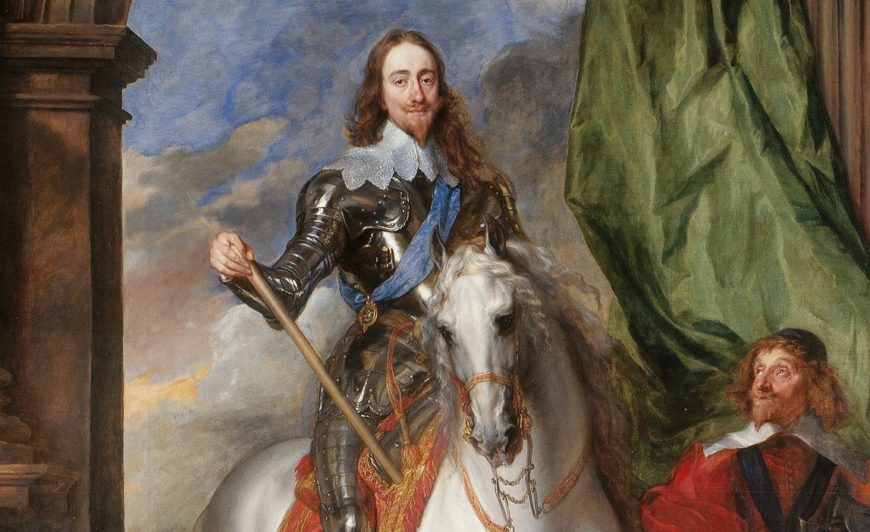
Horsepower
Equestrian portraits (a figure on a horse) are usually reserved for military and political leaders, following an ancient tradition going back at least as far as Alexander the Great and the Roman Emperor Marcus Aurelius. A horse is essentially a pedestal upon which leaders can elevate themselves above the common people, but the equestrian format is also a metaphor for taming and training nature: an indication of the potential of the rider to guide the populace and subdue external enemies.
Charles I, King of England was particularly in need of these kind of symbolic associations as he was not physically prepossessing (his adult height was just 163cm (5 feet 4 inches) and he suffered from a speech impediment), nor was his rule glorious (he was eventually beheaded after a long and costly civil war). Charles I with M. de St. Antoine was the first equestrian portrait ever painted of this king, and Anthony van Dyck purposefully chose this format to enhance Charles’s status at a particularly unstable moment in British history.
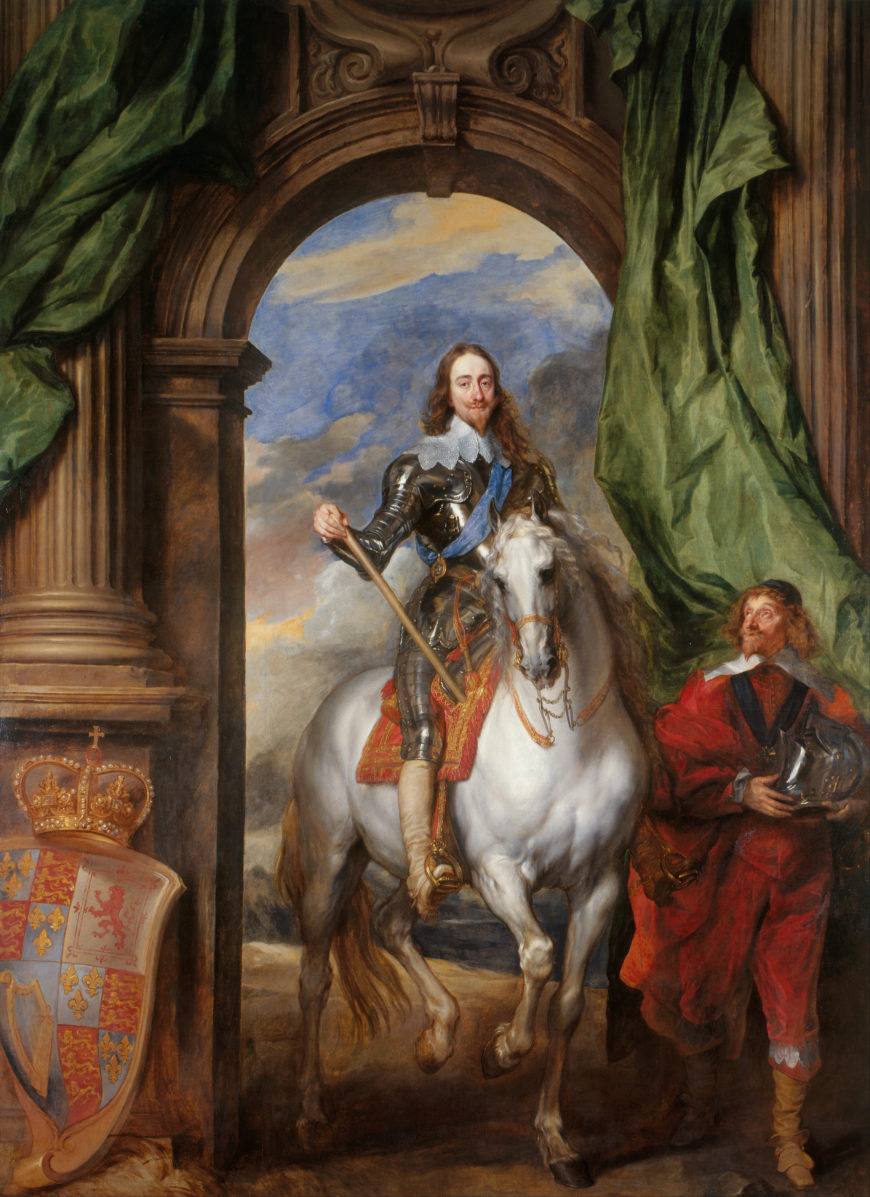
A clear message
Charles I is riding a white horse towards us, through a triumphal arch. Van Dyck has used the architecture to provide compositional structure, splitting the scene into three vertical sections, and positioning a key element in each: a coat of arms, the king, and a figure dressed in red. Together they create a roughly pyramidal form with the king’s head at the apex. However, the simplicity of layout has been animated with the addition of some billowing green drapery, and the movement of the human and animal figures — especially the foreshortened body of the horse as it steps forwards, its front hoof touching the edge of the picture plane.
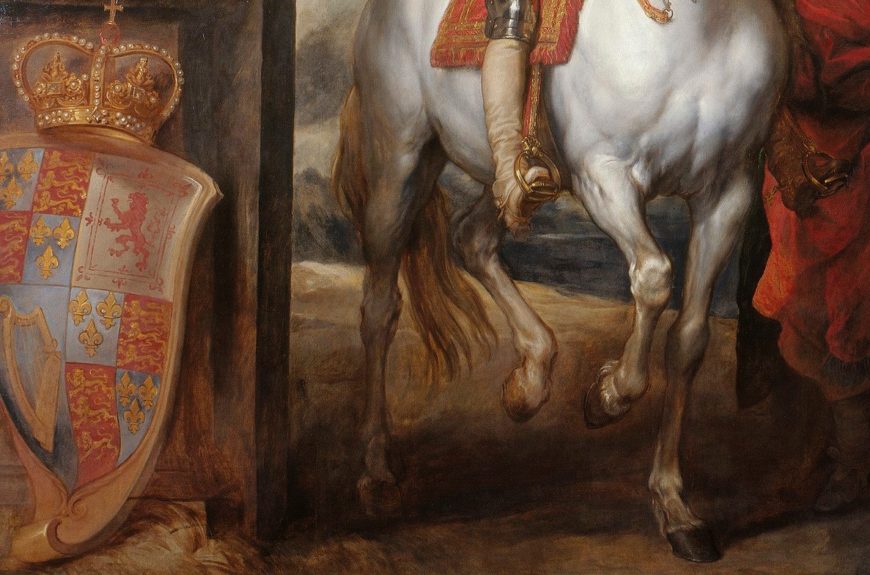
Authority to rule and a supreme military leader
Each of the ancillary elements of the painting contains additional information that contributes to the overall message of Charles’s authority to rule. The royal coat of arms, for example, contains the insignia of England (three lions), Scotland (lion rampant) and Ireland (harp), to show the unification of the nations of the United Kingdom (England, Northern Ireland, Scotland, and Wales) under the rule of Charles’s father James I.
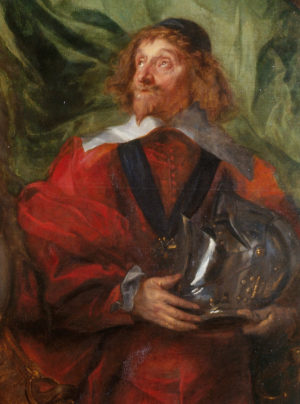
The figure dressed in red is Pierre Antoine Bourdin, Seigneur de St. Antoine, an expert riding master who had been sent to Charles by the King of France as a diplomatic gift, along with six thoroughbred horses. St. Antoine’s reverential and subservient gaze further enhances the King’s mystique in our eyes, but perhaps also symbolizes England’s longed-for pre-eminence over her European neighbor.
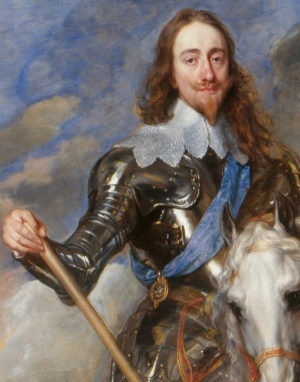
However van Dyck’s most significant message about Charles is his supremacy as a military leader. The presence of a triumphal arch – a structure built to celebrate and commemorate victories in ancient Rome – implies that this English King is the natural heir to the triumphant emperors of the classical past.
Charles’s highly polished armor and baton of command compound this message, as does the blue sash around his chest and medallion at his hip, which shows him to be a member of the Order of the Garter, the most prestigious knighthood in England. Thus, Charles is appropriating the iconography of medieval knights-errant, as well as classical rulers, in order to appeal to his audience’s sense of history.
The Baroque arrives in England
King Charles I was a great lover of the arts, and during his reign he amassed an unrivaled collection of European Renaissance paintings and sculptures. He was just as much a fan of the more up-to-date Baroque style, with its dynamic compositions and psychological intensity, and so he acquired works by Caravaggio, Peter Paul Rubens, and Gianlorenzo Bernini among many other Baroque artists.
Charles’s main coup was employing the Flemish artist Anthony van Dyck as his official court painter in 1632. Charles I with M. de St. Antoine was commissioned to be hung in the King’s gallery at St. James’s Palace in London, and it was certainly intended to compete with the other Renaissance and Baroque paintings on display. Its scale is vast — the dimensions more usually associated with tapestries — and it was probably hung at the end of a long corridor, creating the illusion of an aperture in the palace walls and a view onto a vista beyond.
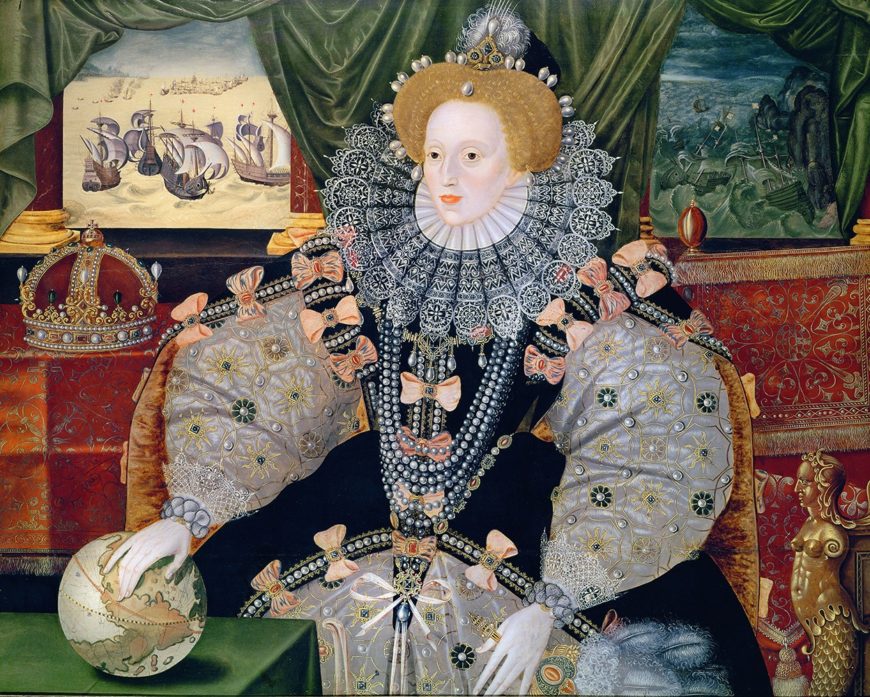
In comparison to previous portraits of English monarchs such as Elizabeth I’s Armada Portrait, van Dyck’s work is rich in color, replete with observed detail, and possesses a Baroque sense of movement and grandeur. It shows that Charles I was on-trend, learning from other European images of power, such as Peter Paul Rubens’s 1603 Equestrian Portrait of the Duke of Lerma, and aiming to lead English artistic tastes along continental lines.
A political statement
This progressive attitude to the arts came at a political cost. Charles’s critics in England saw the king’s interest in foreign styles as evidence of his softening attitudes to Catholic sensibilities (England had broken from the Catholic church a hundred years earlier during the Protestant Reformation), and his court’s ideological detachment from the rest of the nation. These clashes contributed to Parliament’s animosity towards the crown, which in turn led to the English Civil War (1642–51).
In the years leading up to the civil war, Parliament frustrated the king’s military ambitions by curbing his ability to raise money through taxation. In 1629 Charles retaliated by dissolving Parliament and governing the nation independently in an eleven-year period of “personal rule.” Charles I with M. de St. Antoine, painted during this period of autocracy, encapsulates the King’s notion of independent authority, and his belief in the divine right of kings (the notion that God had sanctioned his right to rule). Indeed, there is something saintly about the depiction of Charles in this painting, judging by his pristine white horse and the awed expression of the Seigneur de St. Antoine. Perhaps the courtly audience of this painting may have seen Charles as a modern embodiment of St. George — the dragon-slaying patron saint of England who was typically represented as a valorous knight.
Legacy
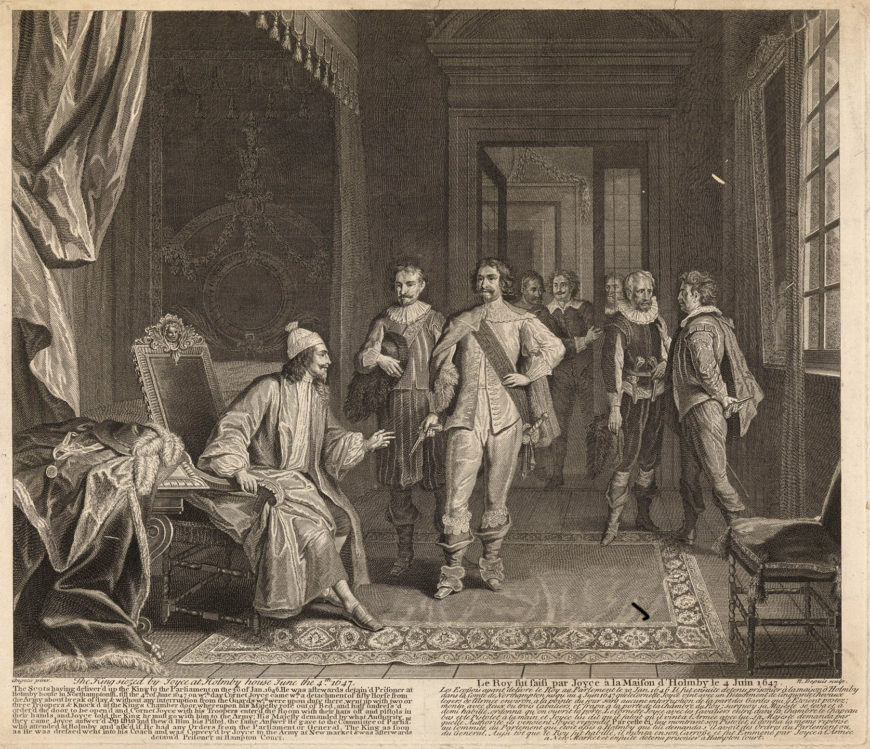
After the Parliamentarians won the English Civil War, Charles I was put on trial, found guilty of treason, and condemned to be beheaded. In the aftermath England became a republic and many of Charles’s possessions (including his extraordinary art collection), was sold off to raise funds for the new political regime. Charles I with M. de St. Antoine went to an Englishman named Hugh Pope for £150. However the royal family was re-instated in England later in the seventeenth century and they quickly bought back the painting. It remains in the royal collection to this day.
Meanwhile, van Dyck’s fluid, sensuous style of portraiture has had a lasting effect on English art, emulated by many of the nation’s greatest portrait painters including Thomas Gainsborough, Thomas Lawrence, and the American expatriate John Singer Sargent.
Additional resources
This painting at the Royal Collection Trust
Read more about Rubens and van Dyck at the Metropolitan Museum of Art
Read more about The Armada Portrait of Elizabeth I
Anthony van Dyck, Equestrian Portrait of Charles I
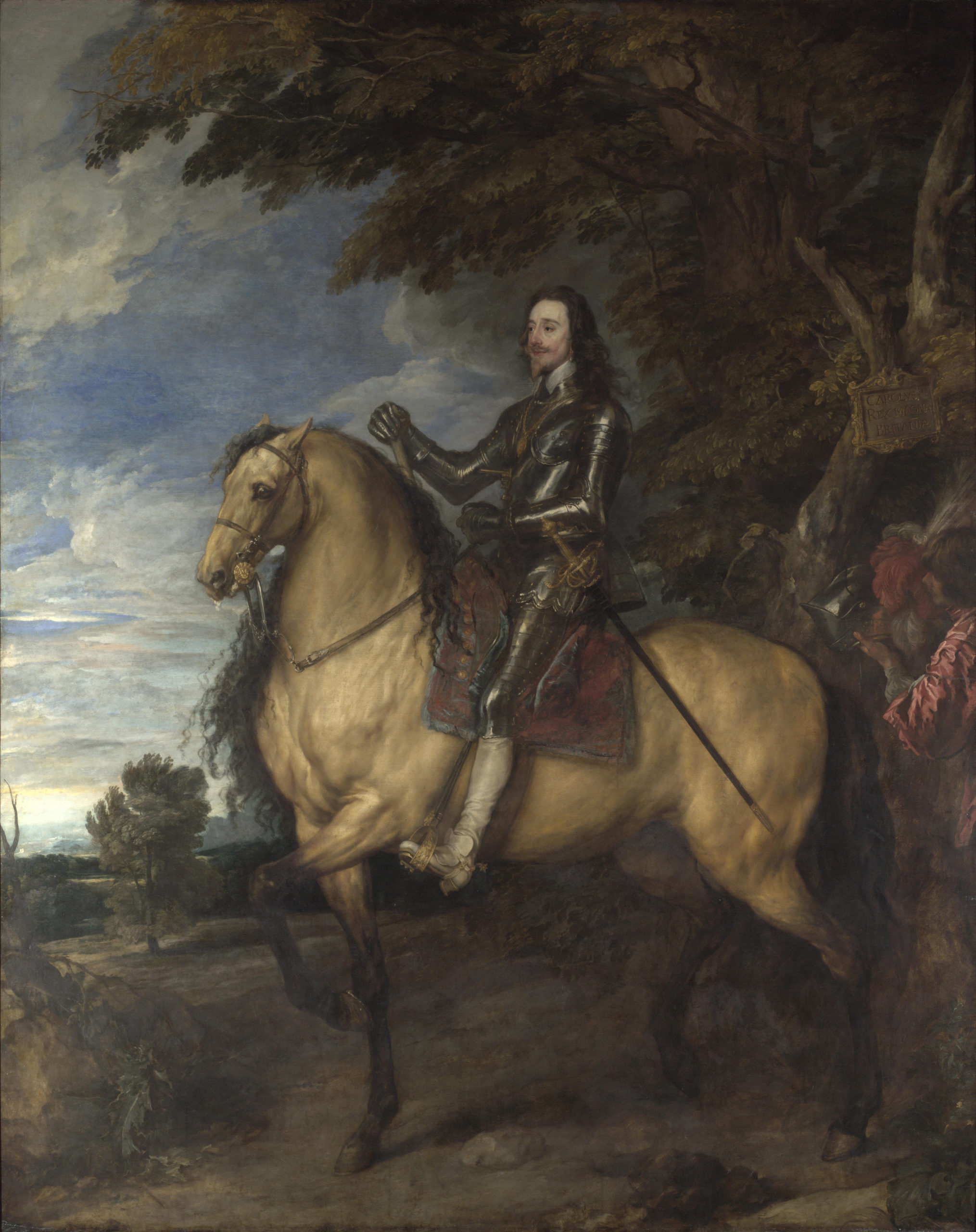
Royalty writ large
There is no more majestic painting in the National Gallery, London, than Anthony van Dyck’s equestrian portrait (with the subject on horseback) of the cultivated, but deeply flawed, politically inept, and unlucky King Charles I, who ended his days beheaded on a scaffold erected outside the Banqueting House in Whitehall, having been found guilty by the English Parliament of being a “tyrant, traitor, murderer, and public enemy to the good people of the nation.”
Painted before the bloody troubles of the English Civil Wars ensued, when the king governed without Parliament, a period known as the Personal Rule (1629–40), this monumental painting calls on us to admire and respect the armored monarch seated atop his stately steed.
Positioned at the level of his stirrup, the spectator is forced to look up to the king, who was, in reality, only 5 foot 4 inches tall. On closer inspection, his face, in three-quarter view, is a pale complexion of dignified restraint. He wears his hair long on the left side (called a “lovelock”) and has a large pearl earring in his left ear, both of which reflect the court fashion of the day.
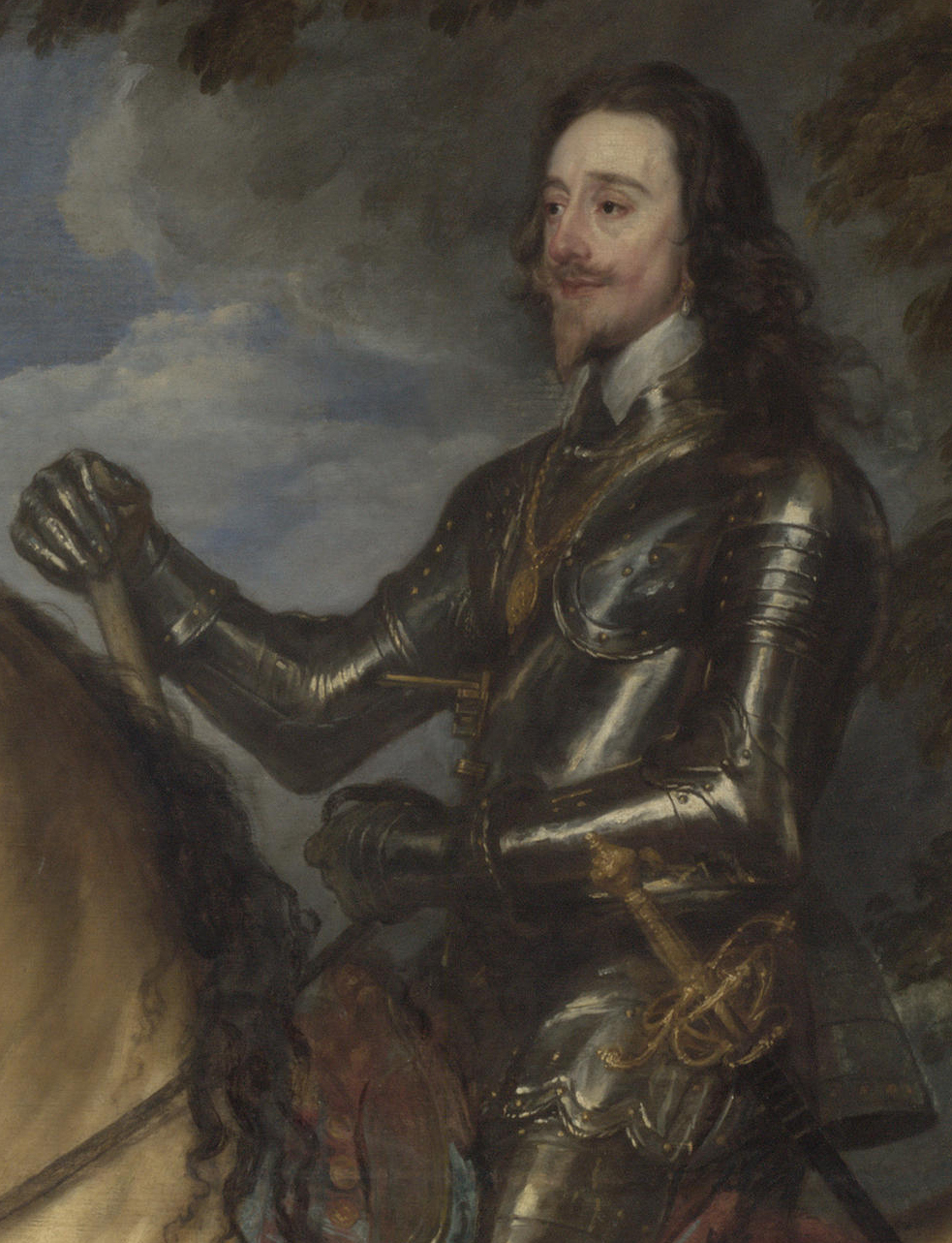
From the right side of his body armor protrudes a lance-rest, indicating his involvement in tilting tournaments. Despite suffering from rickets in his childhood, Charles developed into a most accomplished and confident horseman. The king grasps the reins in his left hand and holds an imperial baton in his right hand, which he rests almost nonchalantly on the right withers of his dun horse.
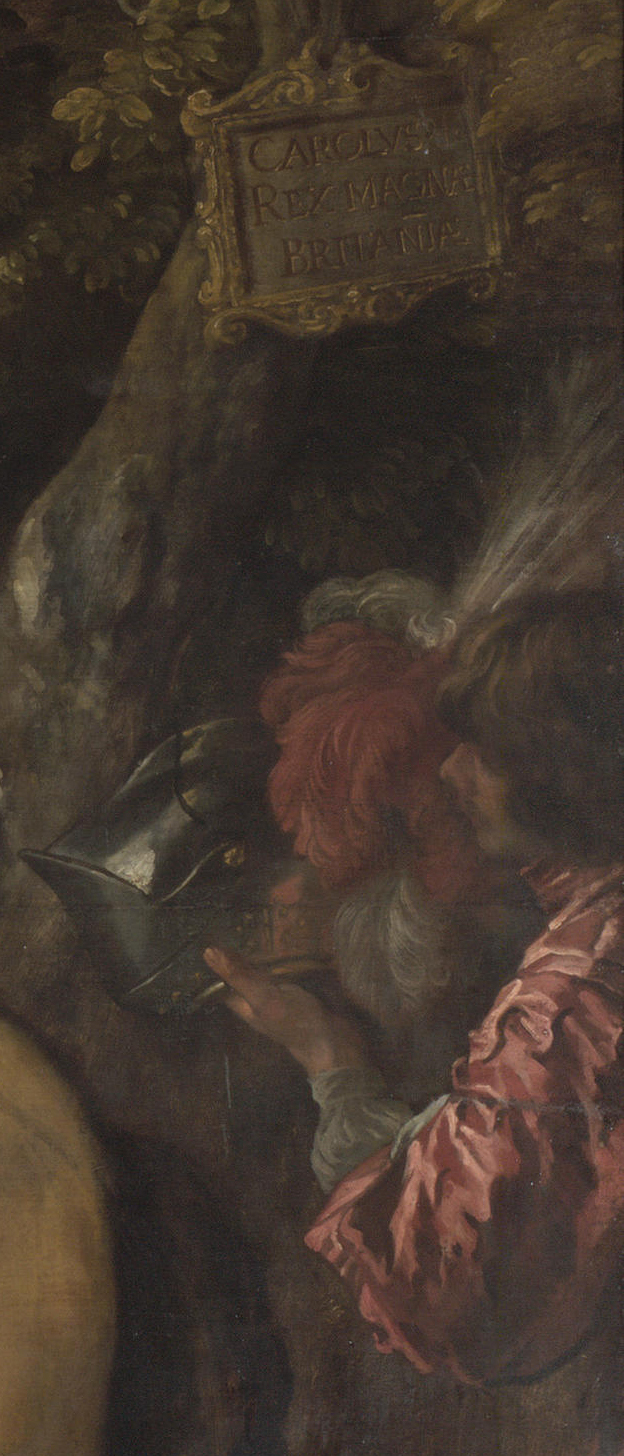
Around the neck of the king hangs a gold locket or medallion which bears the likeness of Saint George and the Dragon, known as the Lesser George. Saint George, the archetypal Christian knight, is the patron of the Most Noble Order of the Garter, which was a medieval order of chivalry (a society of knights or equestrian order which had originally been founded by King Edward III in 1348). The monarch was—and still is—the so-called Garter Sovereign. The locket, which contained a portrait of Charles’s devoted French wife, Queen Henrietta Maria, remained on his person on the freezing cold January day in 1649 when he was executed.
Behind the monarch is an equerry who carries the king’s red-and-white plumed helmet in readiness for him to participate in a tournament—or perhaps to take up arms in war if there be a need?
Above the equerry, tied to an oak tree, is a tablet on which is inscribed in Latin the title CAROLUS REX MAGNAE BRITANIAE (“King Charles of Great Britain”), a reminder of the fact that Charles, like his father James VI of Scotland and I of England before him, was sovereign of the so-called multiple kingdoms of England and Wales, Scotland and Ireland. All is situated in a calming, imagined, wooded landscape of muted colors.
Charles is depicted not only as king, but also as emperor of the Britons and a Christian warrior, who commands all that he surveys. He is master of his horse, champion tilter, leader of a group of chivalrous knights, governor of nature, and the serene and silent ruler of a seemingly peaceful and bountiful kingdom. These are some of the key messages which the principal court painter, Anthony van Dyck, wished to convey on behalf of his exalted patron.
The artist Anthony van Dyck
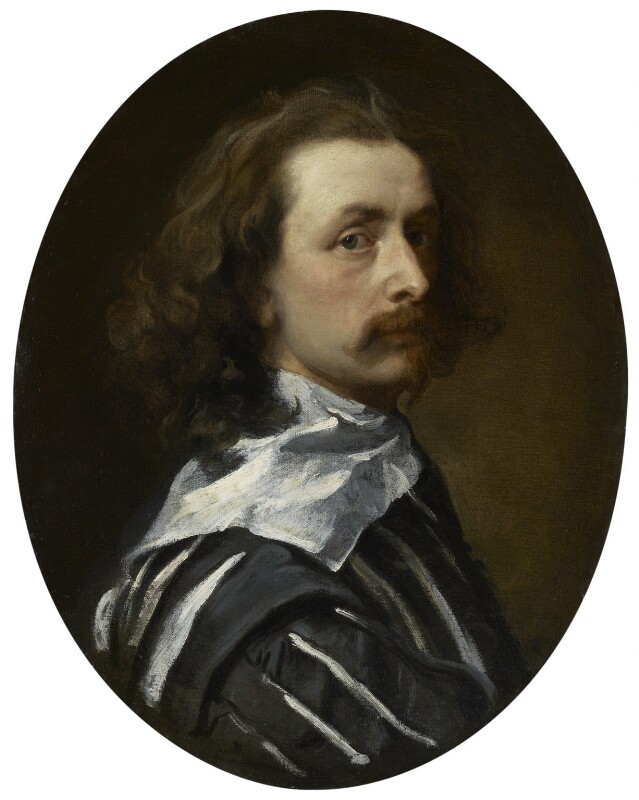
It is no understatement to assert that the Flemish artist Sir Anthony van Dyck virtually single-handedly brought about a revolution in portrait painting in early seventeenth-century England. This revolution would fashion British portrait painting for centuries to come, influencing the likes of Sir Peter Lely, Sir Joshua Reynolds, and Sir Thomas Lawrence.
With his first arrival in England in 1620, the eventual ‘principalle Paynter in Ordenarie to their Majesties’ (King Charles I and Queen Henrietta Maria) brought with him the Italian tradition of painting as filtered through the studio of the Flemish master Rubens, of whom van Dyck was a disciple. A tireless worker who died, exhausted, at the age of 42, van Dyck painted almost exclusively portraits at the Caroline court, around 400 in total, including some 40 images of King Charles. Van Dyck was buried in Old St. Paul’s Cathedral with the epitaph, “Anthony van Dyck—who, while he lived, gave to many immortal life.”
The precise origins of the portraits of Charles I painted by van Dyck remain shrouded in mystery. It seems highly likely that the two collaborated closely to propagate the royal image because of the artistic sensibilities and clearly defined political outlook of Charles I. The conversations they had to these ends must have been truly fascinating.
Imperial majesty and Christian virtue
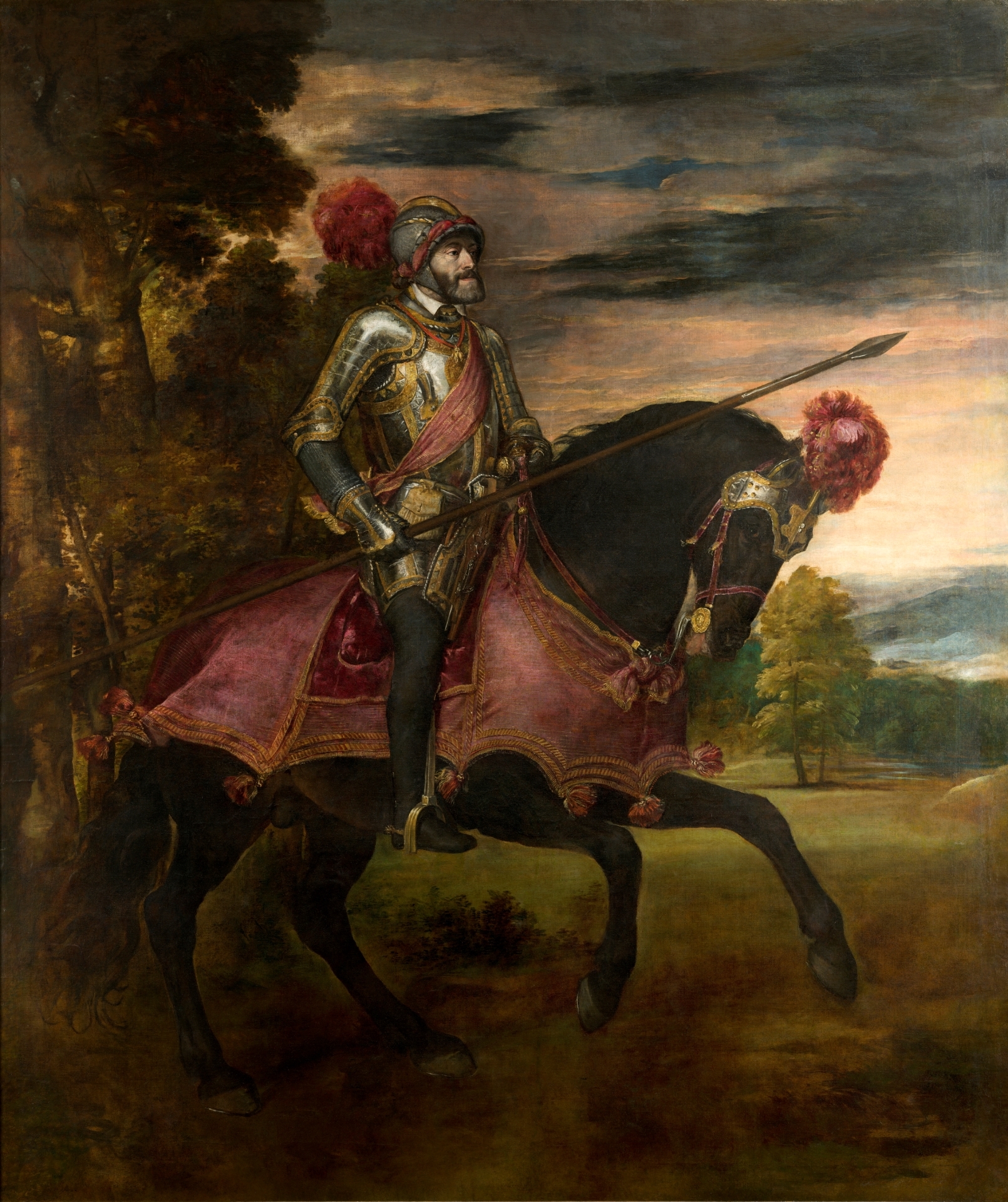
The major pictorial inspiration for van Dyck’s equestrian portrait of Charles I was certainly Titian’s magnificent equestrian portrait of the Habsburg Emperor Charles V at Mühlberg, housed in the Prado, Madrid, a painting which Charles I would have seen during his six-month stay at the Spanish Habsburg court of Philip IV. Van Dyck also had a passion for Venetian art, most especially the mighty Titian.
In this seminal painting, which celebrates his victory over the Schmalkaldic League, Charles V, the Catholic Holy Roman Emperor, king of Spain and archduke of Austria, unquestionably the most powerful leader in sixteenth-century Europe, is shown seated on his horse in woodland surroundings. Fully armored, wearing a red-plumed helmet, he charges forth into battle. Virgin and Child on his breastplate, he announces his Christian credentials as in fact a universal emperor who rules over a mosaic of states and different religions—Catholic and Protestant. The lance in his right hand invokes the figure of Saint George, the model Christian knight. All is set beneath a brooding sky which is laced with gold light.
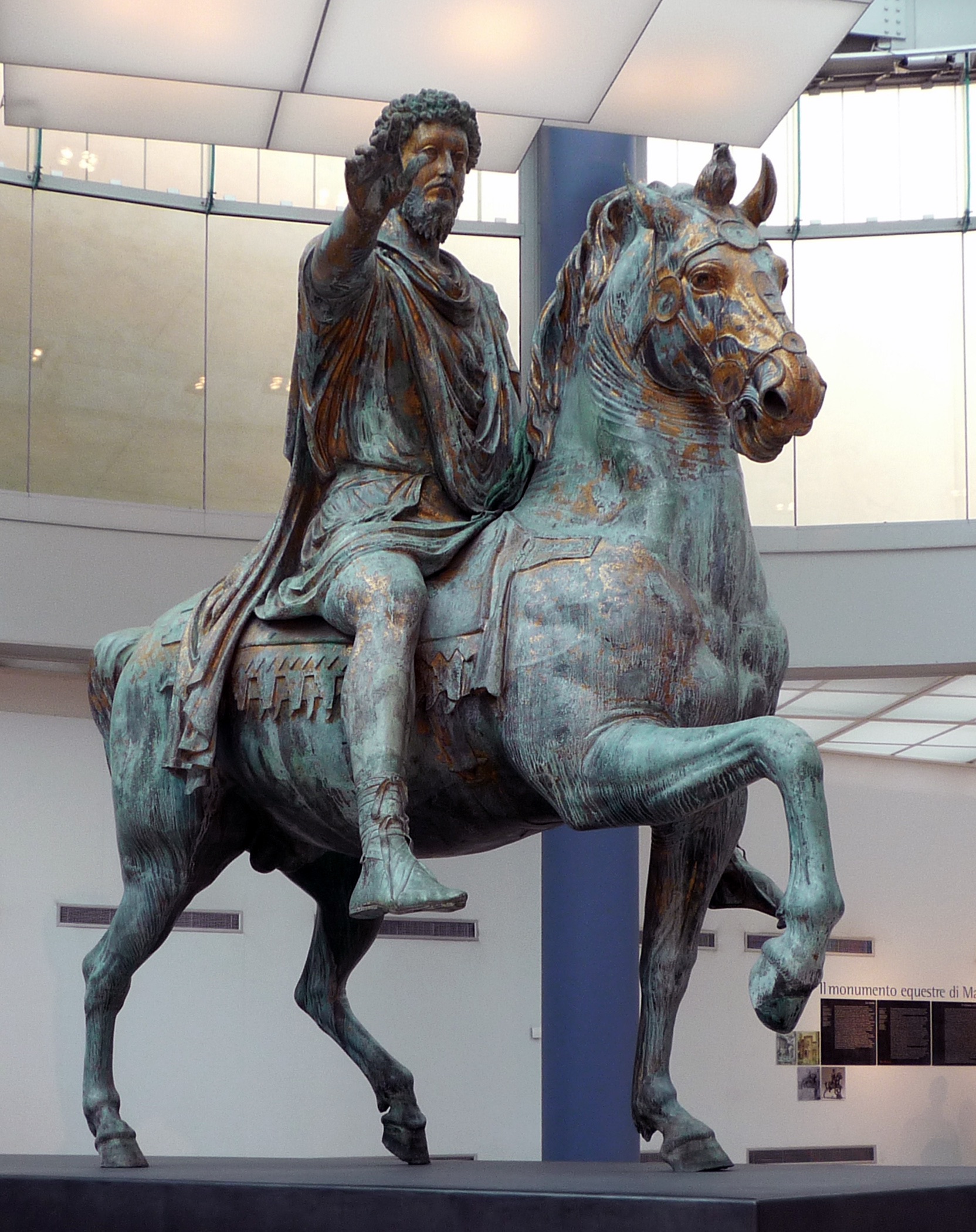
The painting recalls the famous equestrian bronze of the Roman philosopher-emperor Marcus Aurelius, to be found in the Campidoglio in Rome, and is also influenced by Dürer’s engraving Knight, Death, and the Devil, whose horseman embodies moral virtue as per the medieval tradition. Titian’s Charles V channels both ancient Roman imperial rule and the idea and ideal of the virtuous Christian knight.
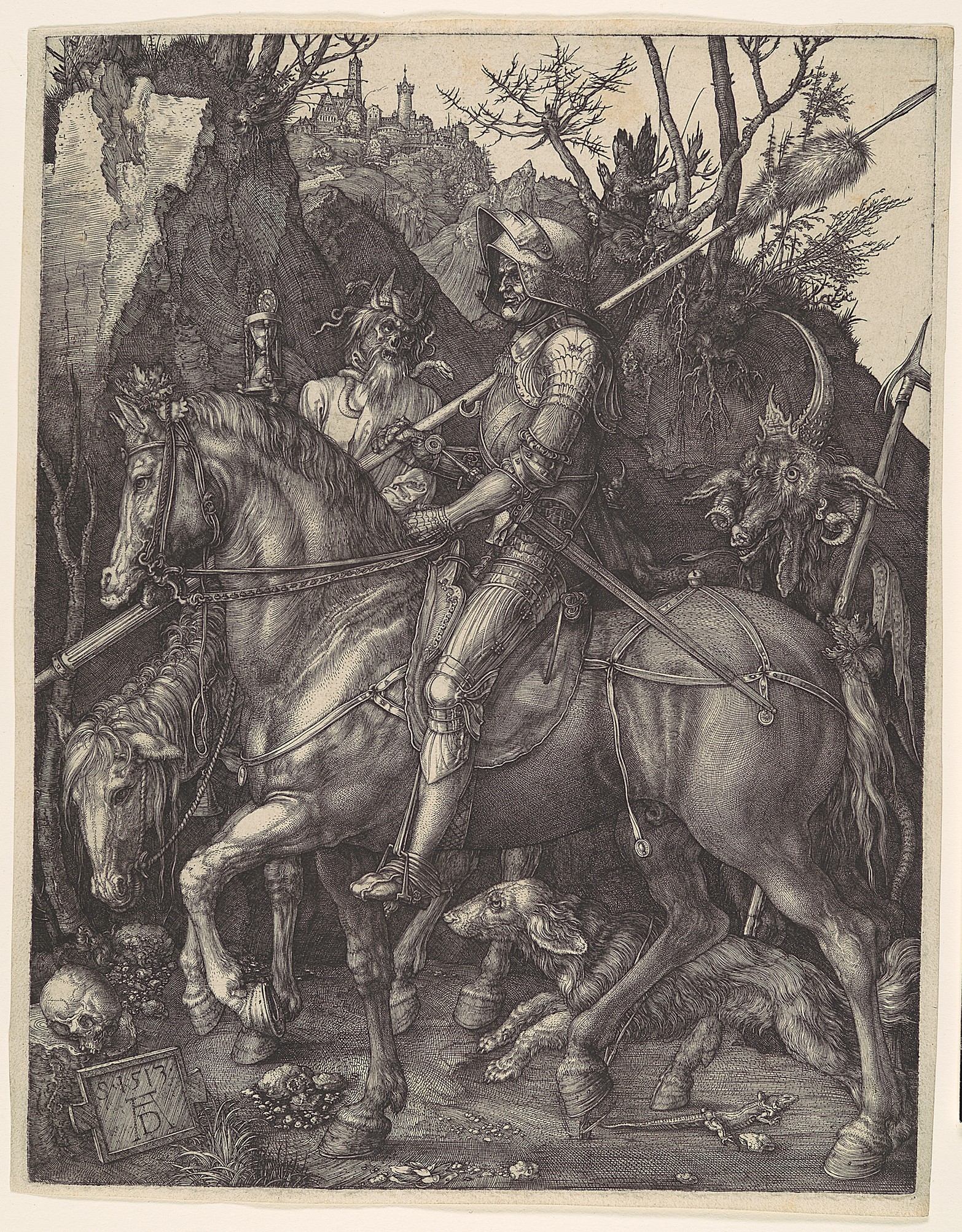
A reputation redeemed
In basing the Equestrian Portrait of Charles I on that of Titian’s Charles V at Mühlberg, van Dyck was tracing an imperial lineage running back not only to the Holy Roman emperors but also to the Roman emperors of antiquity, as well as making a claim for Charles I as a virtuous Christian knight. This was a line of rulership and a religious iconography which was entirely appropriate for Saint George’s Garter Sovereign of Great Britain, who purported to govern all that he surveyed as king and emperor of the Britons and a Christian cavalryman personified. Alas, for Charles I, he was not able to convert his vision of an imperial, virtuous, and divinely-inspired majesty to which he adhered so resolutely, so defiantly, so eloquently, into successful and pacific governorship of his troubled multiple kingdoms. For this failure, he paid with his life, as well as with his historical reputation.
Additional resources:
Susan. J. Barnes, Nora De Poorter, Oliver Millar and Horst Vey, Van Dyck: A Complete Catalogue of the Paintings (The Paul Mellon Centre for Studies in British Art) (New Haven and London: Yale University Press, 2004).
Christopher Brown, Van Dyck (Oxford: Phaidon, 1982).
Christopher Brown and Hans Vlieghe, Van Dyck 1599-1641 (London: Royal Academy Publications; Antwerp: Antwerpen Open, 1999).
David Cressy, Charles I and the People of England (Oxford: Oxford University Press, 2015).
Richard Cust, Charles I: A Political Life (London and New York: Routledge, 2007).
Karen Hearn (ed), Van Dyck and Britain (London: Tate Britain, 2009).
Mark Kishlansky, Charles I: An Abbreviated Life (Penguin Monarchs) (London: Penguin, 2014).
Mark A. Kishlansky and John Morrill, “Charles I (1600–1649),” Oxford Dictionary of National Biography, Oxford University Press, 2004; online edn.
Oliver Millar, The Age of Charles I: Painting in England 1620-1649 (London: Tate, 1972).
Oliver Millar, Van Dyck in England (London: National Portrait Gallery, 1982).
Alexander Samson (ed.), The Spanish Match: Prince Charles’ Journey to Madrid, 1623 (Aldershot, Hampshire: Ashgate, 2006).
Kevin Sharpe, Image Wars: Promoting Kings and Commonwealths in England, 1603-1660 (New Haven and London: Yale University Press, 2010).
Kevin Sharpe, The Personal Rule of Charles l (New Haven and London: Yale University Press, 1992).
Desmond Shawe-Taylor and Per Rumberg (eds.) Charles I: King and Collector (London: Royal Academy of Arts, 2018).
Roy C. Strong, Van Dyck: Charles I on Horseback (London: Viking Press, 1972).
Jeremy Wood, “Anthony Van Dyck (1599–1641),” Oxford Dictionary of National Biography, Oxford University Press, 2004; online edn.
Leanda de Lisle, White King: Charles I, Traitor, Murderer, Martyr (London: Chatto & Windus, 2018).
Charles I as art collector
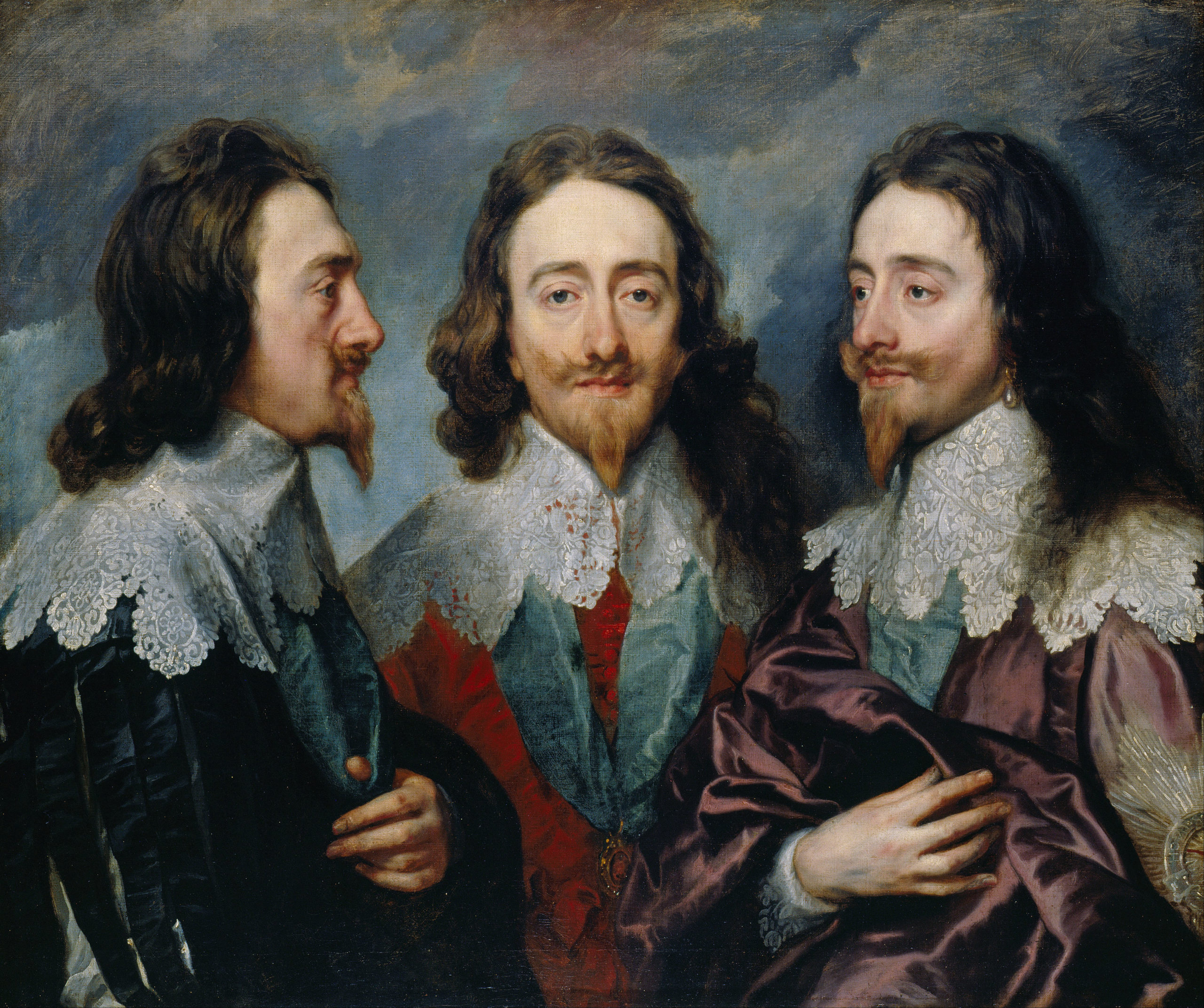
The patron Charles I and his circle
Whatever his character failings and political misdeeds as monarch might have been, King Charles I was undoubtedly a refined individual and a great collector and connoisseur of art. The Flemish painter Sir Peter Paul Rubens famously called him: “The greatest lover of paintings among the princes in the world.” He was the connoisseur-king who amassed the largest collection of art of any British monarch in history (around 1,500 paintings and 500 sculptures of the very highest quality), replete with stellar Renaissance names such as Andrea Mantegna, Leonardo da Vinci, Giorgione, Raphael, Correggio, Titian, Holbein, and Dürer, as well as two outstanding contemporary artists, Rubens and van Dyck.
Charles’s interests and tastes were shaped from an early age by his family. He was the son of the scholar-king James VI and I and his cultured Danish wife, Queen Anne, who was an important patron of art, architecture, and music, and the brother of Henry, prince of Wales (a true Renaissance prince if ever there was one, a major collector of mannerist paintings of northern Italian and Netherlandish artists, who died of typhoid fever at the young age of 18, much to Charles’s heartache).
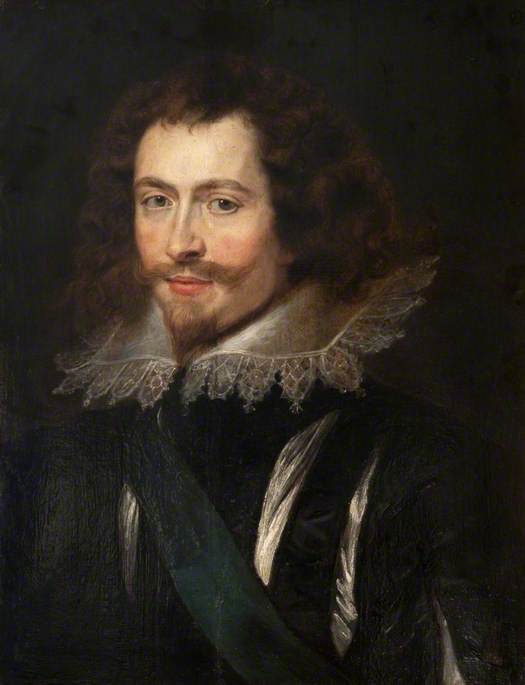
There was also the tutelage of the dashing and dangerous George Villiers, 1st duke of Buckingham, James VI and I’s favorite (and most likely lover), a savvy collector of art who favored Italian painters, most especially the Venetian artist Titian. He owned, for example, Titian’s stunning Ecce Homo (‘behold the man’), which shows Christ bloodied and bowed, wearing a crown of thorns, being led out of the Praetorium (“judgment hall” or “governor’s house’”) by Pontius Pilate, governor of Judaea, to the shouting crowd. Buckingham became Charles’s inseparable companion and mentor until the duke’s untimely death at the point of an assassin’s dagger in 1628.
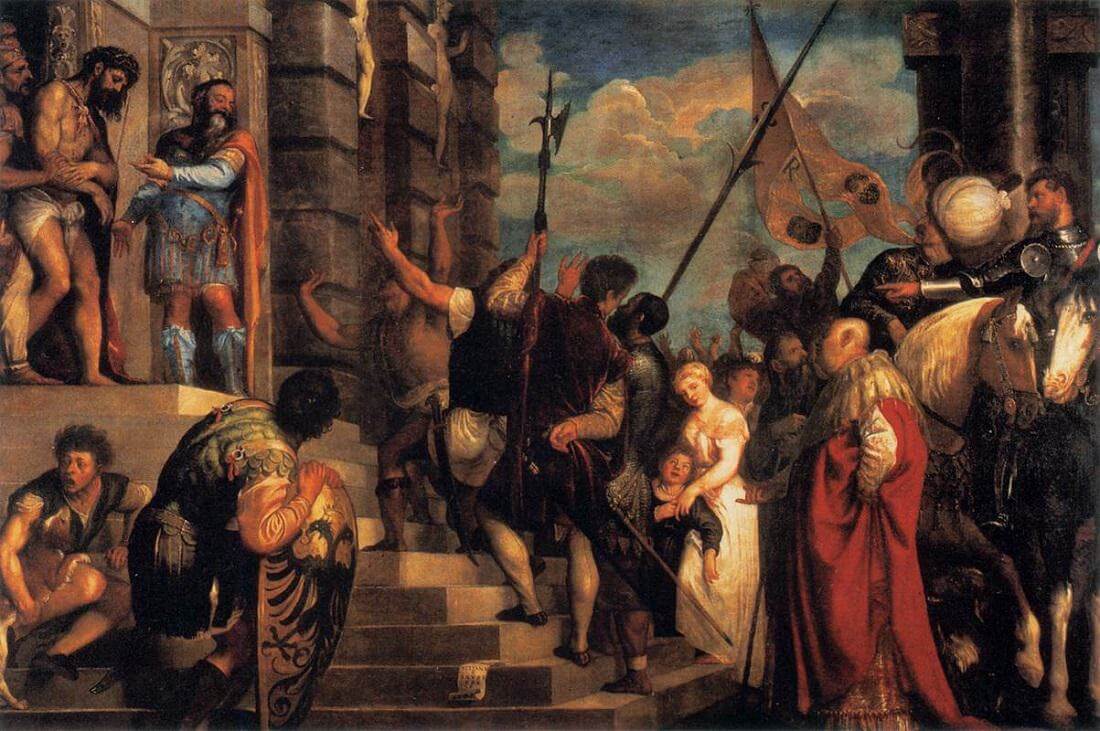
In stark contrast to Buckingham, there was the figure of the austere and high-minded Thomas Howard, 14th earl of Arundel, who did much to foster Charles’s enthusiasm for and taste in Italian art, though at a distance. An admirer of continental European cultures, Arundel was one of the richest aristocrats in England; some 600 paintings, including 37 works by Titian, were accounted for at the earl’s death.
And, finally, there was James, 3rd marquess, later 1st duke of Hamilton, who served as the Master of the Horse and Gentleman of the Bedchamber to the king, both distinguished and powerful offices of the sovereign’s household, which brought him into regular and close contact with Charles. In avaricious competition with Buckingham and Arundel, Hamilton amassed a huge collection of Italian Renaissance art which included works by Raphael and Correggio and the celebrated Venetian artists Giorgione, Veronese, Tintoretto, and, yet again, betraying the Caroline English court’s predilection, over 36 works by Titian, who was also an artist beloved of the court of Habsburg Spain.
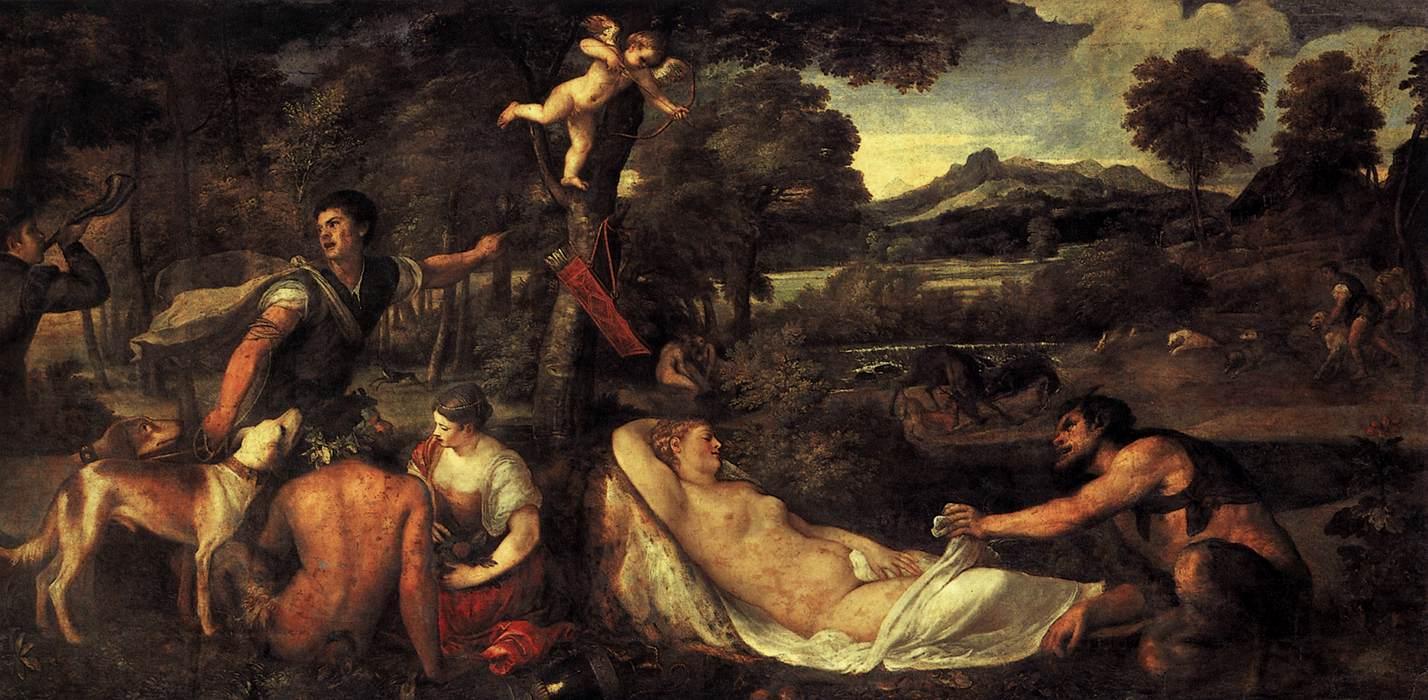
A stay at the Spanish Habsburg court
By far the most important single experience in developing Charles’s artistic appetite when still prince of Wales, was the six-month stay, in 1623, alongside his confidant, Buckingham, at the court of the Spanish Habsburg king, Philip IV, in Madrid, a court renowned for its rigid formality and complicated protocols, as well as for housing the greatest collection of paintings in Europe. This took place at the time of the Thirty Years’ War (1618–48), a religious conflict between Catholic and Protestant states in central Europe.
Charles and Buckingham traveled incognito—in wigs and false beards—as “Jack and Tom Smith” and caused something of a stir at the court. The visit was intended to negotiate for the hand of the Spanish Infanta Maria Anna (sister of Philip IV) to help cement peace between the Catholics and Protestants. In the end, it came to nothing, much to the relief of the Protestant Parliament and people in England who had feared a marriage between their Protestant prince and a Catholic princess, who was, after all, progeny of their traditional enemy Spain.
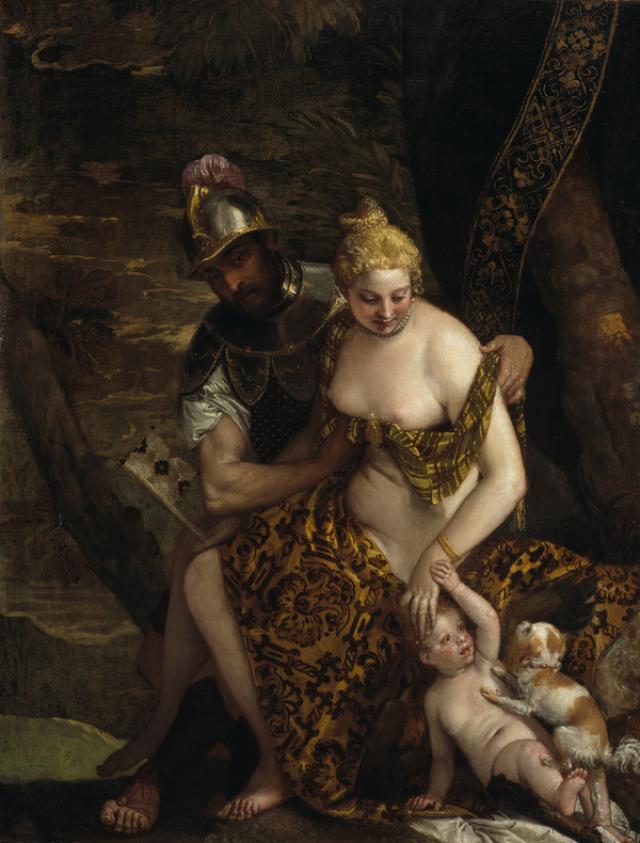
Instead, here, Charles feasted his hungry eyes on many works by European masters, including Titian (who had been court painter to the imperial Habsburg court in the sixteenth century), Correggio, Hieronymus Bosch, and Diego Velázquez, court painter to Philip IV. Charles was nothing short of over-awed by what he saw and left the court gifted with two splendid paintings by Venetian artists. One was by Titian, the so-called Pardo Venus (Titian’s largest mythological painting) in which Jupiter, father of the gods, disguised as a satyr, moves towards Antiope, who is in the form of nymph, to impregnate her, after which she gives birth to twins, Amphion and Zethus (a story told in Ovid’s Metamorphoses). The other was Veronese’s sensual masterpiece Mars, Venus, and Cupid, in which Venus rests on the knee of Mars, god of war, with Cupid and a lapdog playing at her side.
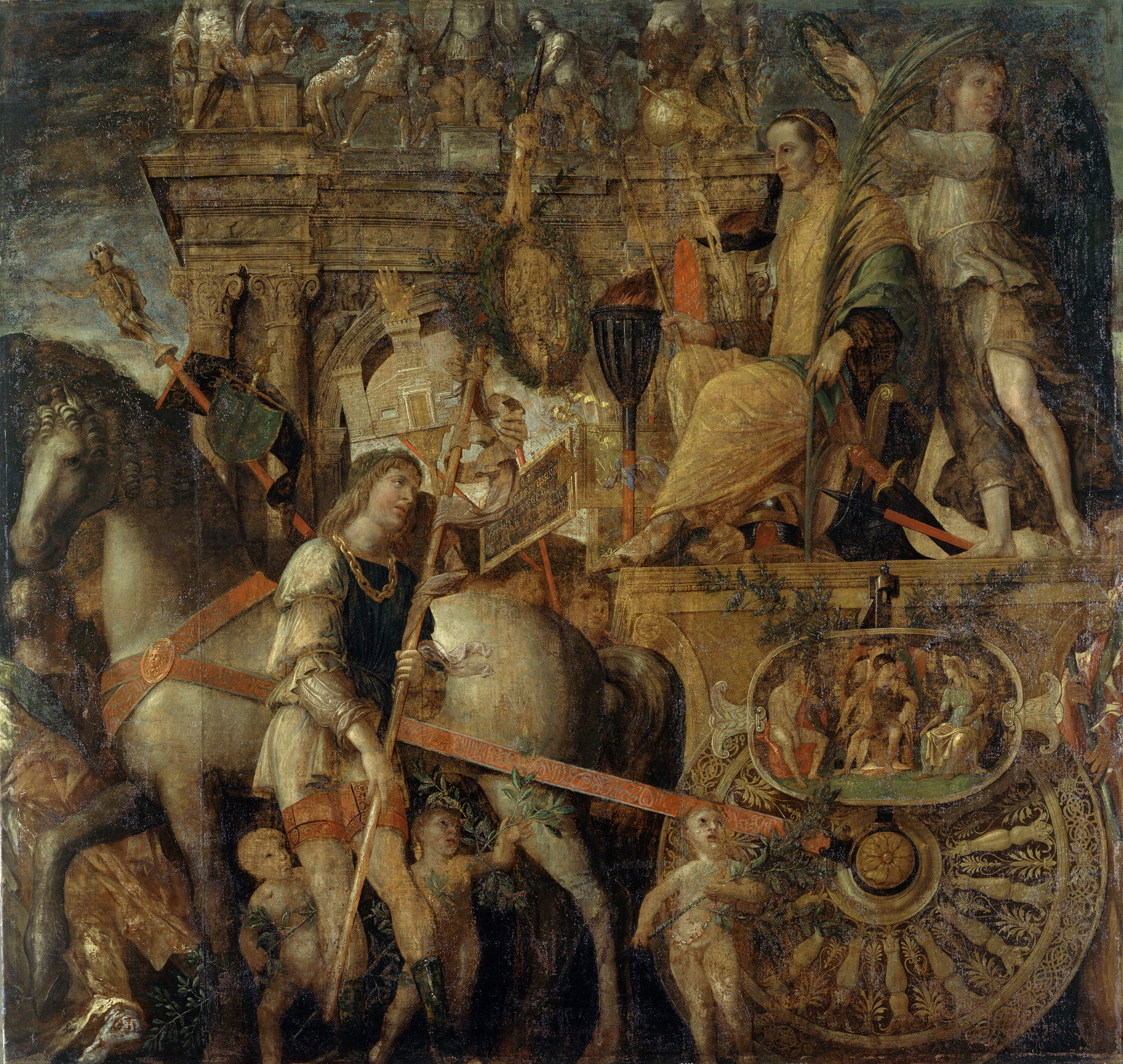
The consequence of the visit was that Charles set his heart on a comparable collection of art for his own court when king. His wish was granted in 1628, when the collection of the Gonzaga dukes of Mantua came up for sale. Charles purchased it at a colossal cost (it took him two years to pay what he owed). The jewels in the crown of the collection were without question Titian’s eleven half-length portraits of Roman emperors (1536–40; destroyed by fire in 1734) which were inspired by the Roman historian Suetonius’s Lives of the Caesars and the nine canvases of Italian renaissance painter Andrea Mantegna’s Triumphs of Caesar, which celebrated the victories of Julius Caesar and have resided in Hampton Court Palace for nearly 400 years. One cannot underestimate the impact of this collection on Caroline court culture—it was nothing less than transformative. Charles was pivotal in bequeathing an incomparable artistic legacy to the history of the visual arts in Great Britain. For this, we should be thankful.
Additional resources:
Read more about Anthony van Dyck’s life at the National Gallery of Art
The Lost Collection of Charles I from the Royal Collection Trust
Susan. J. Barnes, Nora De Poorter, Oliver Millar and Horst Vey, Van Dyck: A Complete Catalogue of the Paintings (The Paul Mellon Centre for Studies in British Art) (New Haven and London: Yale University Press, 2004).
Christopher Brown, Van Dyck (Oxford: Phaidon, 1982).
Christopher Brown and Hans Vlieghe, Van Dyck 1599-1641 (London: Royal Academy Publications; Antwerp: Antwerpen Open, 1999).
David Cressy, Charles I and the People of England (Oxford: Oxford University Press, 2015).
Richard Cust, Charles I: A Political Life (London and New York: Routledge, 2007).
Karen Hearn (ed), Van Dyck and Britain (London: Tate Britain, 2009).
Mark Kishlansky, Charles I: An Abbreviated Life (Penguin Monarchs) (London: Penguin, 2014).
Mark A. Kishlansky and John Morrill, “Charles I (1600–1649),” Oxford Dictionary of National Biography, Oxford University Press, 2004; online edn.
Oliver Millar, The Age of Charles I: Painting in England 1620-1649 (London: Tate, 1972).
Oliver Millar, Van Dyck in England (London: National Portrait Gallery, 1982).
Alexander Samson (ed.), The Spanish Match: Prince Charles’ Journey to Madrid, 1623 (Aldershot, Hampshire: Ashgate, 2006).
Kevin Sharpe, Image Wars: Promoting Kings and Commonwealths in England, 1603-1660 (New Haven and London: Yale University Press, 2010).
Kevin Sharpe, The Personal Rule of Charles l (New Haven and London: Yale University Press, 1992).
Desmond Shawe-Taylor and Per Rumberg (eds.) Charles I: King and Collector (London: Royal Academy of Arts, 2018).
Roy C. Strong, Van Dyck: Charles I on Horseback (London: Viking Press, 1972).
Jeremy Wood, “Anthony Van Dyck (1599–1641),” Oxford Dictionary of National Biography, Oxford University Press, 2004; online edn.
Leanda de Lisle, White King: Charles I, Traitor, Murderer, Martyr (London: Chatto & Windus, 2018).
John Michael Wright, The Coronation Portrait of Charles II
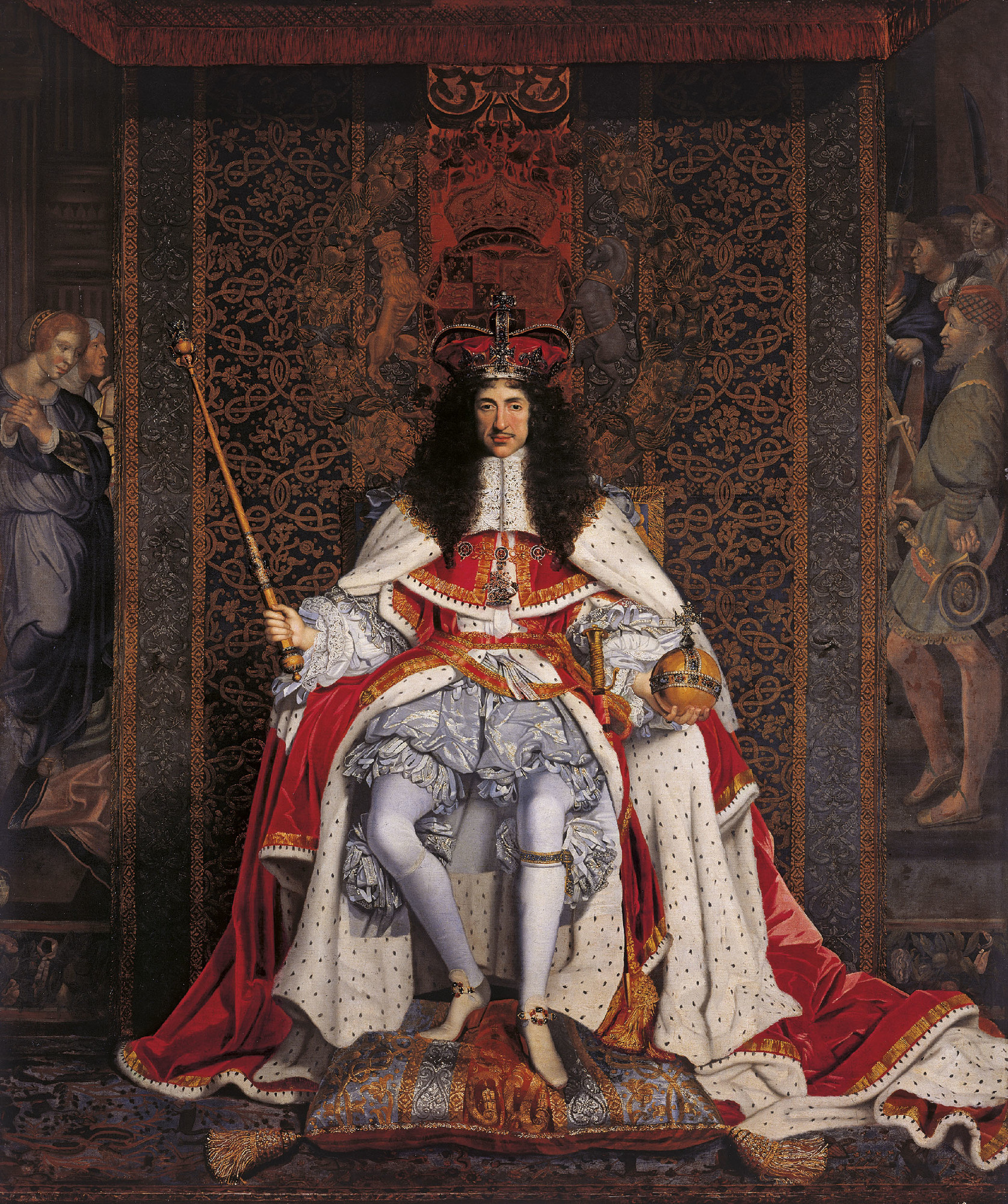
In this portrait of Charles II, his extravagant attire not only reflects his power and status as the King of England but the masculine ideal of the period. His curly wig is long, his clothing is heavily ornamented with lace, embroidery, and ribbons, and he wears white hose and high heeled shoes — elements of dress that are today considered markers of femininity. It is such details that are often linked to gender (the cultural construction of identity that marks bodies as male, female or gender neutral). Given that these markers change over time and from place to place, a reading of the clues embodied in a sitter’s dress in a portrait must take into account the cultural norms of the period as well as the place in which the artwork was created. This oil portrait of one of the most beloved kings of England tells an interesting story of how markers of masculinity and femininity change over time.
What is Charles II wearing?
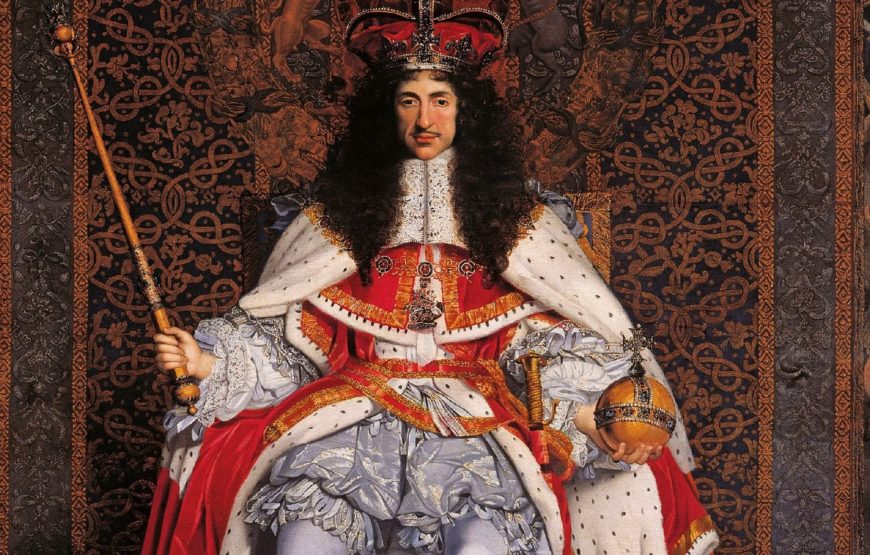
The King of England wears the Crown of State on his head and holds in his hands the orb and scepter — symbols of his power. He is dressed in a costly and theatrical outfit suitable for a coronation. His Order of the Garter (the most senior order of knighthood in the British honors system) costume is made of cloth of silver and is topped with luxurious crimson red silk velvet robes lined with ermine that surround his body and pool to the floor. The sleeves of his white shirt are full and expansive with deep double cuffs of sumptuous lace. His fashionably wide petticoat breeches envelop his thighs in a mass of balloon-like folds and are ornamented with multiple rows of ribbon loops. His white stockings are held up with garters that explode in bunches of ribbon loops. His red heeled shoes are made of the finest kid leather and finished with buckles decorated with jewels.
Although this work by British artist John Michael Wright depicts the King’s coronation in 1661, scholars believe that it may have been painted several years later. Whether or not this portrait precisely reflects how Charles II looked that day, each element of his dress not only conveys his status and wealth, but also reflects the masculine ideal within England and France at that moment in history.
Men in heels
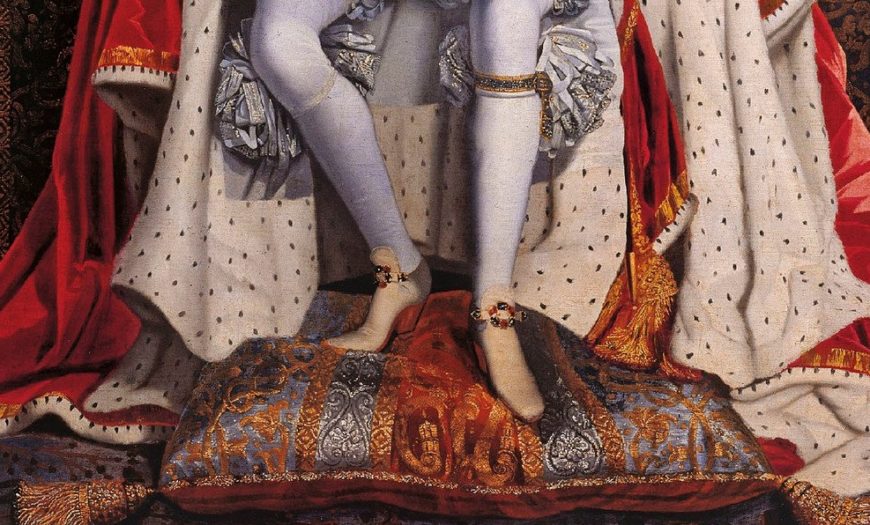
In this portrait, Charles II wears high-heeled shoes. Although such footwear is typically associated with women’s attire today, it was actually men that first adopted the style in Europe at the turn of the seventeenth century as a fashionable symbol of power and prestige. According to Elizabeth Semmelhack, Senior Curator at the Bata Shoe Museum, “Even after they fell from men’s fashion in the 1730s, there were pockets of time when heels were reintegrated into the male wardrobe not as a way of challenging masculinity but rather as a means of proclaiming it.” [1]
The fashion for petticoat breeches
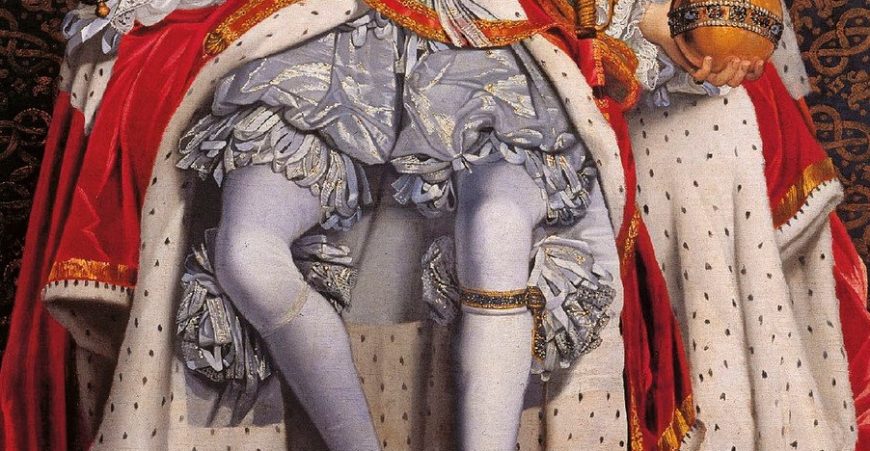
The voluminous skirt-like silhouette created by petticoat breeches (also known as “rhinegraves” in continental Europe) were fashionable for men for a brief period in the mid-seventeenth century. The width of this style of breeches made them somewhat impractical, since the wearer had to alter their gait and swing their legs out as they walked to avoid entangling their legs in the folds of fabric and the ribbons.
According to the April 6, 1661 entry in the diary of Samuel Pepys, a Member of British Parliament, his friend, a Mr. Townsend, admitted to having one day accidentally put both his legs through one of his knees of his petticoat breeches, and worn them that way for the entire day. In spite of the practical difficulties, petticoat breeches were highly fashionable for elite men until October 1666 when Charles II introduced a new fashion for men by wearing a closer fitting style of breeches that accommodated a longer style of coat.
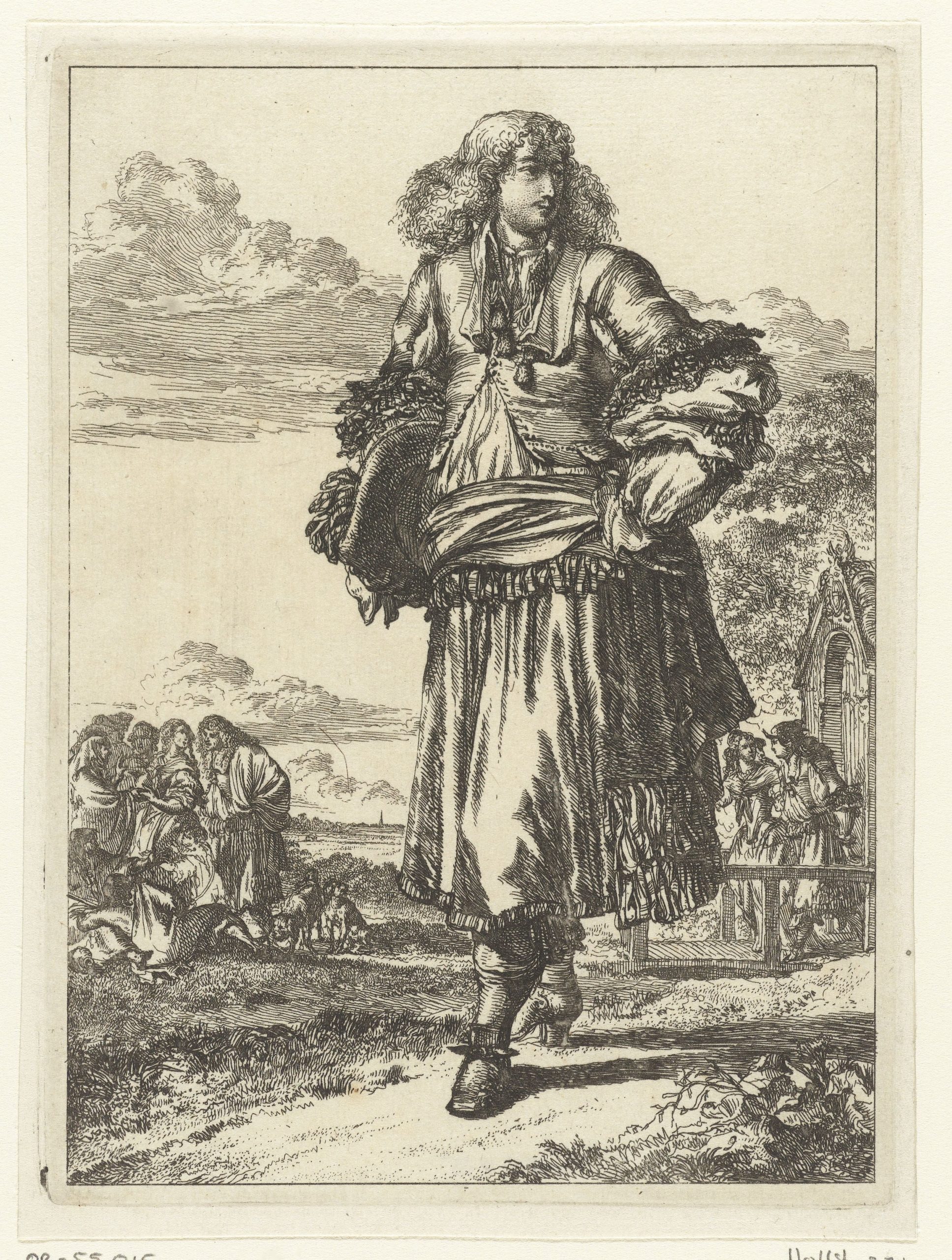
Reading the clues of dress
The way that a person is dressed in a portrait often conveys clues as to the sitter’s identity or status. Although the artist may have taken liberties in rendering their sitter more attractive than they were in real life or in dressing them in clothing that differed from what actually was worn, the manner in which the body is fashioned reveals something about the culture from which the work originated. In the coronation portrait of Charles II, he is dressed in a manner that today would be considered feminine. And yet, as this analysis has shown, his petticoat breeches, the ornate embellishment on his clothing, high heels and long hair were instead markers of power and status in his time. This reminds us that any particular item of clothing is not inherently masculine or feminine, instead it is culture that defines it thus.
Notes:
- Elizabeth Semmelhack, Standing Tall: The Curious History of Men in Heels (Toronto: Bata Shoe Museum, 2015), p. 9.
Additional resources:
This painting in the Royal Collection Trust
Rufus Bird and Martin Clayton (eds.) Charles II, Art & Power (London: Royal Collection Trust, 2017).
Ingrid E. Mida. Reading Fashion in Art (London: Bloomsbury, 2020).
Samuel Pepys. The Diary of Samuel Pepys, edited with Additions by Henry B. Wheatley (London: George Bell & Sons, 1893).
Anna Reynolds. In Fine Style: The Art of Tudor and Stuart Fashion. (London: Royal Collection Trust, 2013).
Elizabeth Semmelhack. Standing Tall: The Curious History of Men in Heels. (Toronto: Bata Shoe Museum, 2015).
The Banqueting House, Whitehall Palace
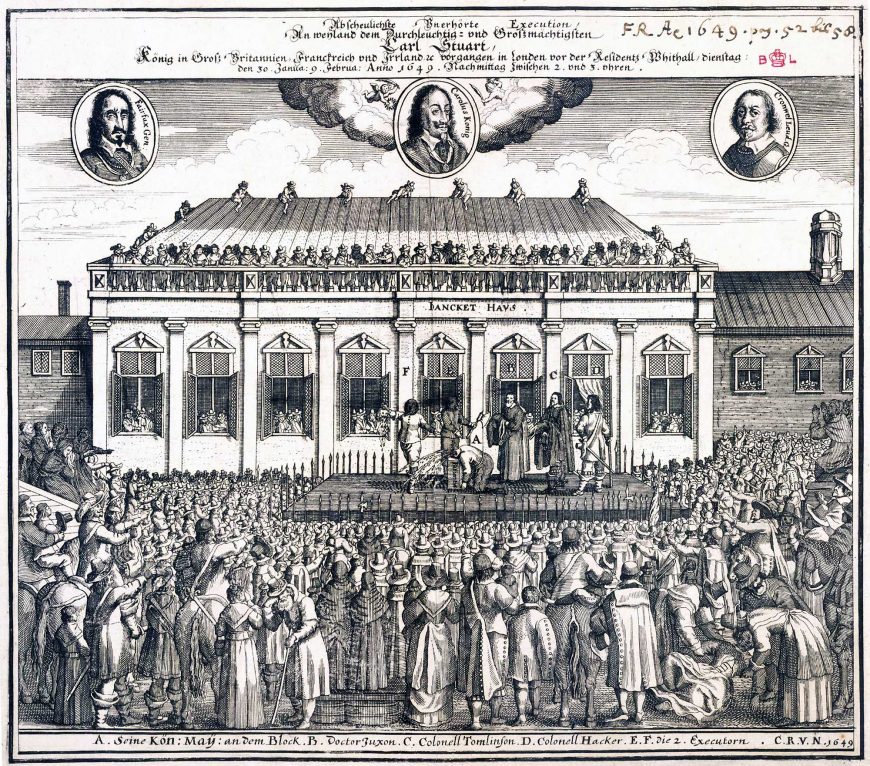
On January 30th, 1649, King Charles I was beheaded on a scaffold in front of the Banqueting House of Whitehall Palace in London for raising taxes without due authority and waging wars against his own people. It was an ironic backdrop for his death, as the Banqueting House was created to glorify his reign and that of his father, King James I of England. Designed by the architect Inigo Jones and decorated with paintings by the Baroque painter Peter Paul Rubens, this building symbolized the newly vibrant, lavish, and European-influenced court culture that the two monarchs fostered.
A new era for Shakespearean England
James VI of Scotland assumed the English throne upon the death of Queen Elizabeth I in 1603, becoming James I and ushering in what is known as the Jacobean era. Upon his accession, the Britain of multiple kingdoms (England, Wales, Scotland, and Ireland), was born.
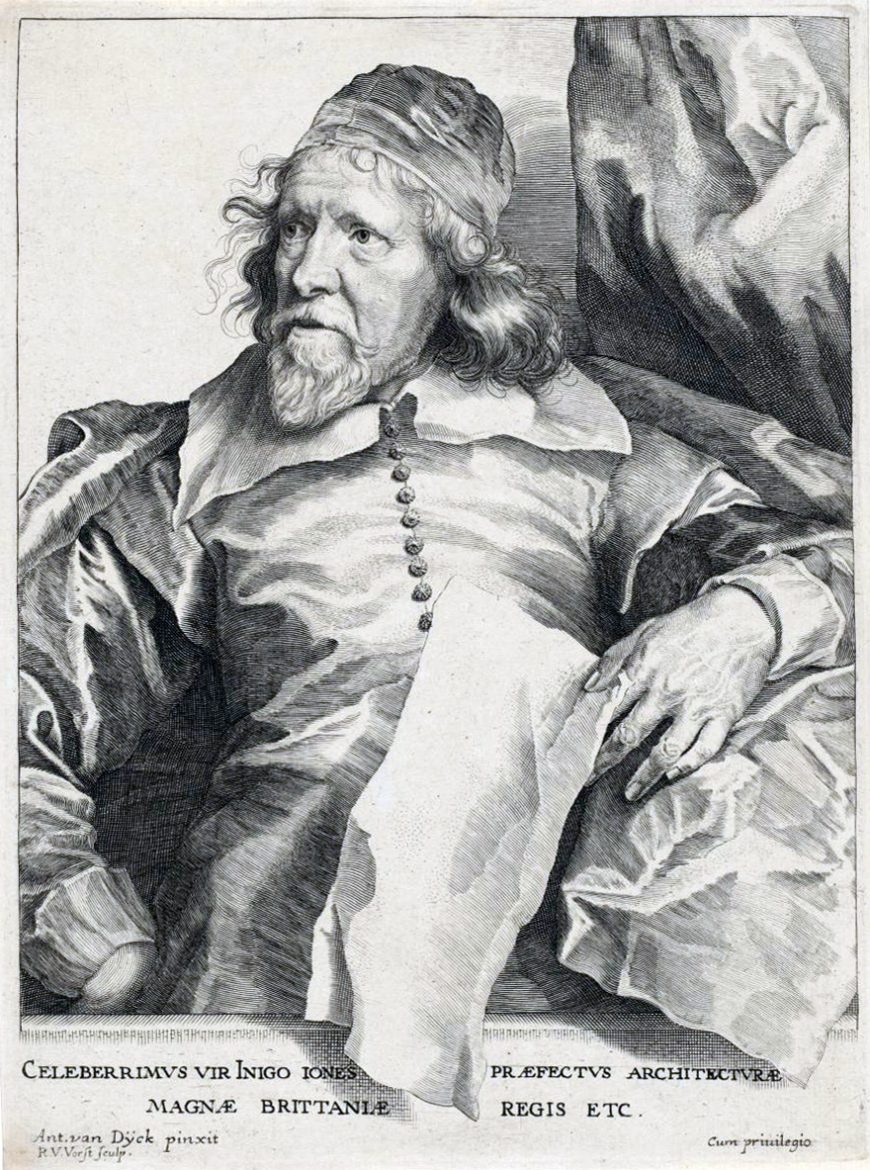
James I was widely criticized by his contemporaries, not only for his near-catastrophic financial mismanagement, but also for his publicly embarrassing over-indulgences. However, despite these shortcomings, James was a monarch with a great interest in the arts and a serious scholarly mind: his reign witnessed the production of some of William Shakespeare’s most brooding tales of kingship, such as Macbeth and King Lear, as well as the publication of the King James Bible. James himself also published many works, including treatises that set forth his views on kingship (encapsulated in the famous phrase “God’s lieutenant upon earth”—i.e. God’s direct representative). Jacobean Britain was a politically charged, intellectually stimulating age with a luxurious court culture. It was in this context that the classical architectural tradition was brought from continental Europe, under the direction of Britain’s first classical architect, Inigo Jones.
Surveyor-General of the King’s Works
Inigo Jones was the foremost architect and theatre designer of the first half of the seventeenth century. Of humble origins and largely self-taught, Jones acquired his matchless understanding of classical architecture by studying the writings of Italian renaissance architects, including Sebastiano Serlio, Andrea Palladio, and an Italian translation of the work of the ancient Roman architect Vitruvius. He also had first-hand experience of these ideas from his travels to Italy and France and conversations with Palladio’s pupil Vincenzo Scammozzi.
On his return to England in 1615, Jones assumed the title of “Surveyor-General of the King’s Works,” under which he oversaw the maintenance of existing buildings and the construction of new ones. This signaled a fundamental change in the architectural landscape of London and its environs, initiated through the construction of one of Britain’s first truly classical buildings, the Banqueting House at Whitehall Palace.
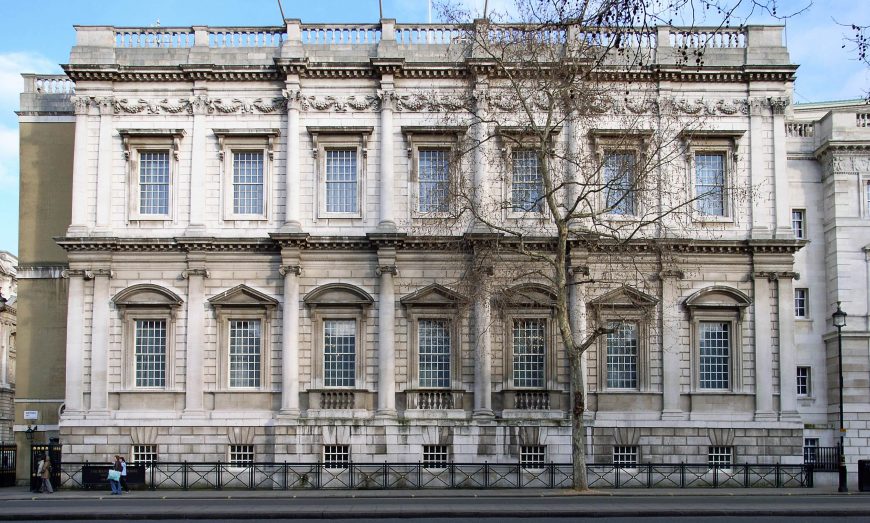
The Banqueting House
In the Jacobean era, Whitehall Palace was the principal royal residence, and the Banqueting House was regarded as the “Presence Chamber,” where the king would receive visiting ambassadors and hold ceremonies such as masques and state banquets. When the first iteration of the hall burned down in 1619, “Surveyor” Inigo Jones swiftly began work on the new building. Based loosely on a palace in Vicenza, Italy, Jones’s building testifies to his understanding of classical architecture as it had been revived in Renaissance Italy.
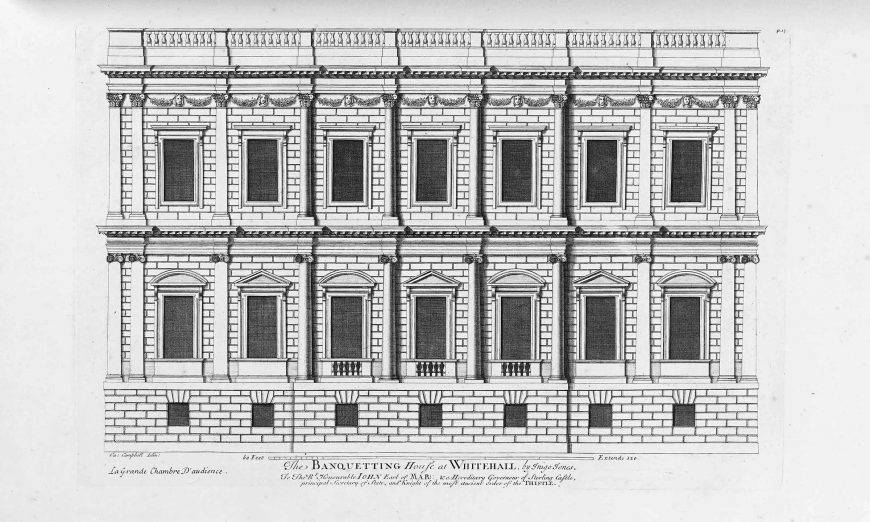
Seven windows wide, with three central bays, the exterior is a virtuoso exercise in balance, proportion and restrained decoration. The largely rusticated front was originally a mix of Oxfordshire (honey-coloured), Northamptonshire (pinkish), and Portland (white-grey) stone, though the façade we see today was re-faced in the early nineteenth century.
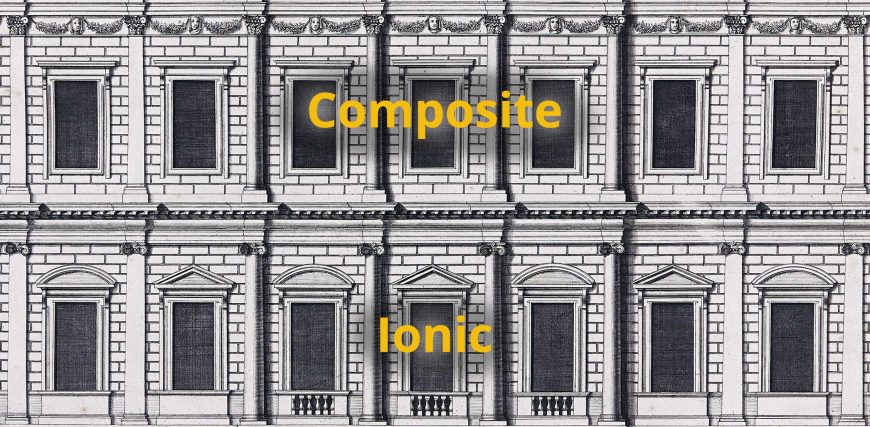
The façade is made up of two different classical orders (Ionic and Composite) on successive storeys. The three central bays are defined by engaged columns (half-embedded in the structure), with double pilasters at the ends of each storey of the façade. The windows of the lower storey are capped by alternating triangular and segmental (curved top) pediments, while there are straight lintels (horizontal beams that span openings) on the windows of the upper storey.
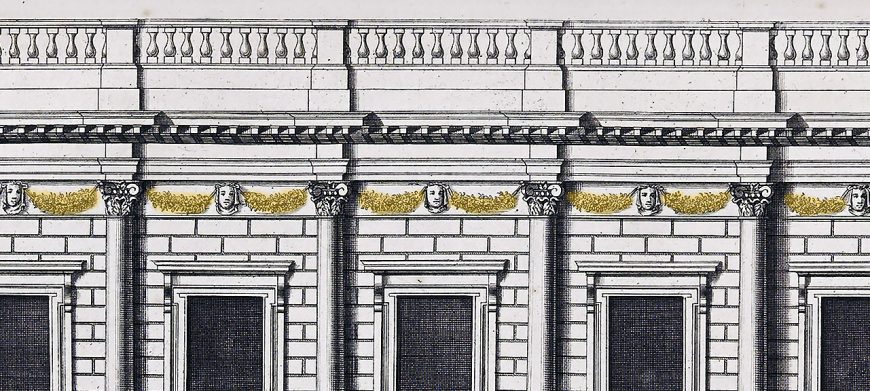
The only decorative extravagance on the whole façade is a garland frieze of female masks and swags of fruit that runs across the upper storey and ties the capitals together, above which stands a balustrade (a row of decorated uprights supporting a rail).
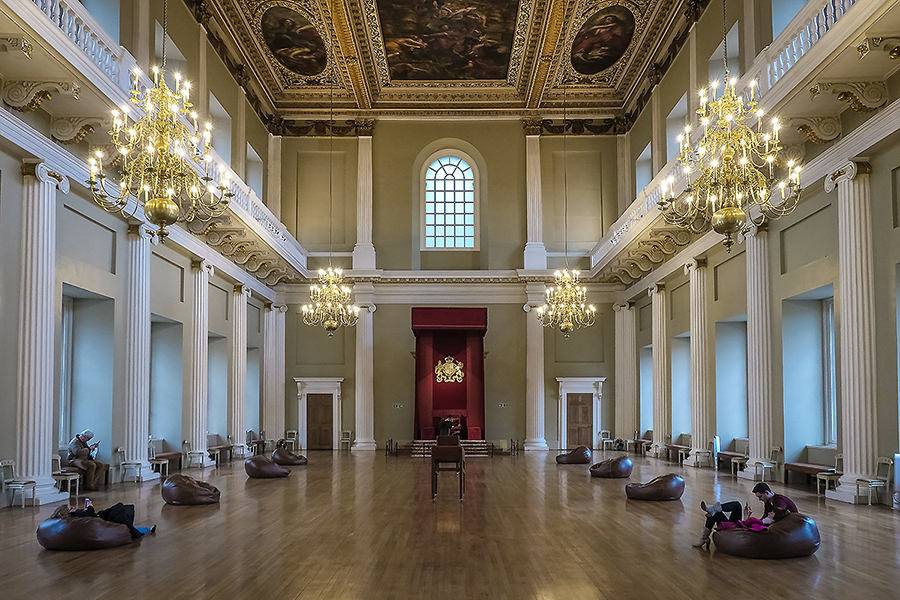
Following principles set down by Palladio and Vitruvius, the interior of the Banqueting House is a single space—a double cube in volume, measuring 110 x 55 feet—and is the height of the two main storeys of the exterior façade. The interior walls parallel the exterior in their use of the classical orders, with superimposed Ionic half-columns below and Corinthian pilasters above.
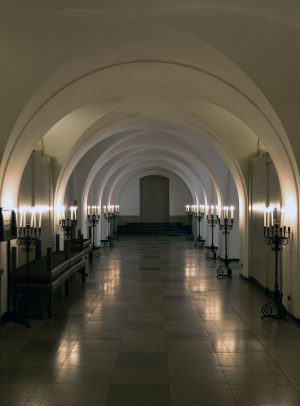
Below this room is the basement or “Undercroft,” which once housed the “King’s Privy Cellar,” a rock- and shell-decorated grotto that was used as a drinking den by James and his favorites.
Paintings fit for a king
On the flat-beamed, compartmentalized ceiling are the canvases by the Flemish artist Sir Peter Paul Rubens, the only such cycle by Rubens to survive in situ (the other monumental cycle he executed being the life of Marie de’ Medici at the Palais du Luxembourg, now on display in the Louvre, Paris). James had asked Rubens to decorate the ceiling; however, it was not until the reign of James’s son, Charles I, that the commission came about. The nine canvases were produced in the artist’s Antwerp studio with the help of a team of assistants, and installed at a height of 50 feet (15.3 meters) in 1636, after which time—on the express orders of the king—no more court masques took place, in order to protect Rubens’s panels from smoke damage from lighted candles. Visitors today can view the paintings with the aid of mirrors and from the comfort of body-sized beanbags (see image above).
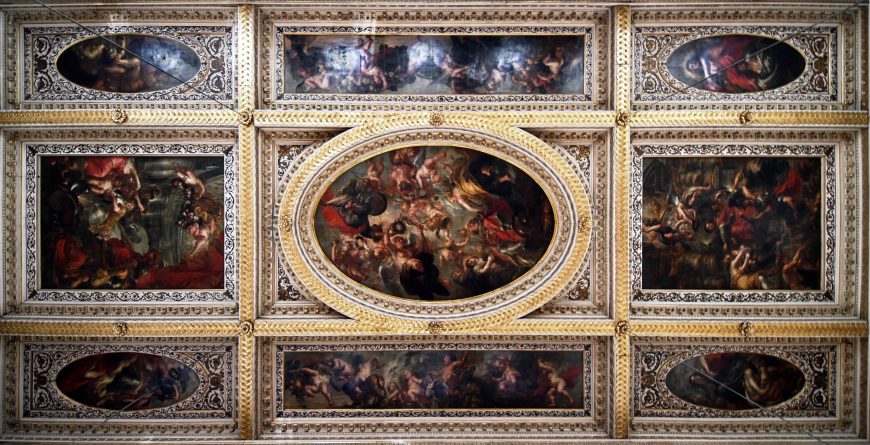
The canvases should be viewed as a propagandistic commemoration and celebration of the reign of Charles’s father, as well as a forceful representation of the political ideology of the divine right of kings and James’s notion of himself as “God’s lieutenant upon earth.”
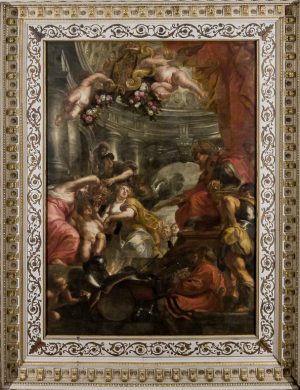
The Union of the Crowns of Scotland and England at the north end portrays the union between the crowns of Scotland and England through the accession of James VI of Scotland to the throne of England as King James I. Wearing an imperial crown and attired in parliamentary robes, an enthroned James leans forward, his left hand resting on an orb, while in his right hand he points with his scepter, commanding the goddess Minerva to join the crowns of the two kingdoms held by the personifications of Scotland and England over the head of an infant, who may represent the Prince of Great Britain, the future King Charles I, or possibly Cupid.
The oval panels to either side depict the triumph of the Virtues over the Vices: on the left, Hercules (Heroic Virtue) slays Envy (or Rebellion) with a club, while on the right Minerva (or Wisdom) spears Ignorance.
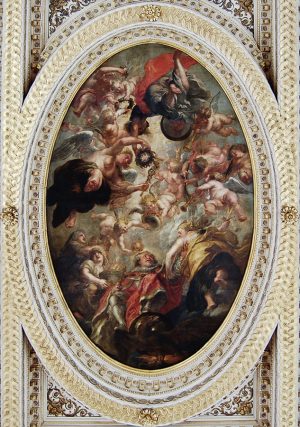
The central oval panel of The Apotheosis of James I is a flurry-some swirl of figures in which an airborne James, scepter in his right hand, his left foot resting on an imperial globe, is heralded heavenwards as “King of Great Britain” on the wings of Jupiter’s great eagle, accompanied by the yellow-garbed figure of Justice. To the left are the female figures of Piety or Zeal and Religion, while above the triumphal crown is carried by the goddess Minerva and a figure representing Victory or Peace.
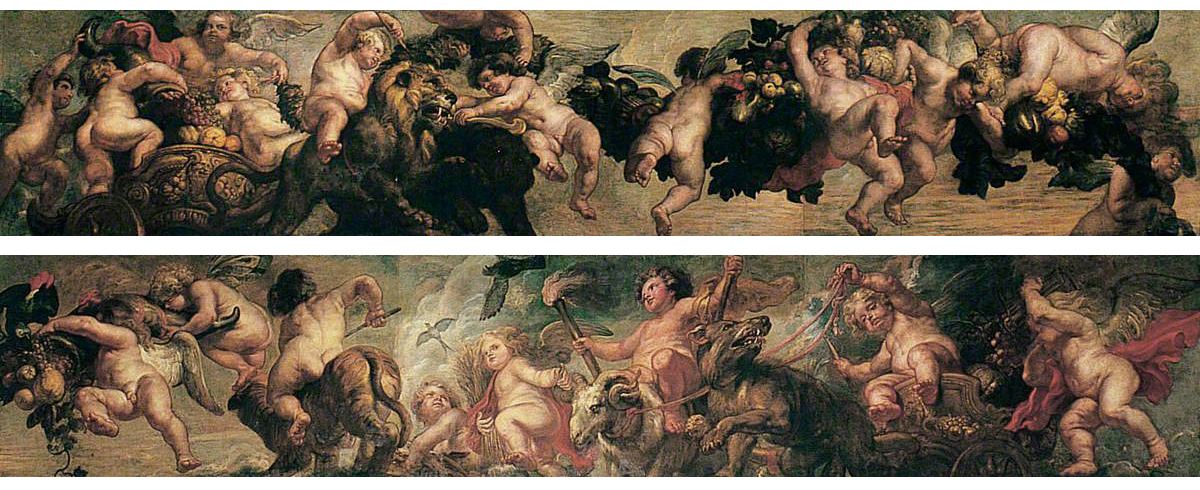
On either side are long rectangular panels that celebrate the peacefulness and bountifulness of the Jacobean reign: on the left (the west side), frolicking Genii or Putti load a cornucopia of fruit onto a chariot led by a lion and a bear; and on the right (the east side), a procession of Genii or Putti (cherubs) with a fruit-laden chariot driven by a ram and a wolf are depicted.
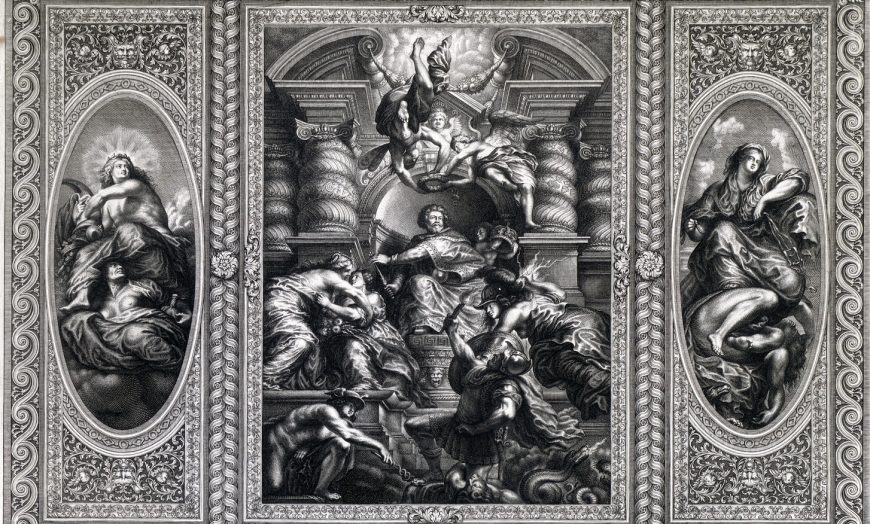
In The Peaceful Reign of James I at the south end, above the dais where the monarch would sit, James is depicted as a latter-day King Solomon (the king of Israel who is traditionally associated with virtue and wisdom) seated within a biblically-inspired architectural setting of two large Solomonic “barley sugar” columns. James is presented with the laurels of victory by two winged figures descending from the heavens. To the left, the personifications of Peace and Plenty embrace one another, while to the right, Minerva, wearing a helmet and holding a shield and the thunderbolts of Jupiter, puts down the red-caped figure of Mars. In the left foreground, Mercury holds out his caduceus around which two snakes entwine, symbolizing peace.
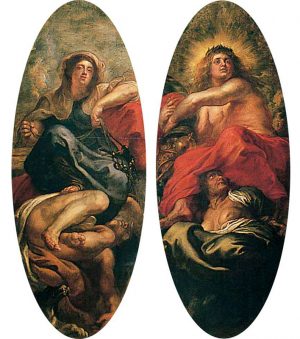
The oval canvas to the left of this painting portrays Reason (or Wise Government), who bridles Intemperance, while the canvas on the right depicts Abundance (or Royal Bounty), holding a cornucopia, who triumphs over Avarice (Greed).
Spectacle on the scaffold
It is no small dramatic irony that the building presenting James VI of Scotland and James I of England as “God’s lieutenant upon earth” served as the backdrop to the stage for the execution of his son. The spilling of the blood of Charles I significantly stunted the development of the European-influenced court culture that the Jacobean age had done so much to usher in. It would not be until the early eighteenth century that classical architecture would again take hold in Britain.
Additional Resources
The Banqueting House on Historic Royal Palaces
Drawing of Rubens’s ceiling paintings by Simon Gribelin, 1720, on the Google Art Project
Drawings of Rubens’s ceiling paintings from the Royal Collection, UK
Christy Anderson, Inigo Jones and the Classical Tradition (Cambridge: Cambridge University Press, 2008).
Colen Campbell, Vitruvius Britannicus: The Classic of Eighteenth-Century British Architecture (London: Dover, 2007 [1715–1725]).
Fiona Donovan, “Rubens, Sir Peter Paul (1577–1640),” Oxford Dictionary of National Biography (Oxford University Press, 2004; online edn.)
Fiona Donovan, Rubens and England (New Haven and London: Yale University Press, 2004).
Vaughn Hart, Inigo Jones: The Architect of Kings (Studies in British Art) (New Haven and London: Yale University Press for the Paul Mellon Centre for Studies in British Art, 2011).
Linda Levy Peck, The Mental World of the Jacobean Court (Cambridge: Cambridge University Press, 2005).
Gregory Martin,, “The Banqueting House ceiling: two newly discovered projects,” Apollo, vol. 139 (February 1994), pp. 29–43.
Gregory Martin, The Ceiling Decorations of the Banqueting Hall (Corpus Rubenianum Ludwig Burchard), Part XV, 2 vols (London and Turnhout: Harvey Miller/Brepols Publishers, 2005).
Gregory Martin, Rubens in London: Art and Diplomacy (London and Turnhout: Harvey Miller/Brepols Publishers).
Oliver Millar, “Rubens’s Whitehall Ceiling,” The Burlington Magazine, vol. 149, no. 1247, Flemish and Dutch Art, (February 2007), pp. 101–104.
Oliver Millar, “The Whitehall Ceiling,” The Burlington Magazine, vol. 98, 1956, pp. 258–257.
John Newman, “Jones, Inigo (1573–1652),” Oxford Dictionary of National Biography (Oxford University Press, 2004; on-line edn).
Pier Palma, Triumph of Peace: A Study of the Whitehall Banqueting House (Stockholm: Almqvist, 1956).
Roy Strong, Britannia Triumphans: Inigo Jones, Rubens and Whitehall Palace (Walter Neurath Memorial Lecture) (London and New York: Thames and Hudson, 1981).
John Summerson, Inigo Jones, with a foreward by Howard Colvin, New Haven and London: Yale University Press for The Paul Mellon Centre for Studies in British Art, 2000.
Simon Thurley, Whitehall Palace: an architectural history of the royal apartments, 1240–1698 (New Haven and London: Yale University Press, 1999).
Jenny Wormald, “James VI and I (1566–1625),” Oxford Dictionary of National Biography (Oxford University Press, 2004; on-line edn.)
Giles Worsley, Inigo Jones and the European Tradition (New Haven and London: Yale University Press for the Paul Mellon Centre for Studies in British Art, 2007).
Smarthistory images for teaching and learning:




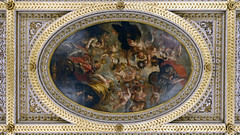
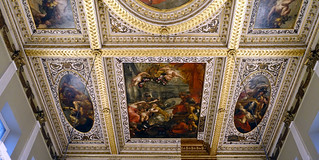
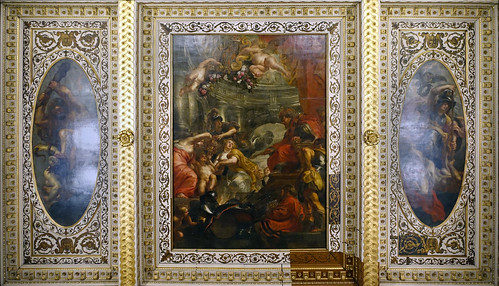

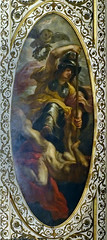


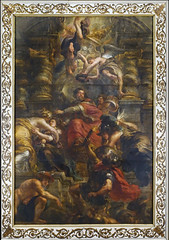


Wooldridge, Indians of Virginia
by DR. MINDY BESAW, CRYSTAL BRIDGES MUSEUM OF AMERICAN ART and DR. STEVEN ZUCKER
Video \(\PageIndex{29}\): James Wooldridge, Indians of Virginia, c. 1675, oil on linen, 75.6 x 108.6 cm (Crystal Bridges Museum of American Art), a Seeing America video Speakers: Dr. Mindy Besaw, Curator of American Art, Crystal Bridges Museum of American Art and Dr. Steven Zucker
Additional resources
This painting at the Crystal Bridges Museum of American Art
Smarthistory essay on the engravings of de Bry


